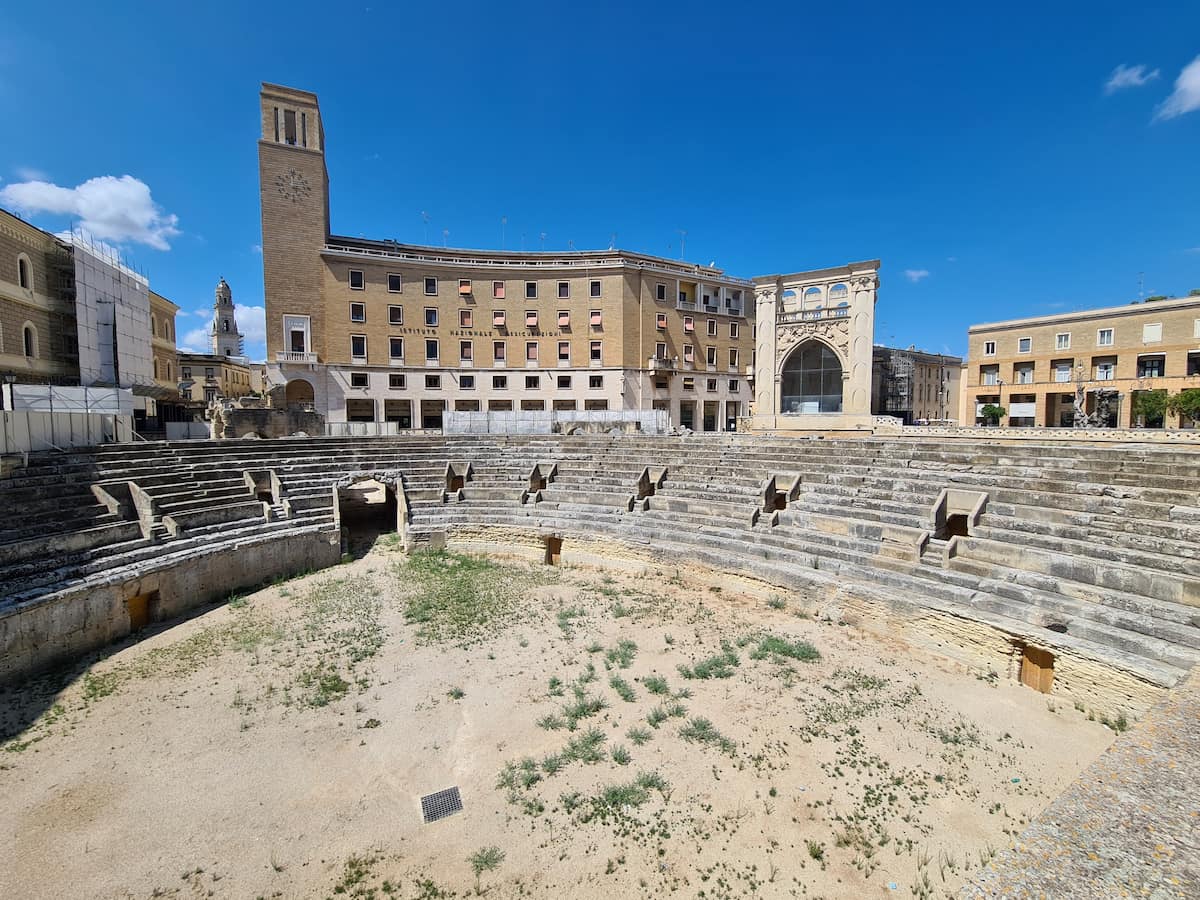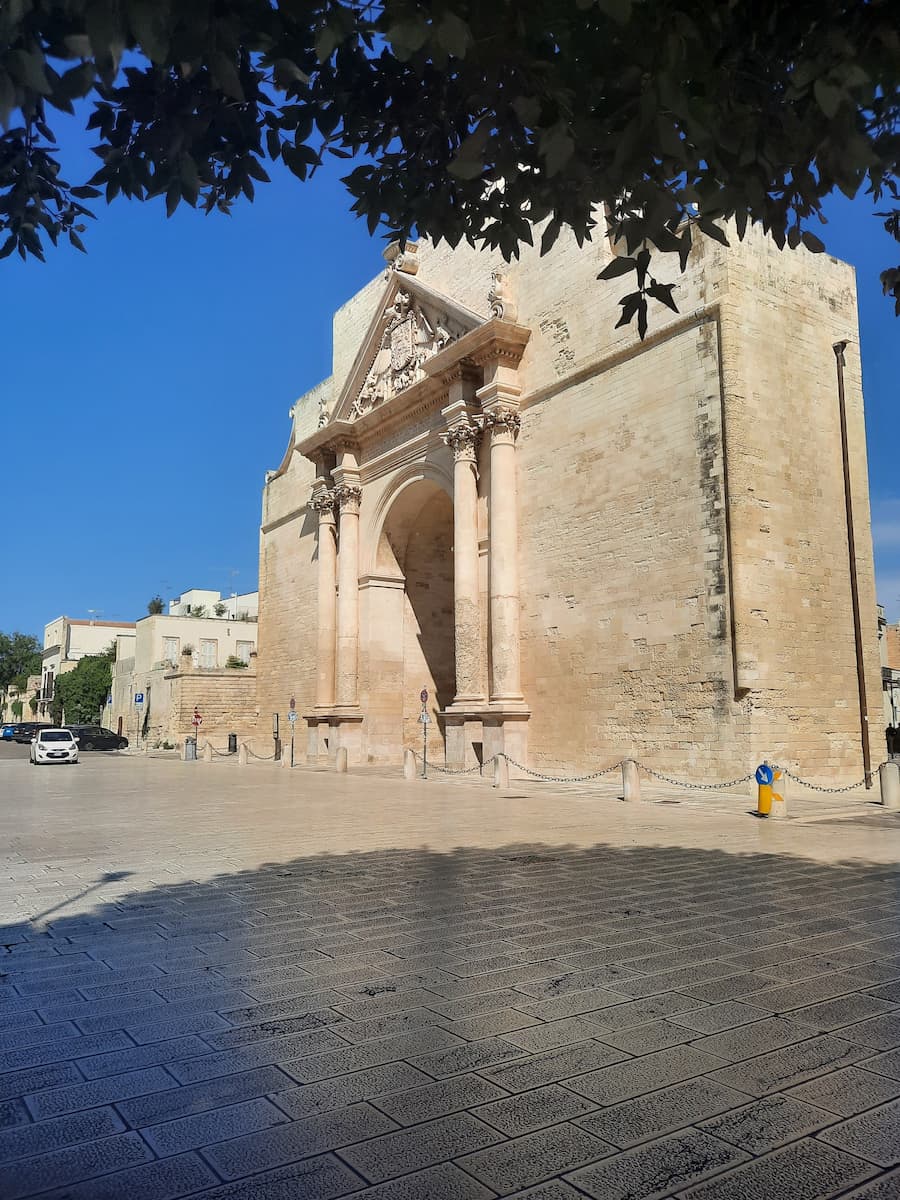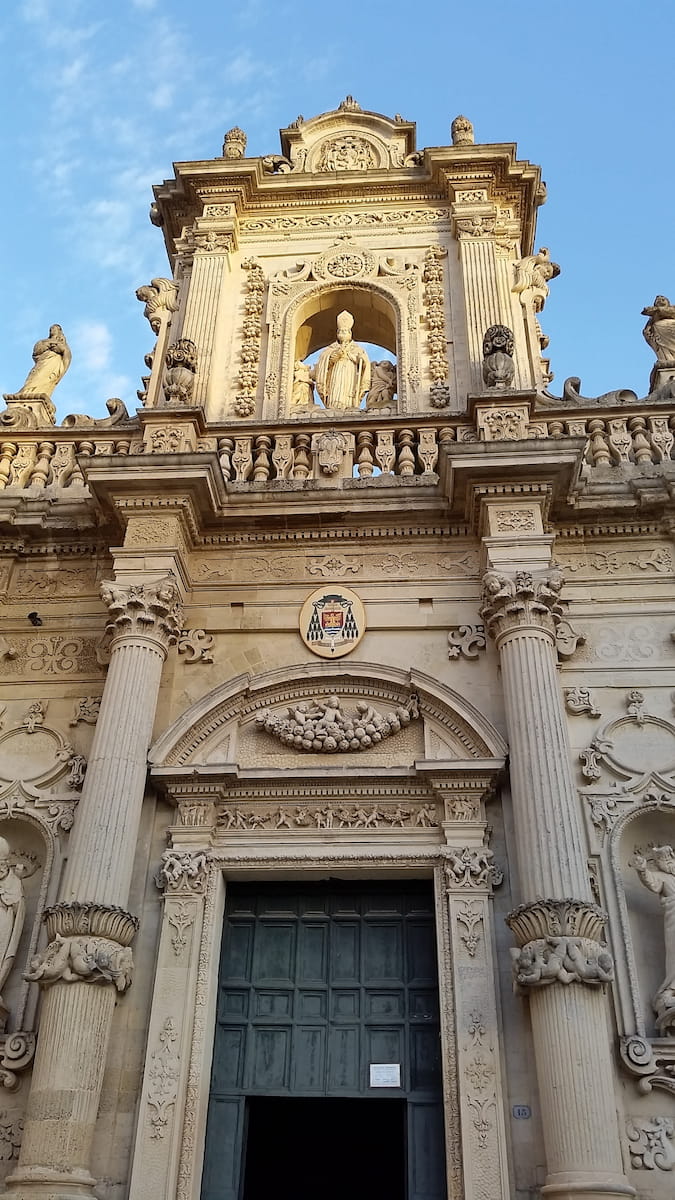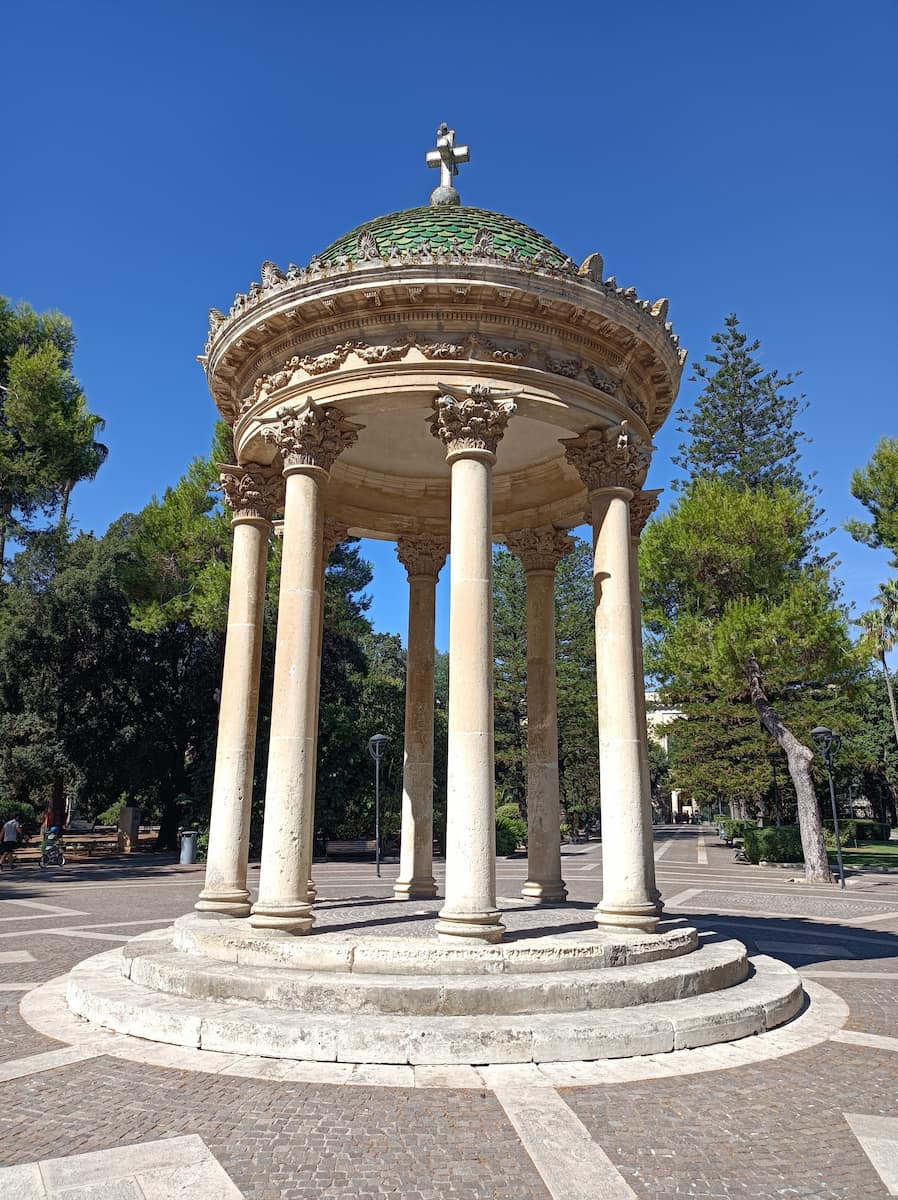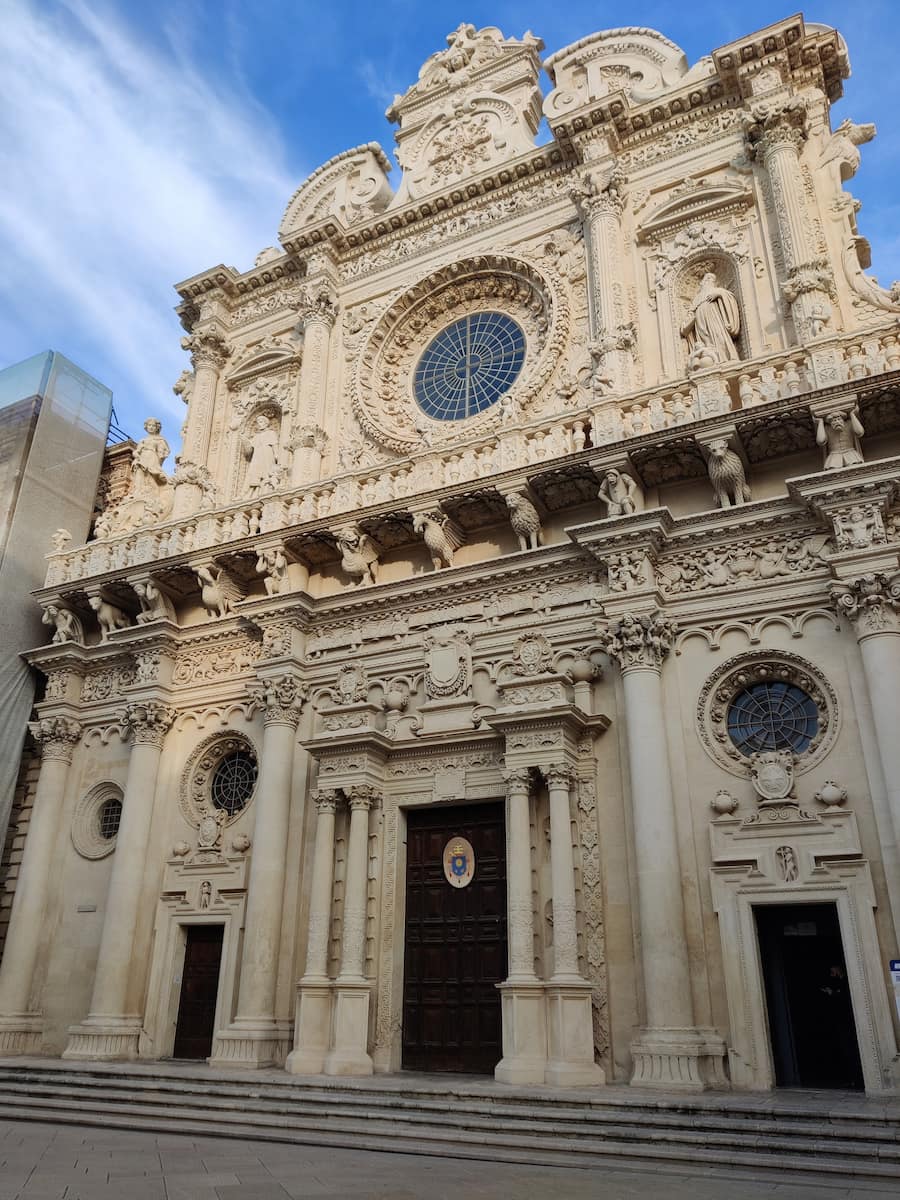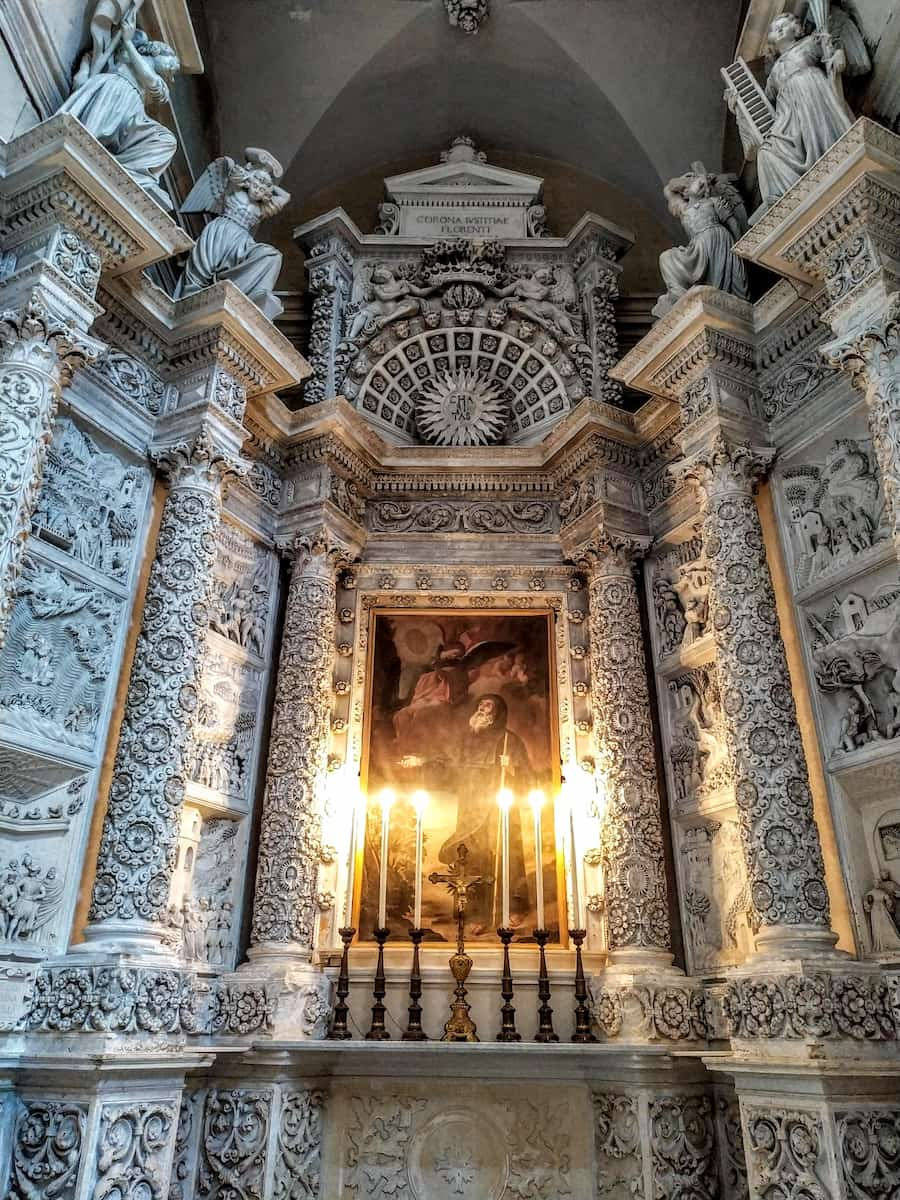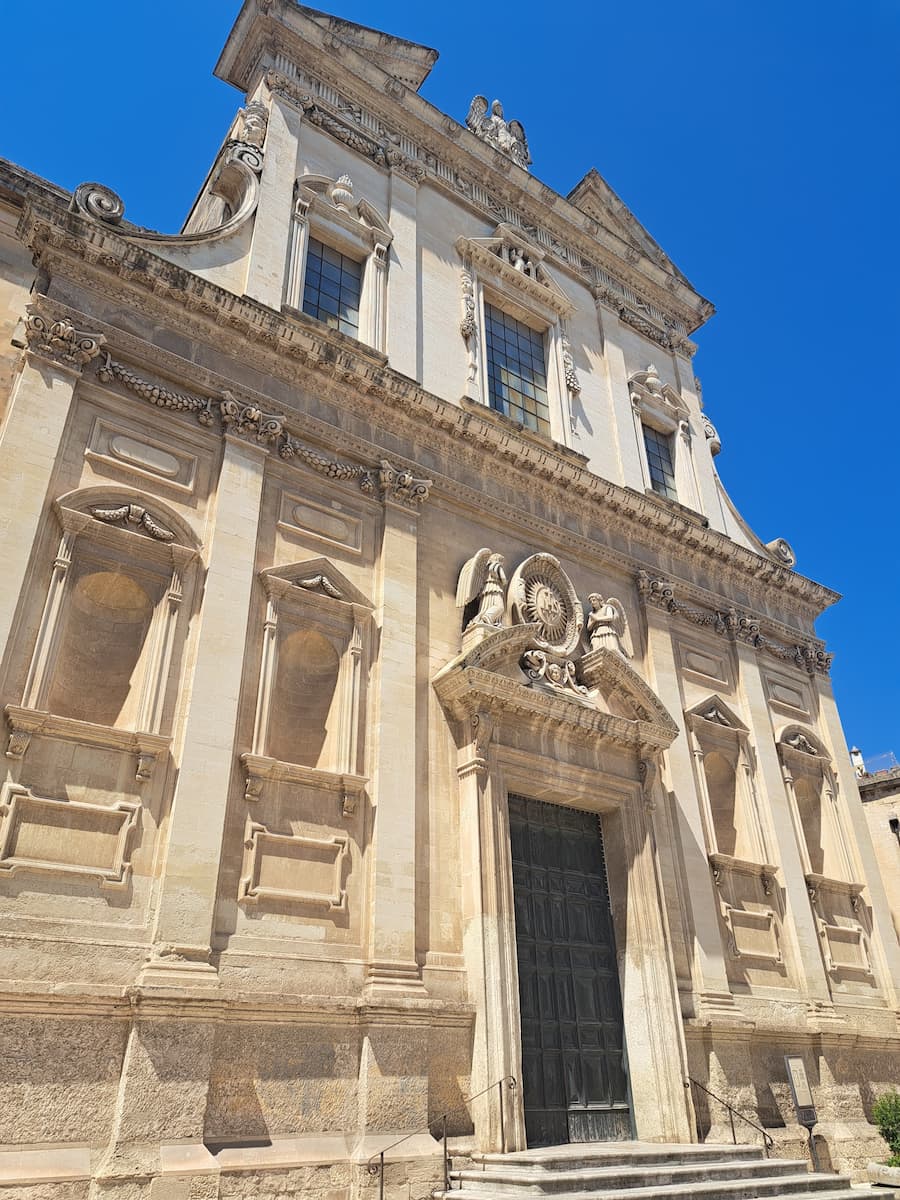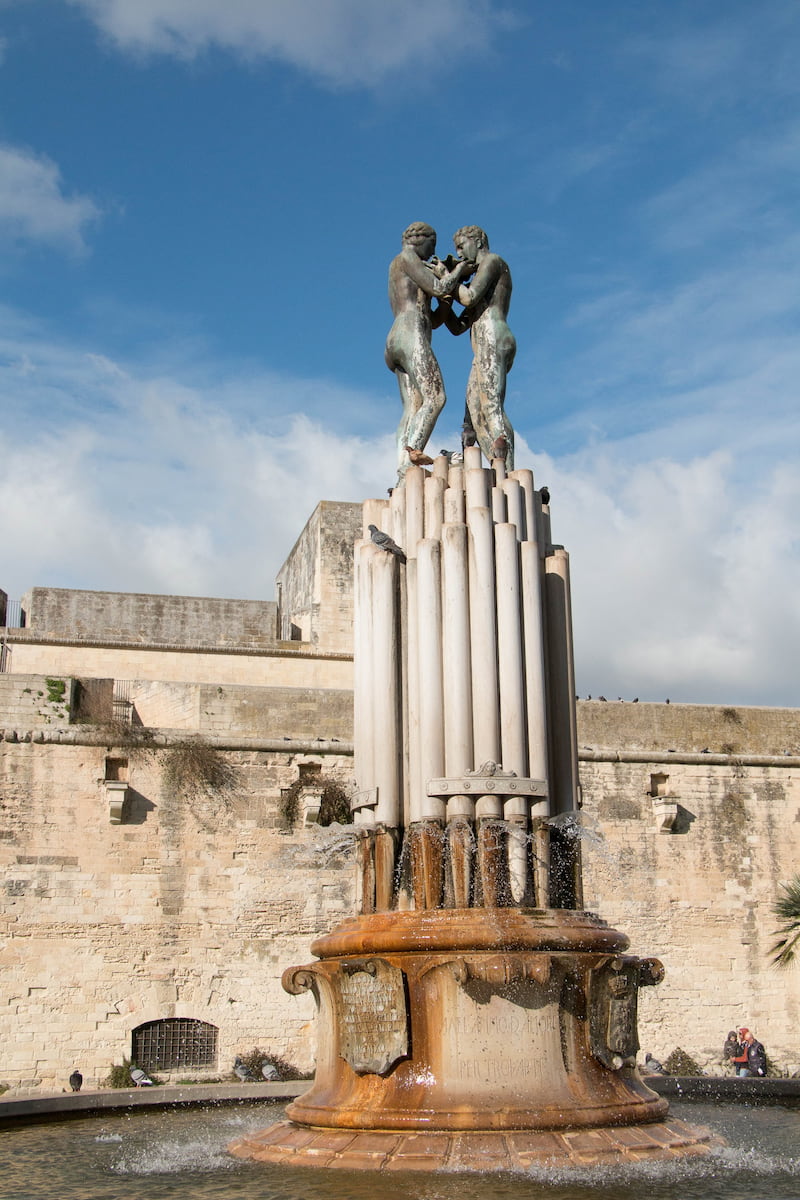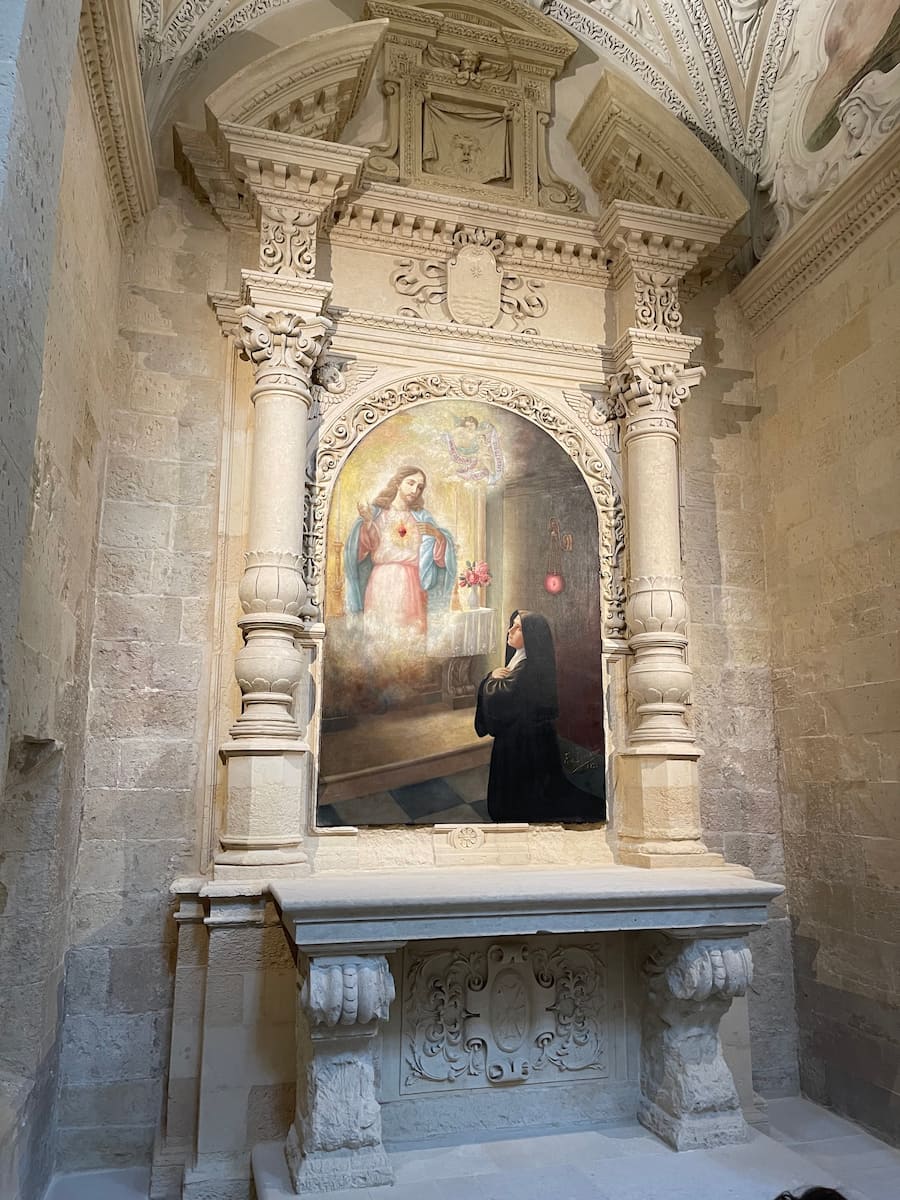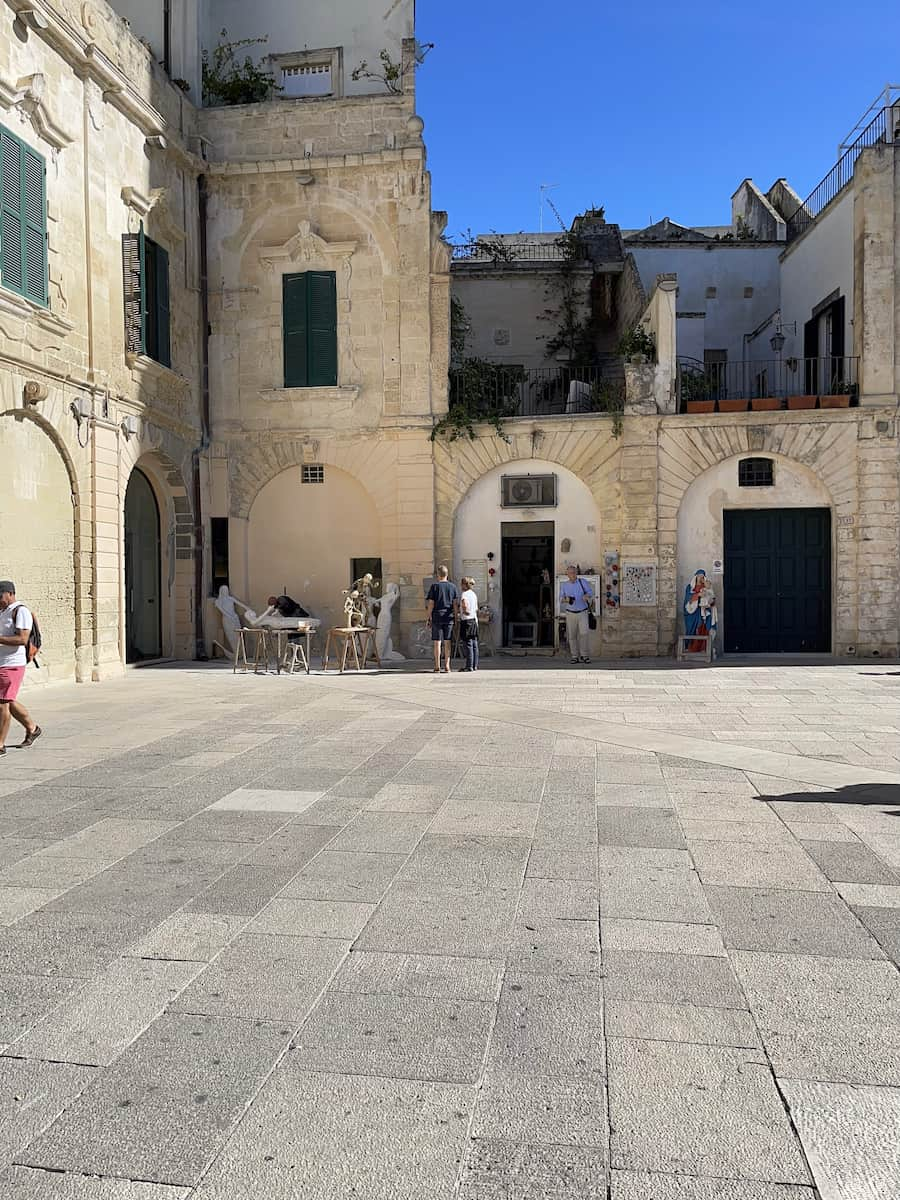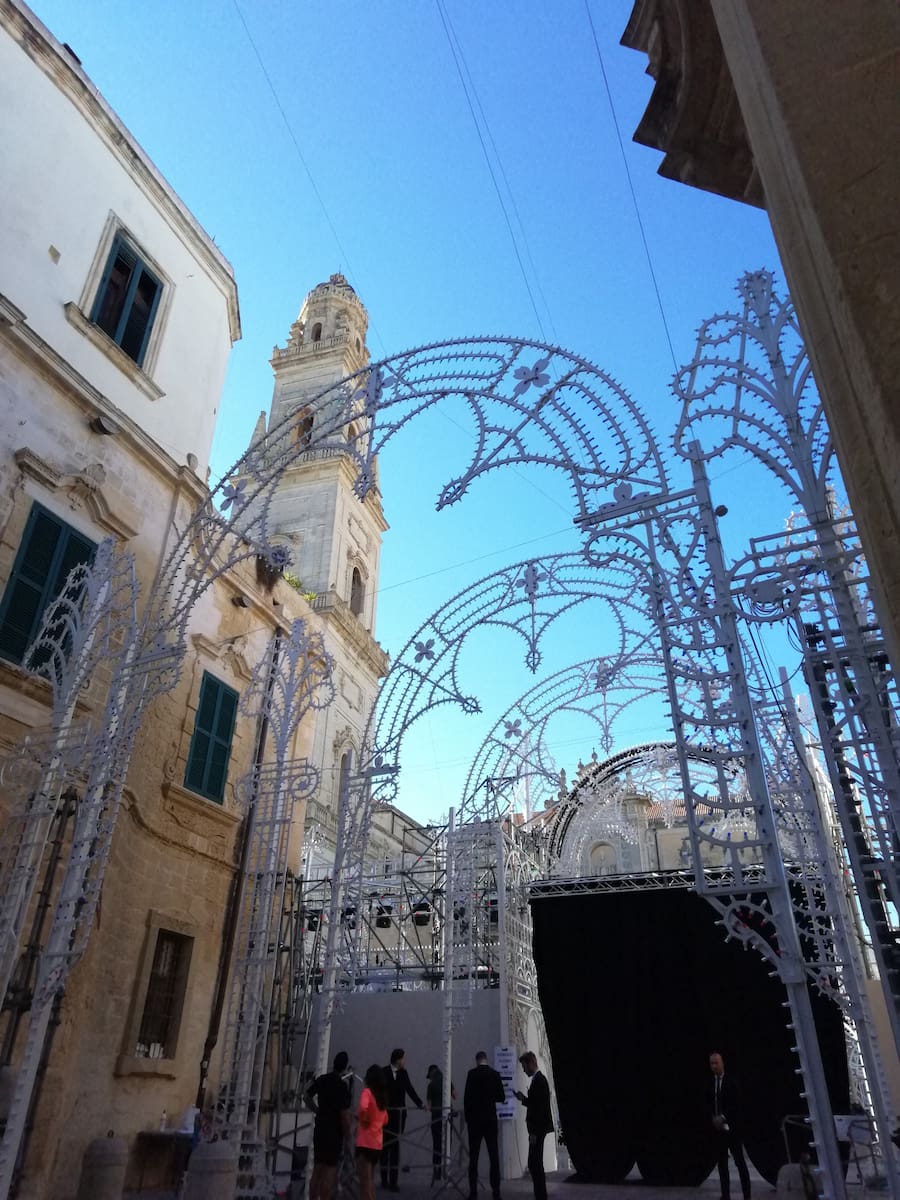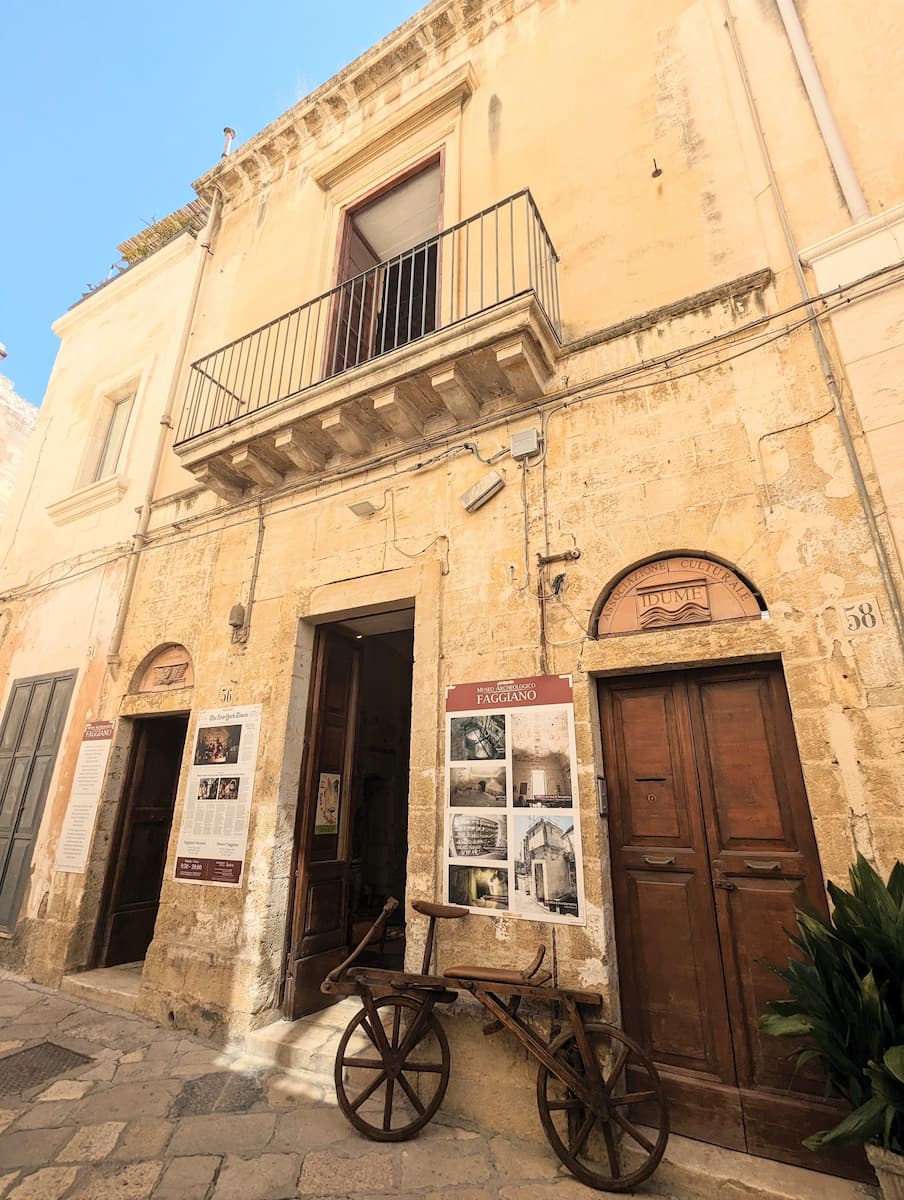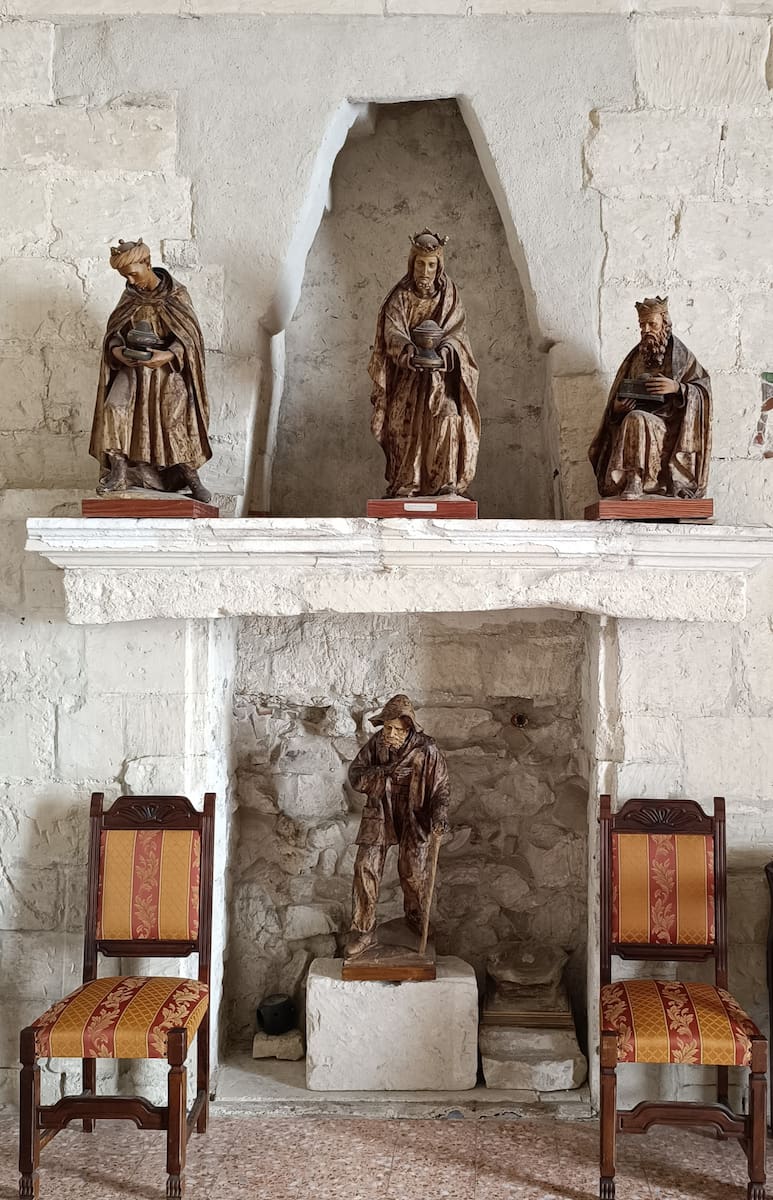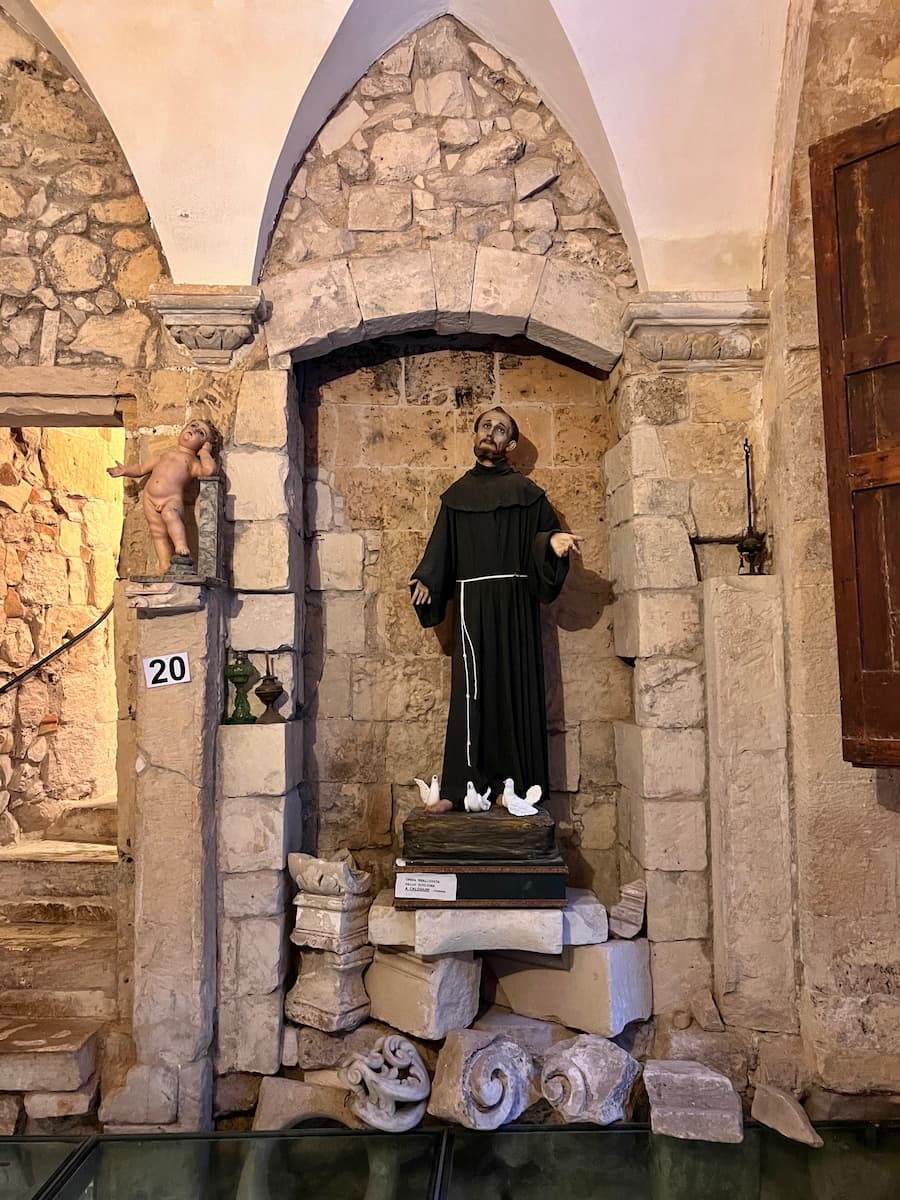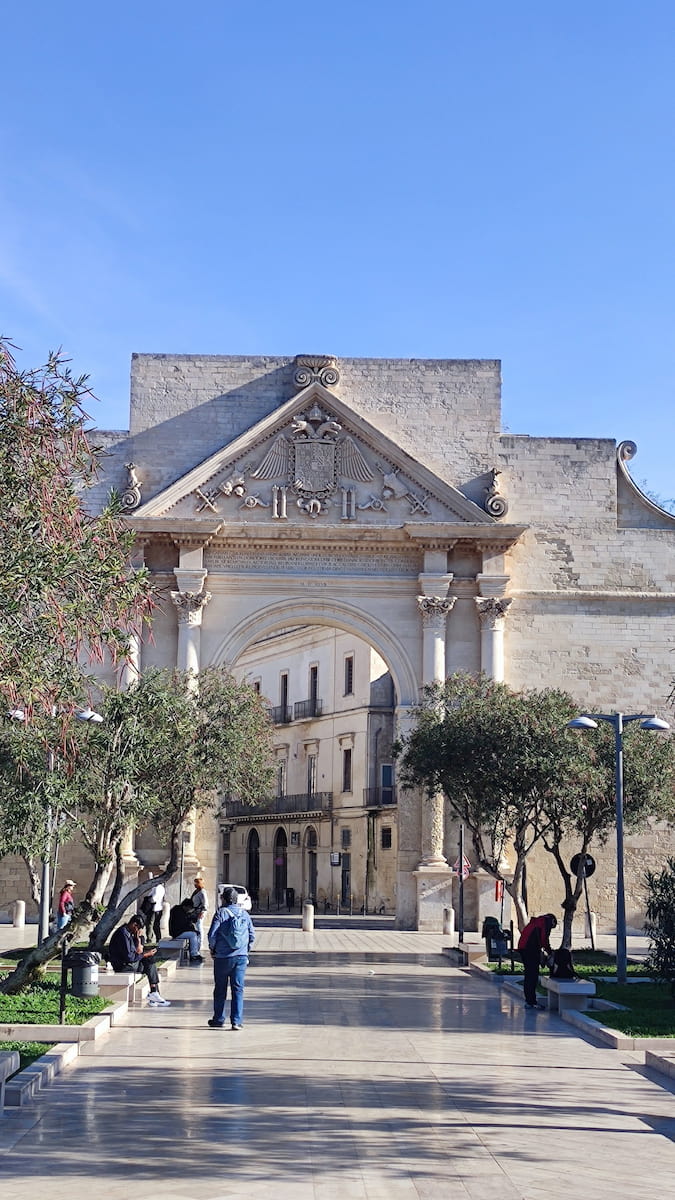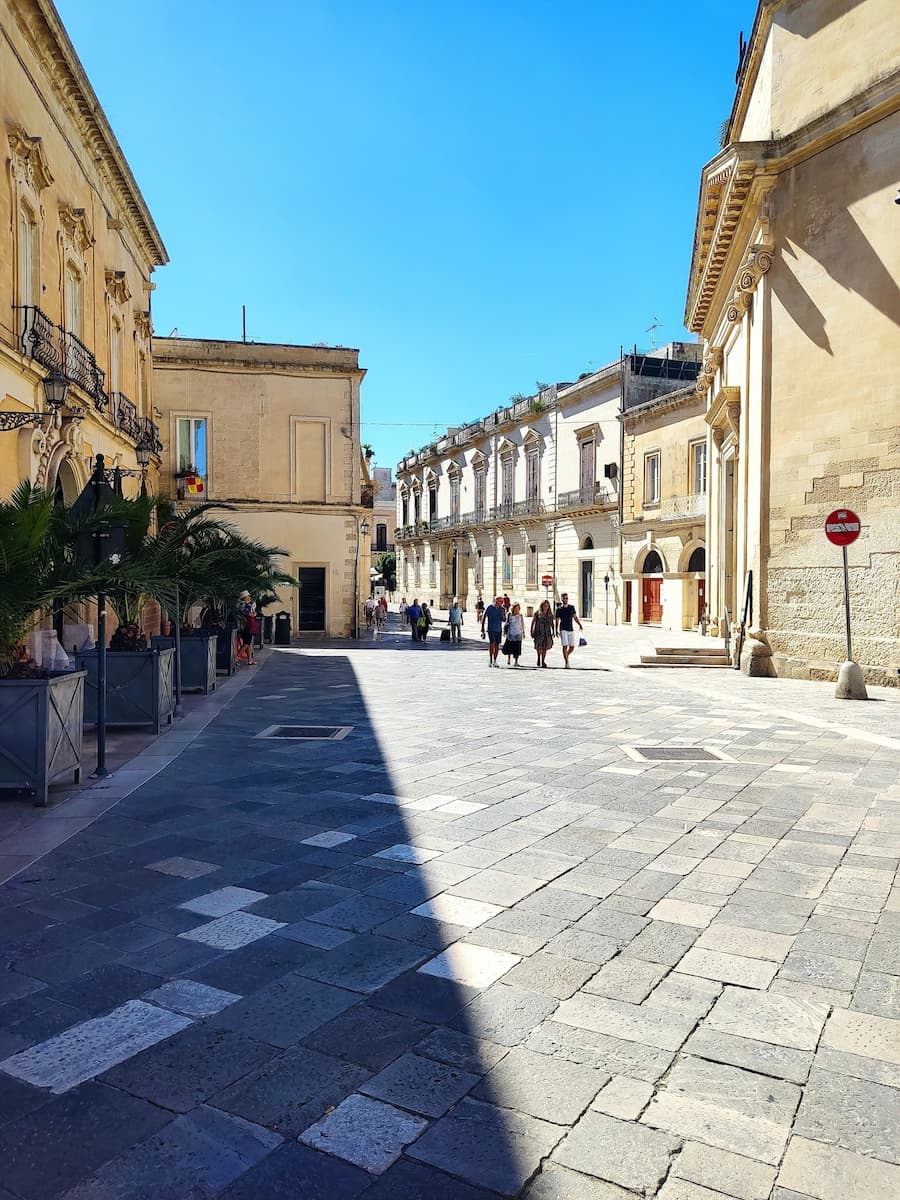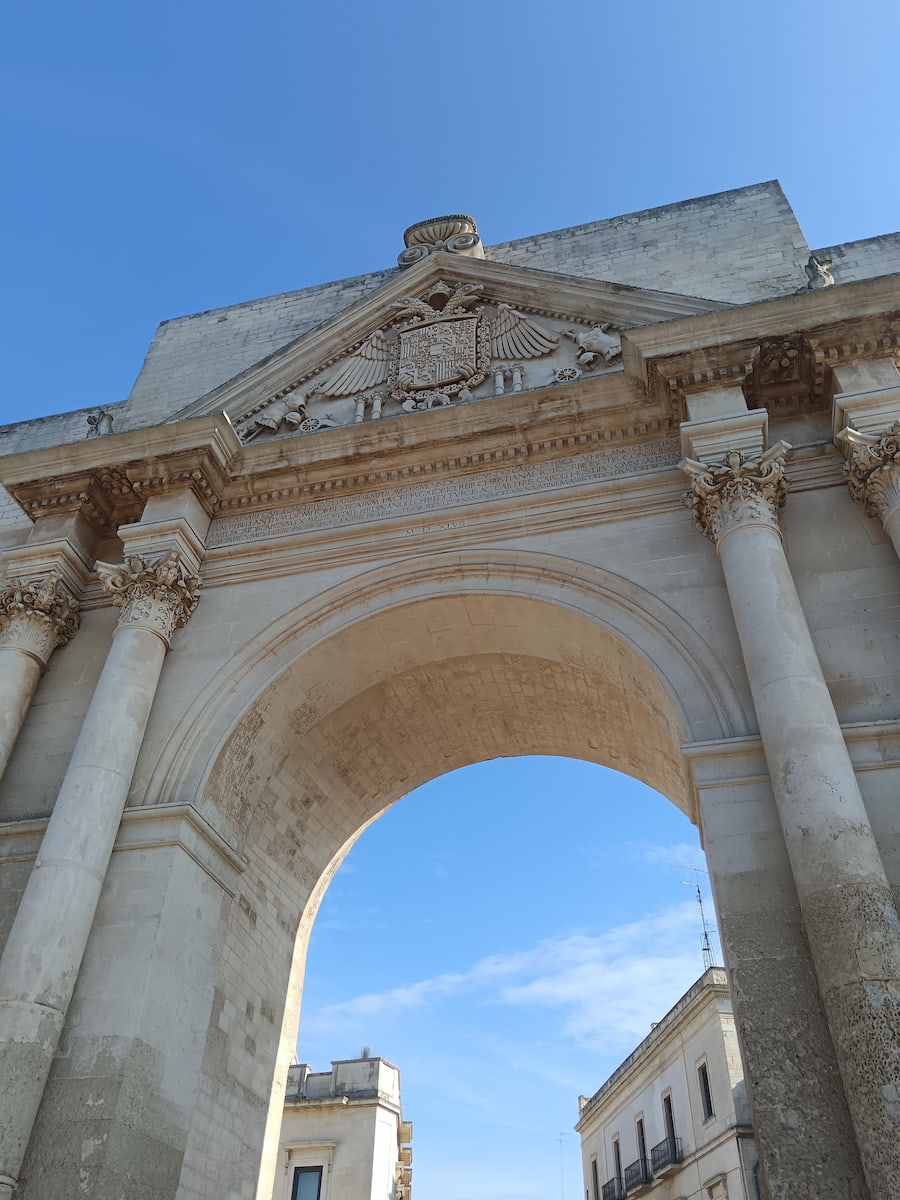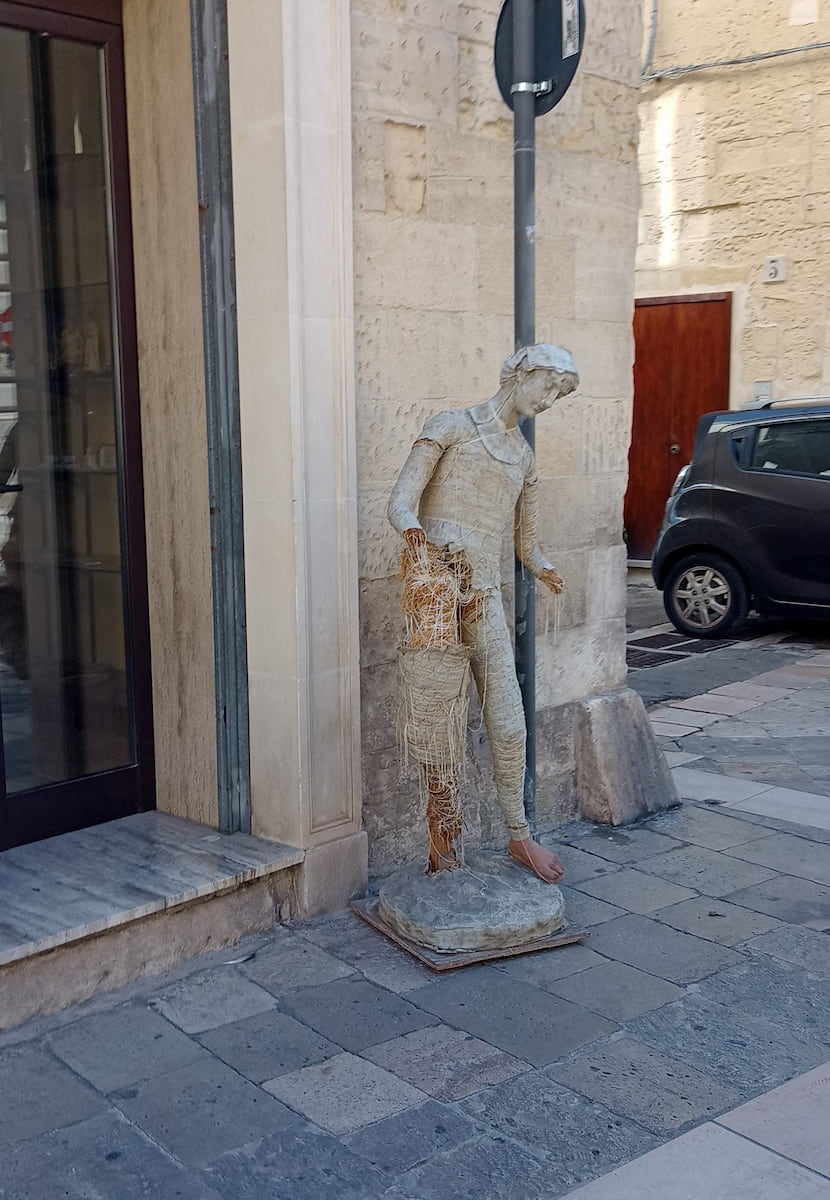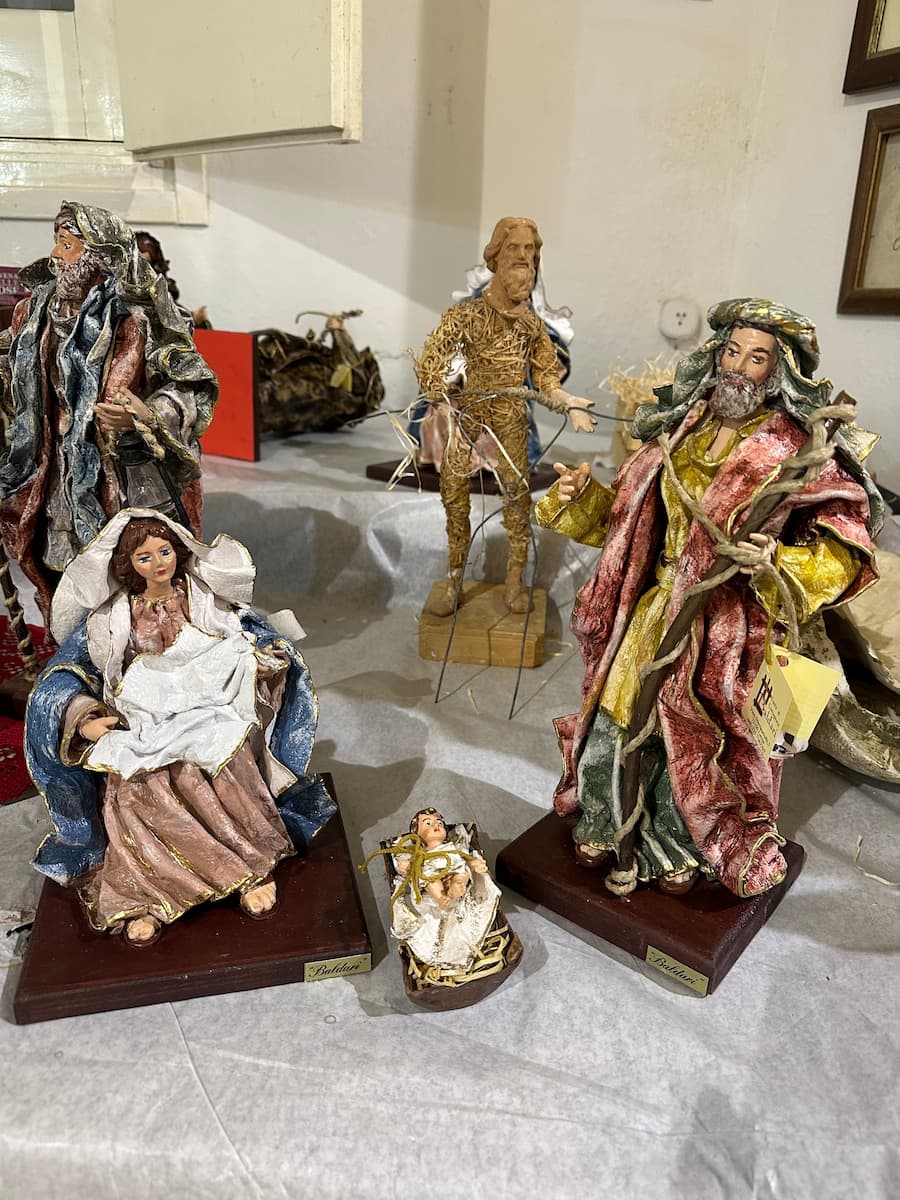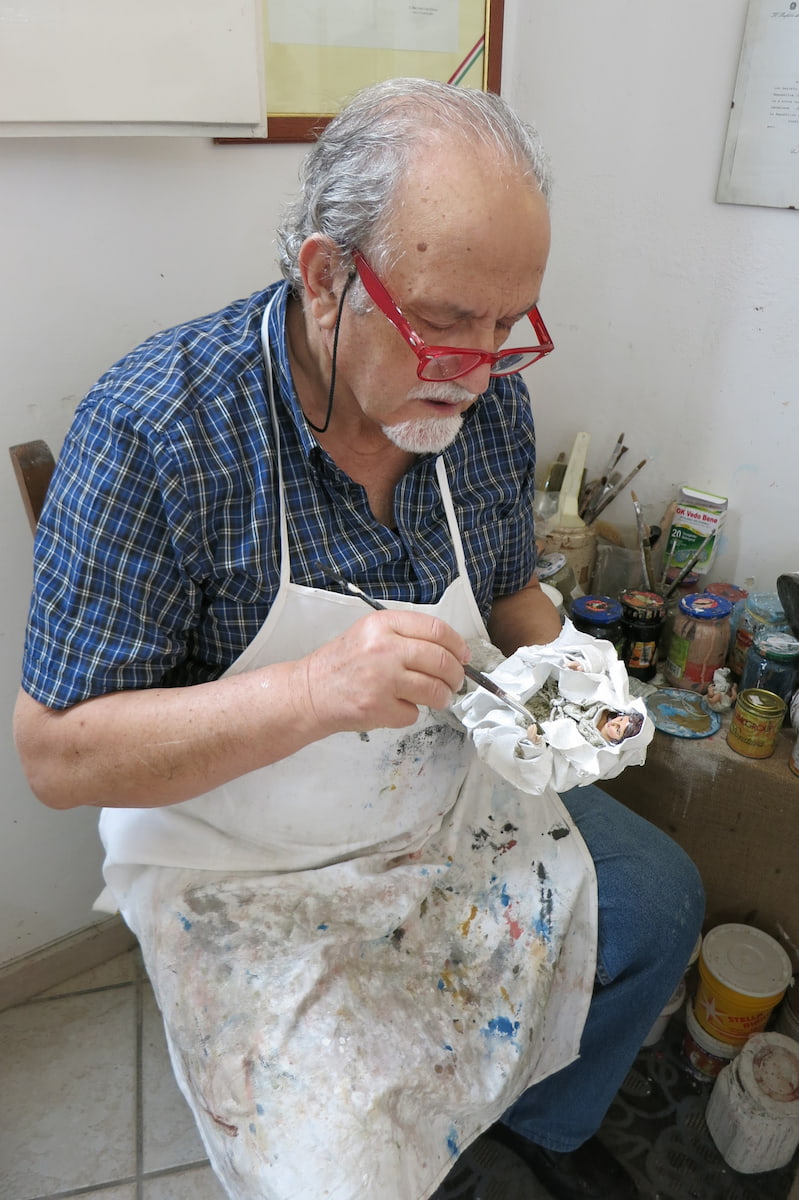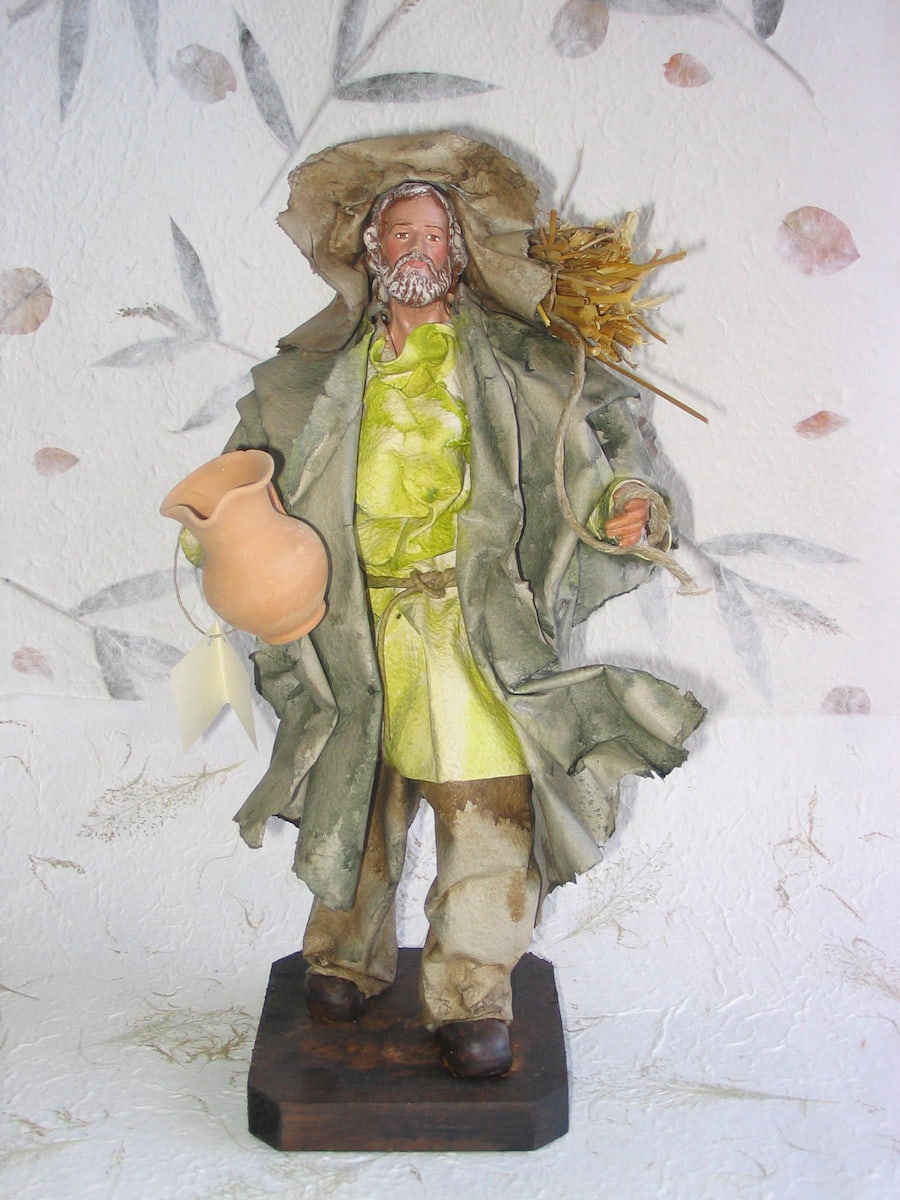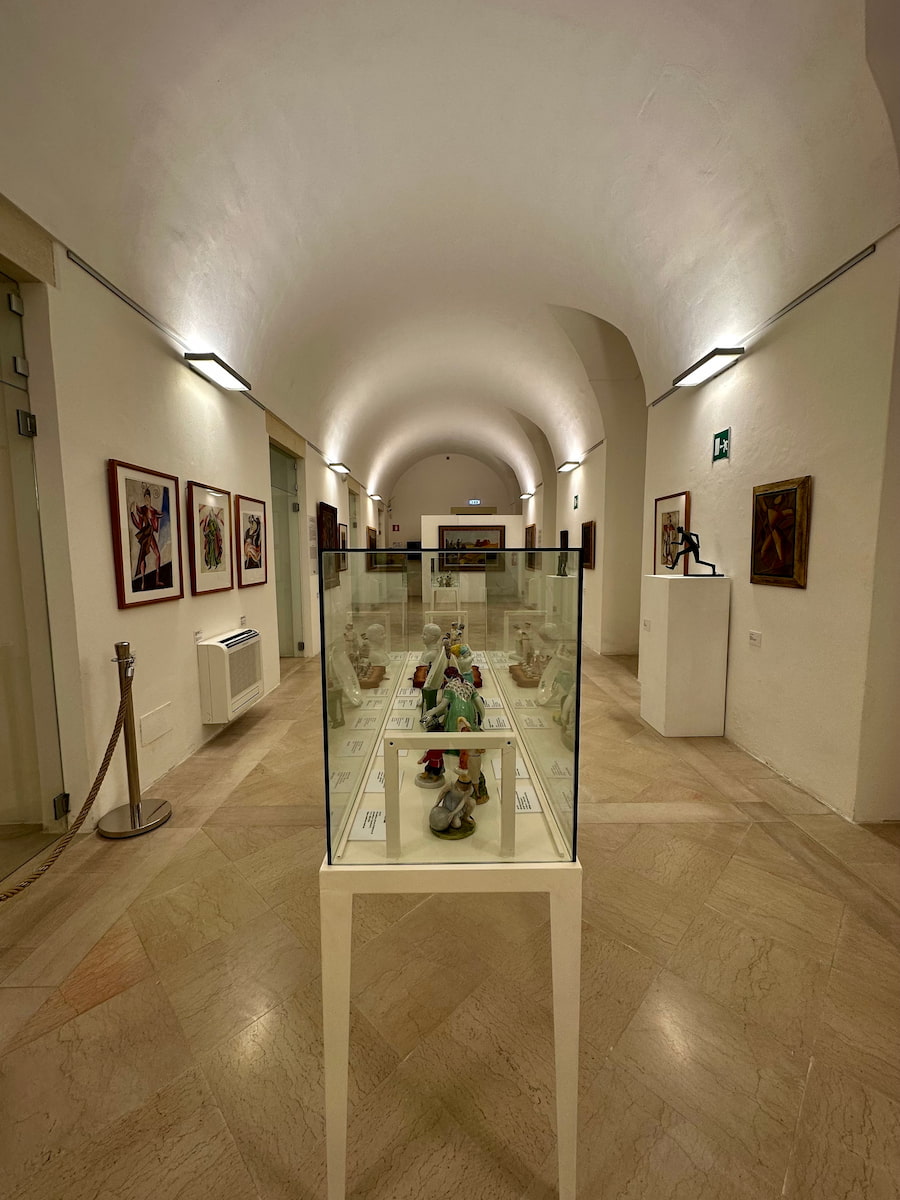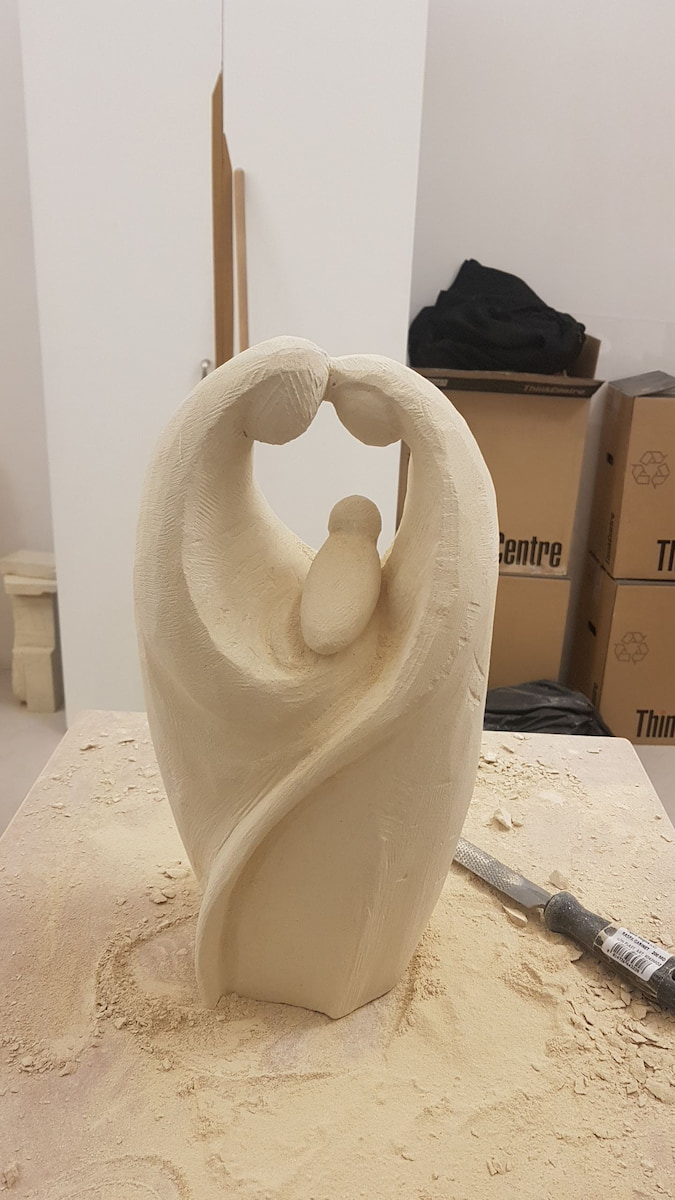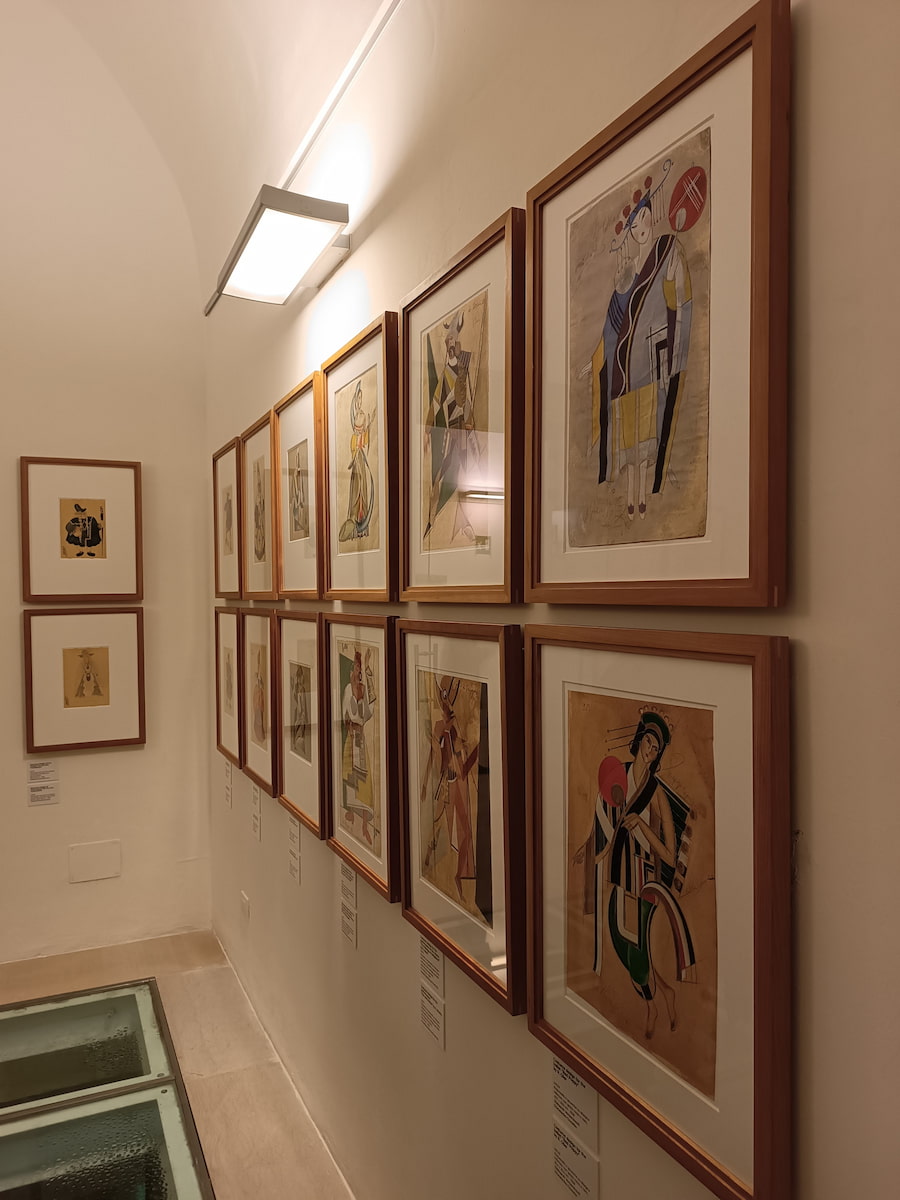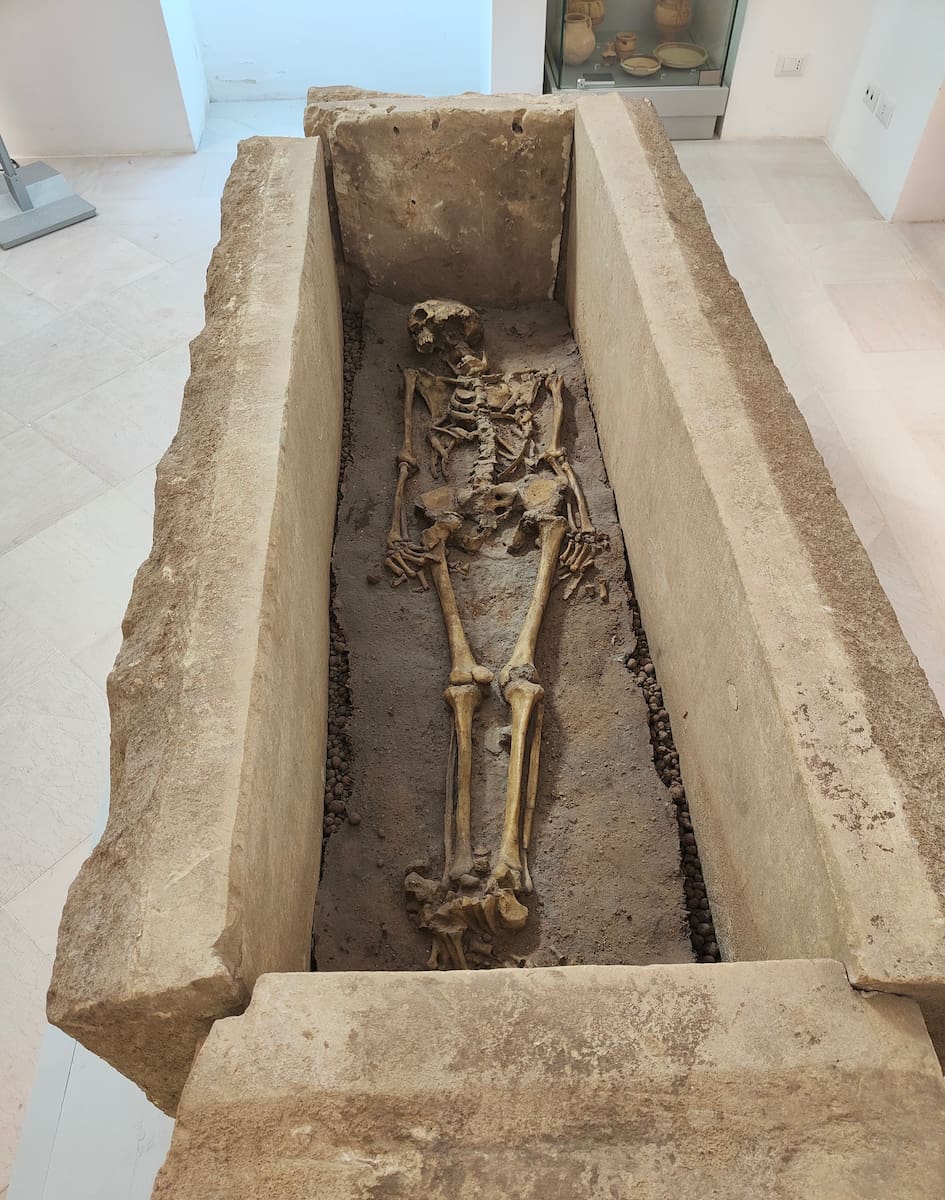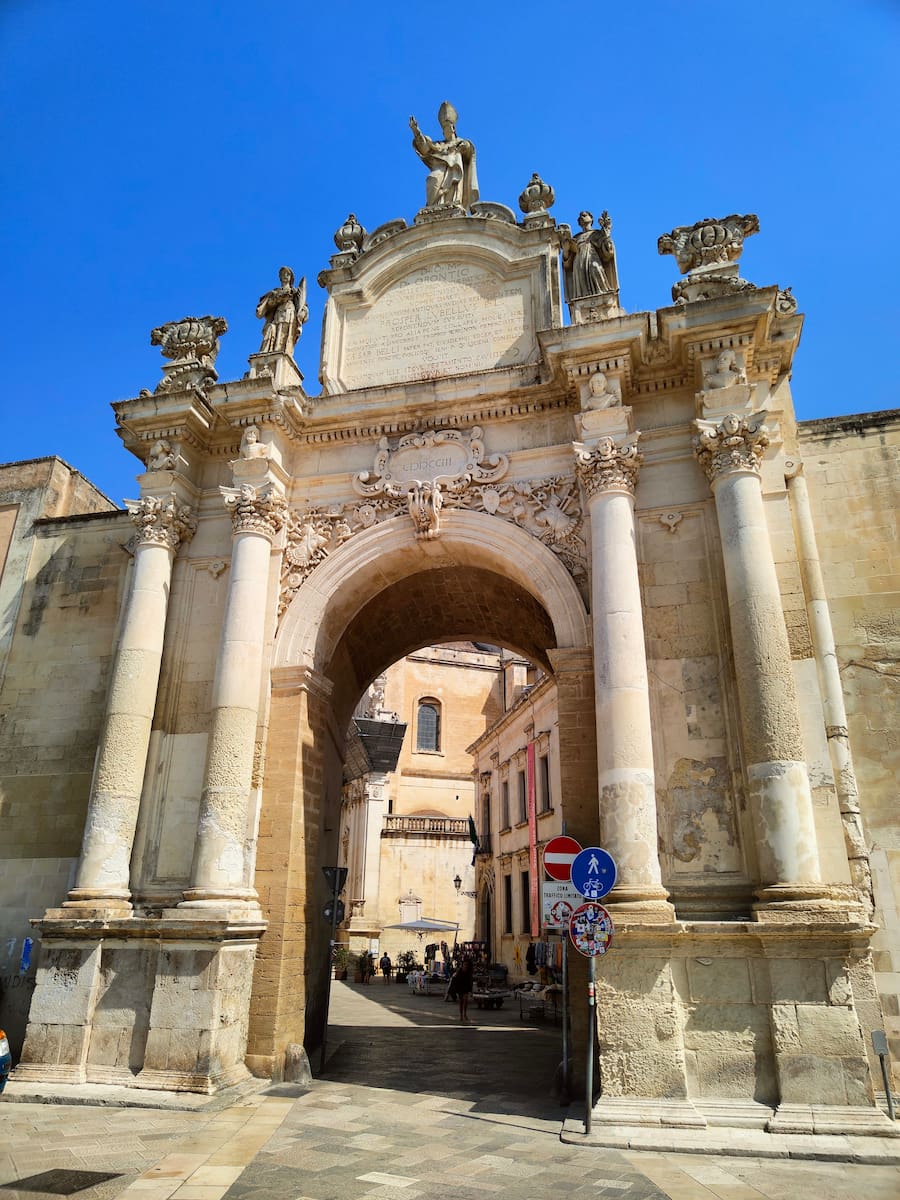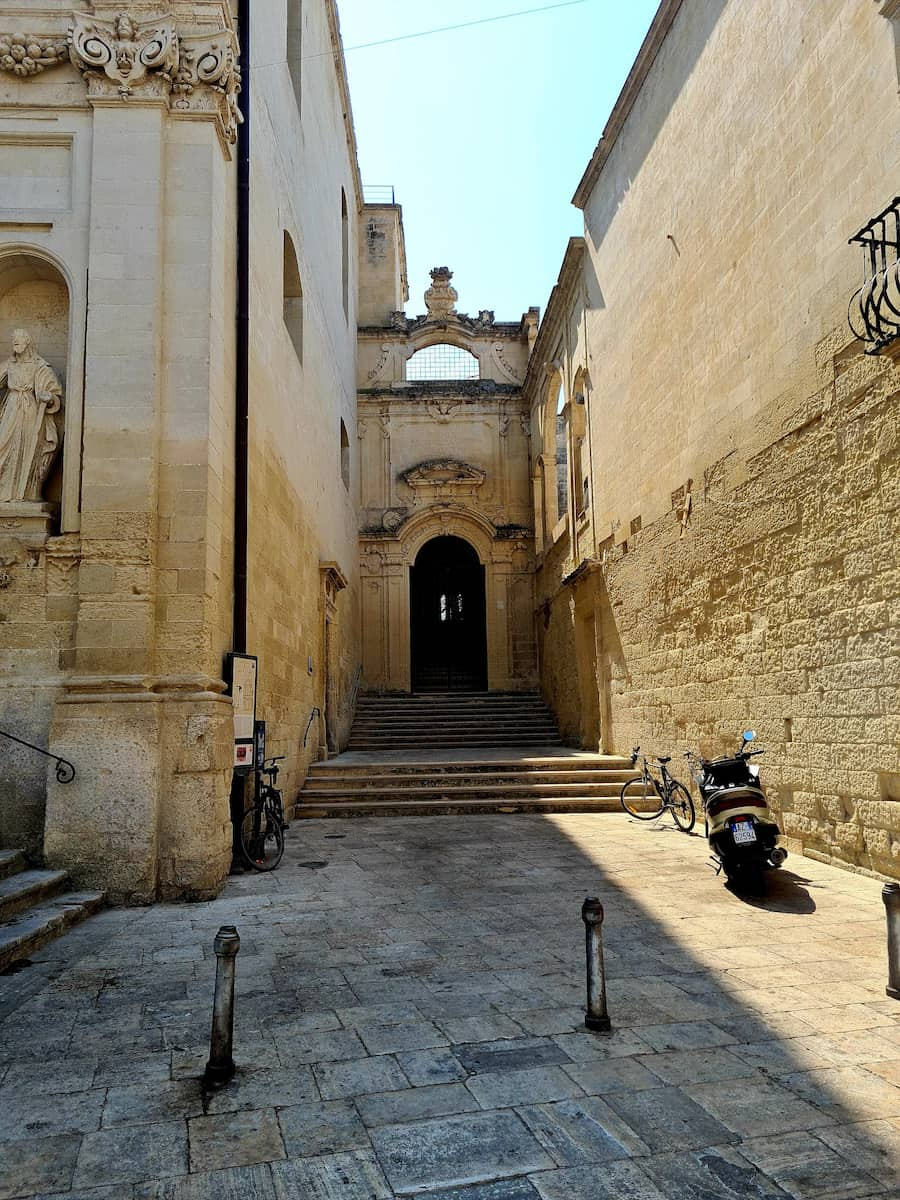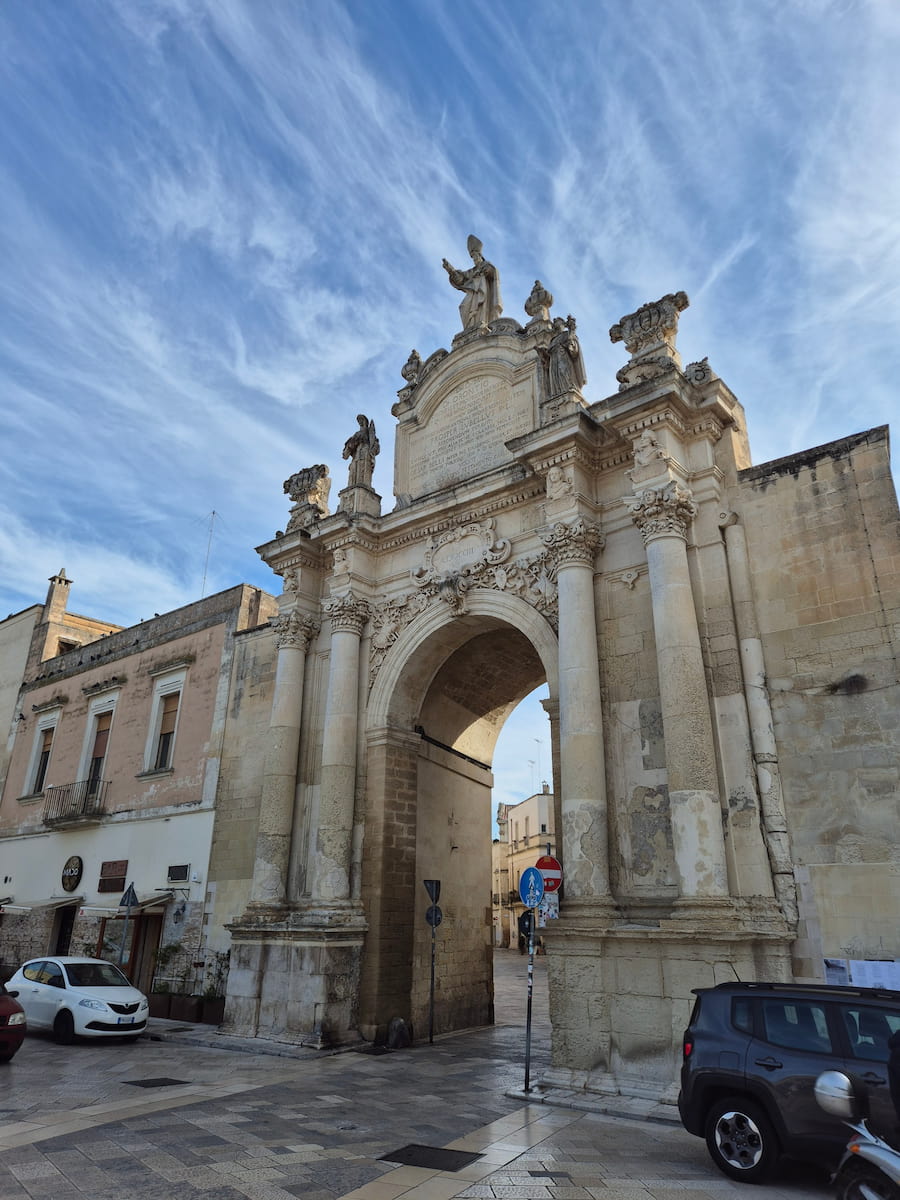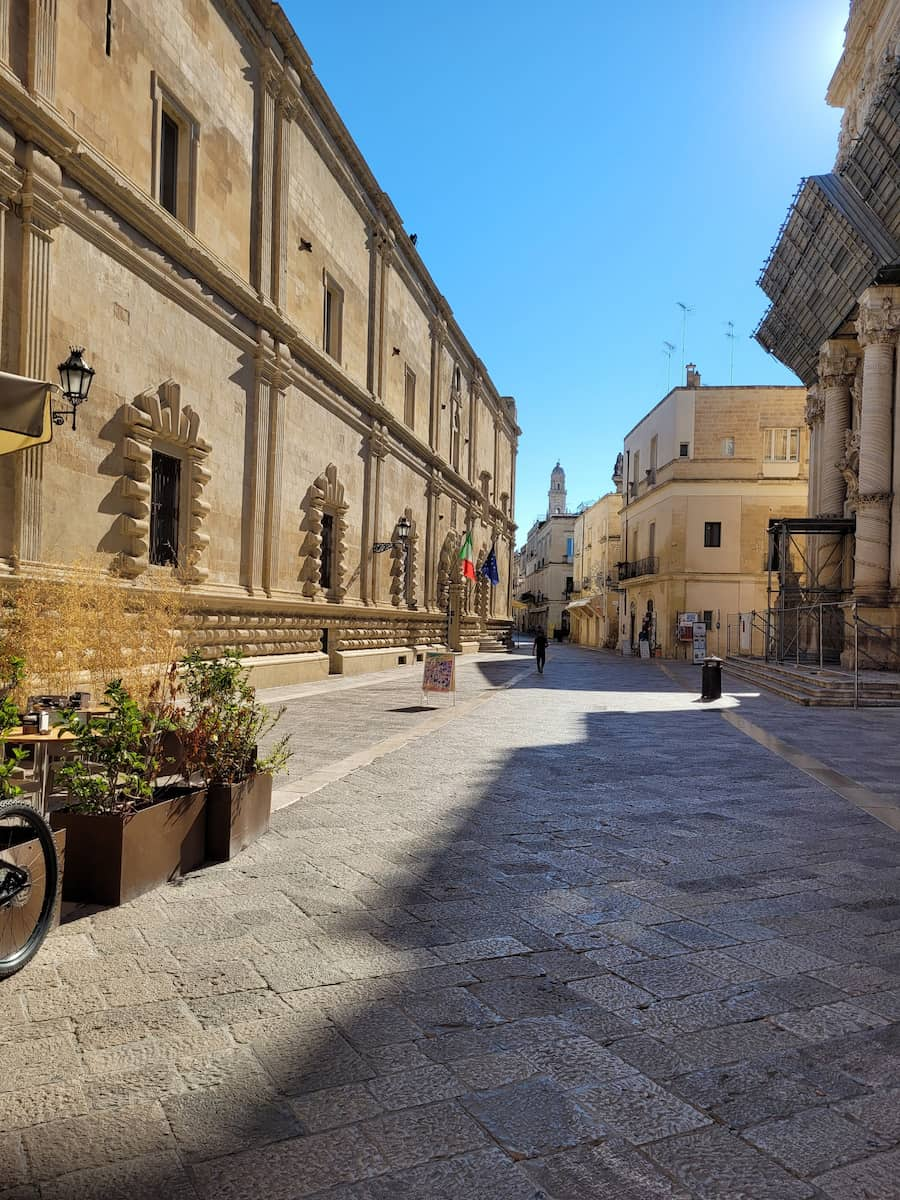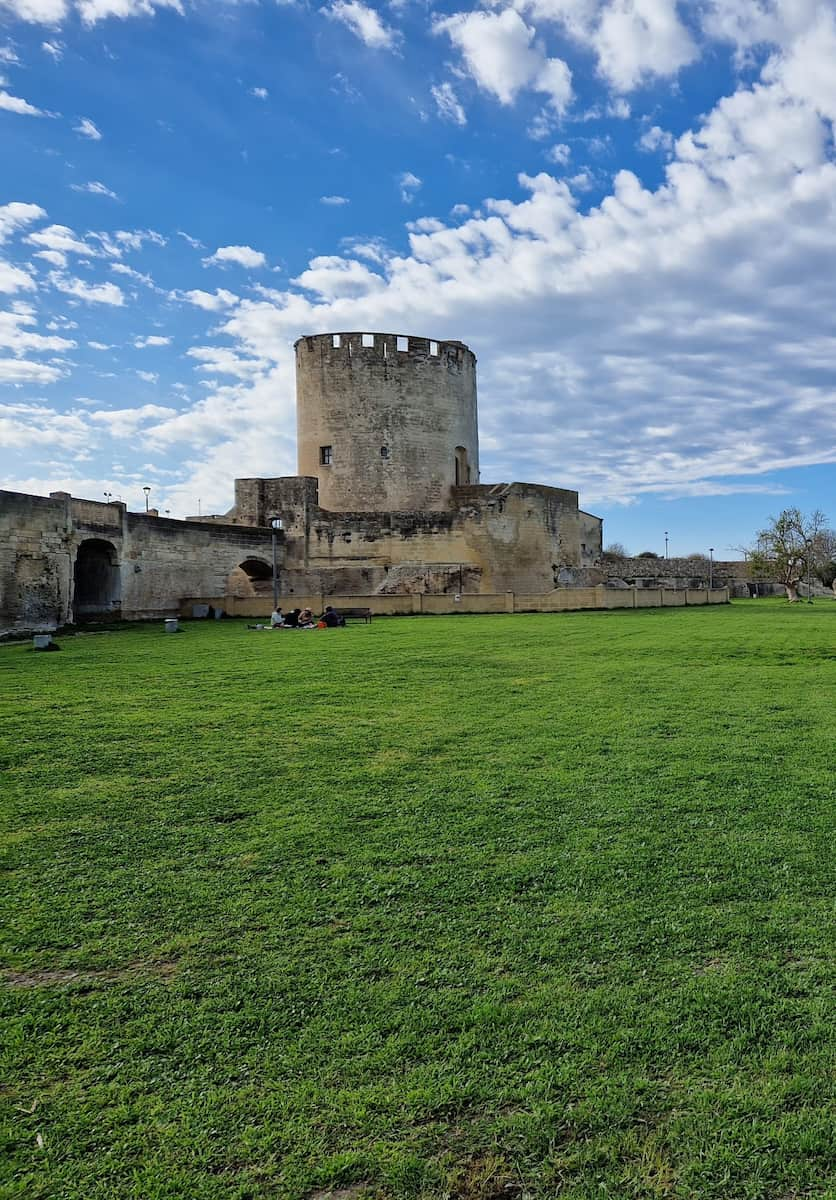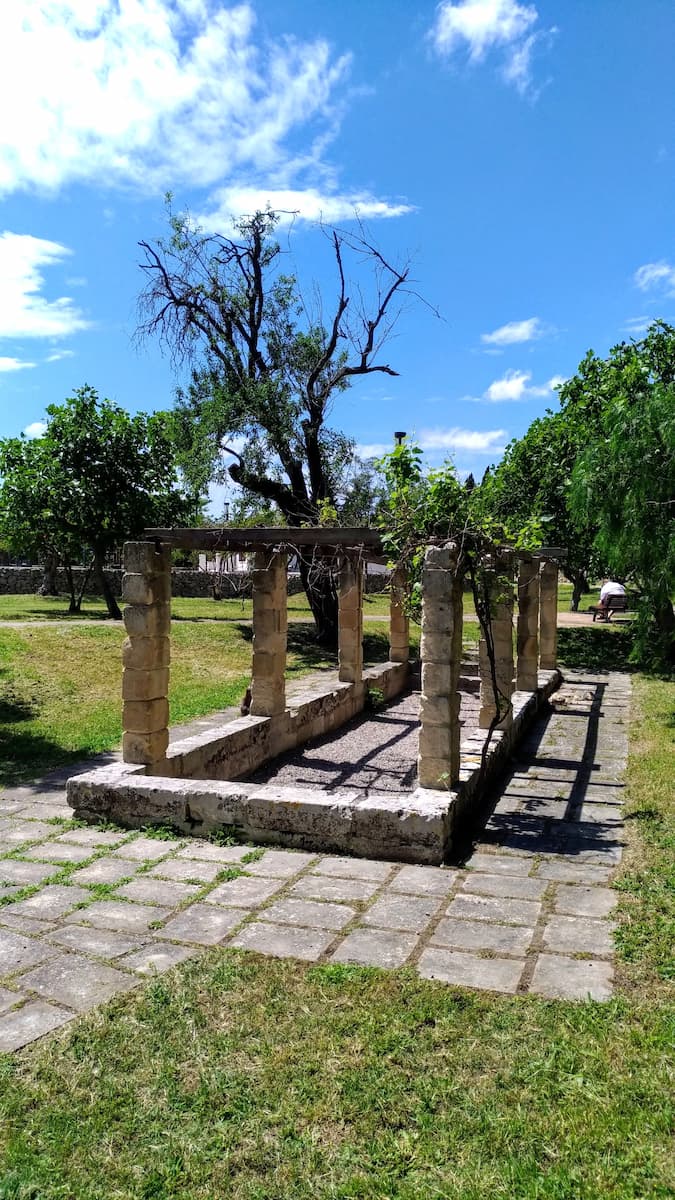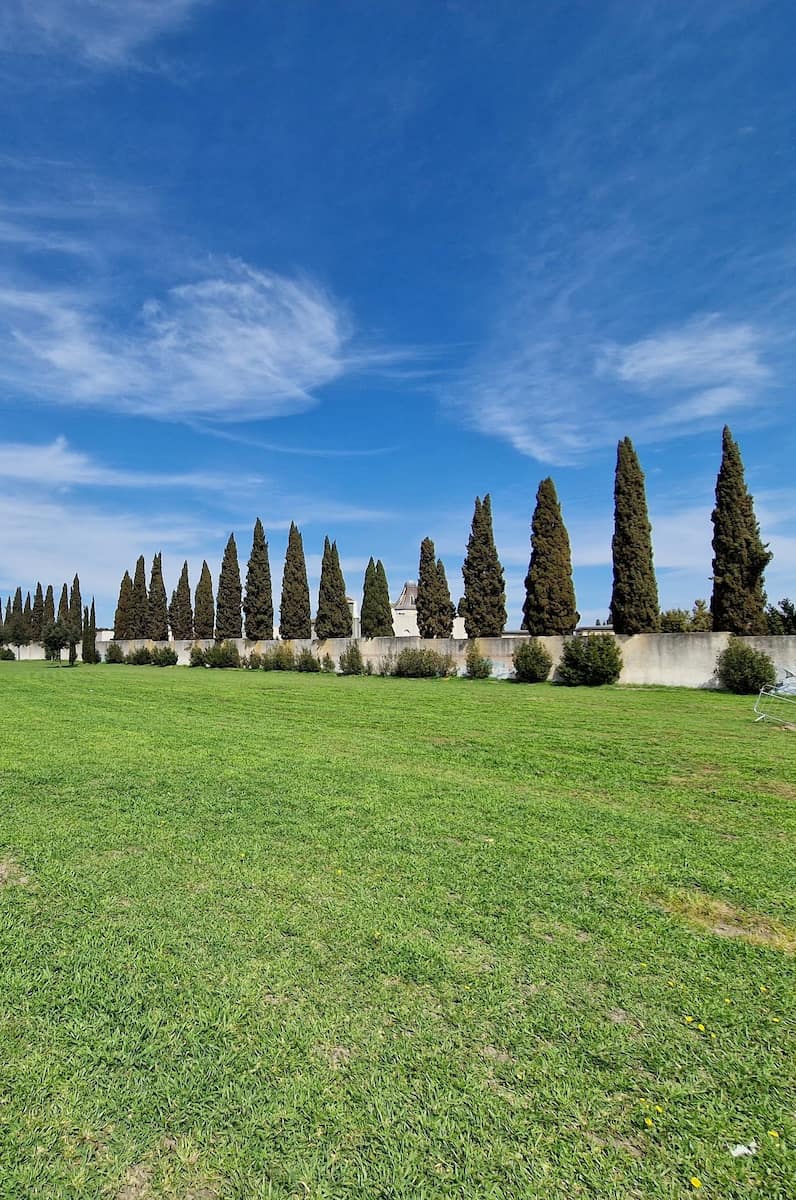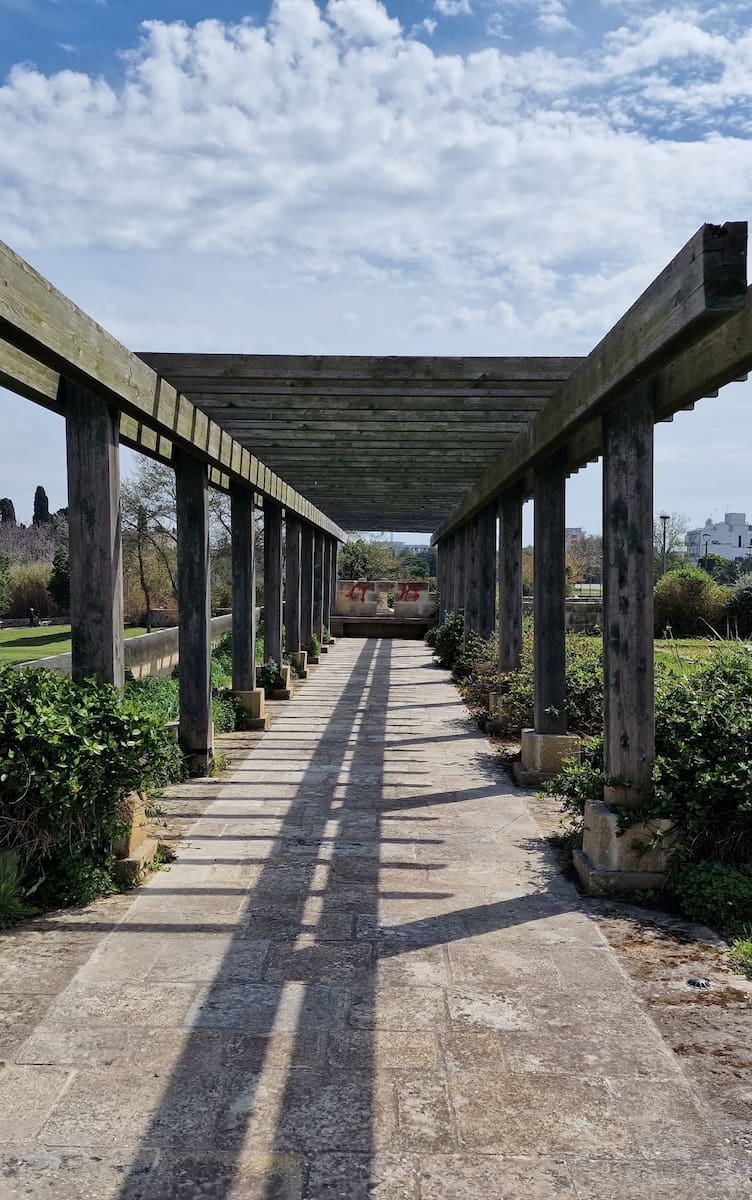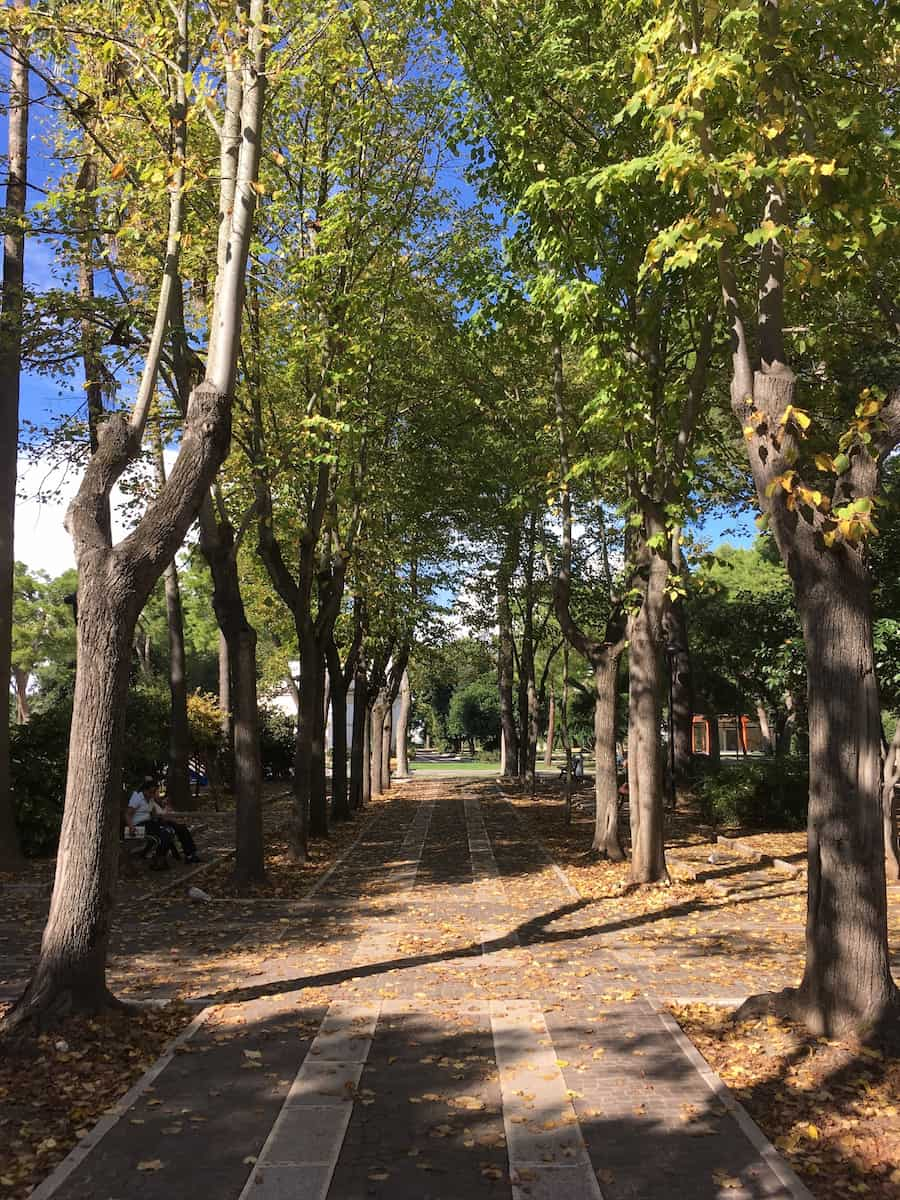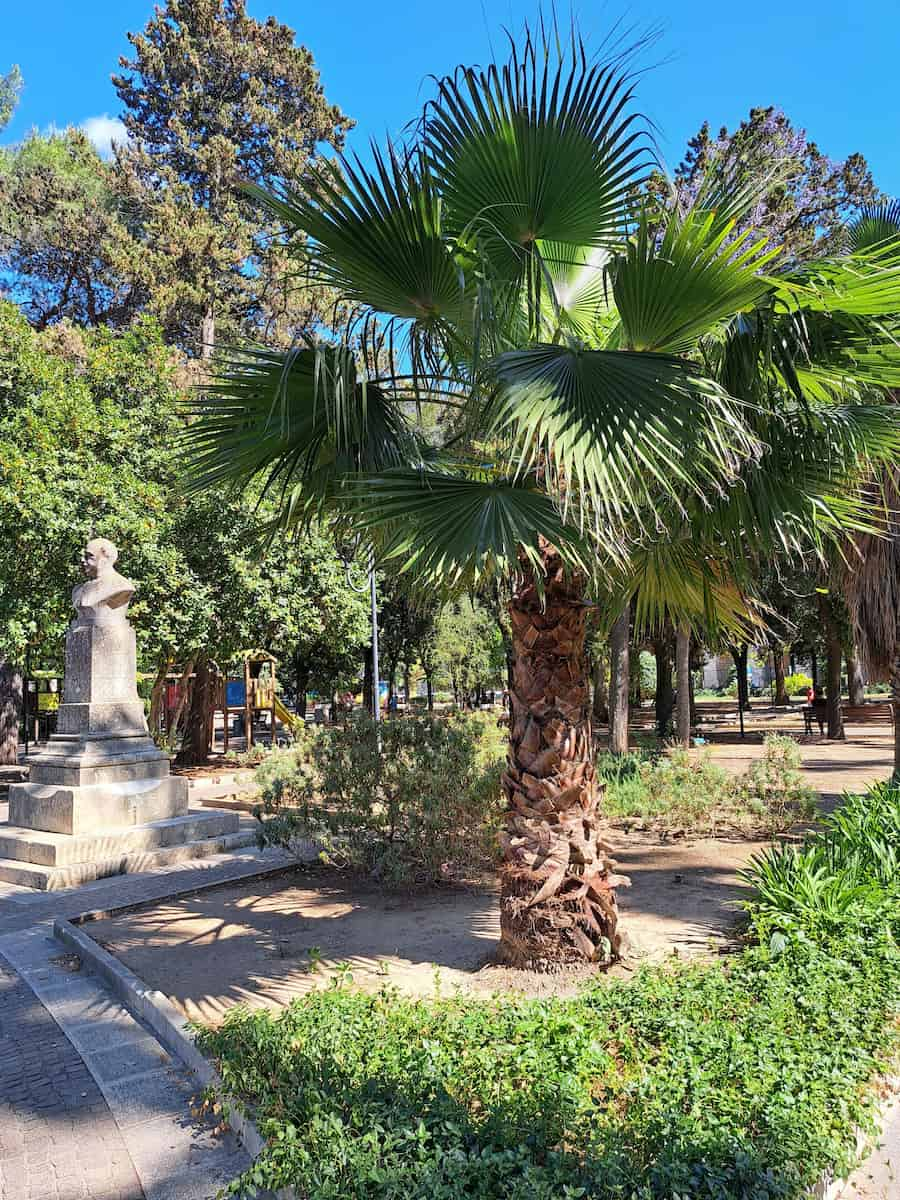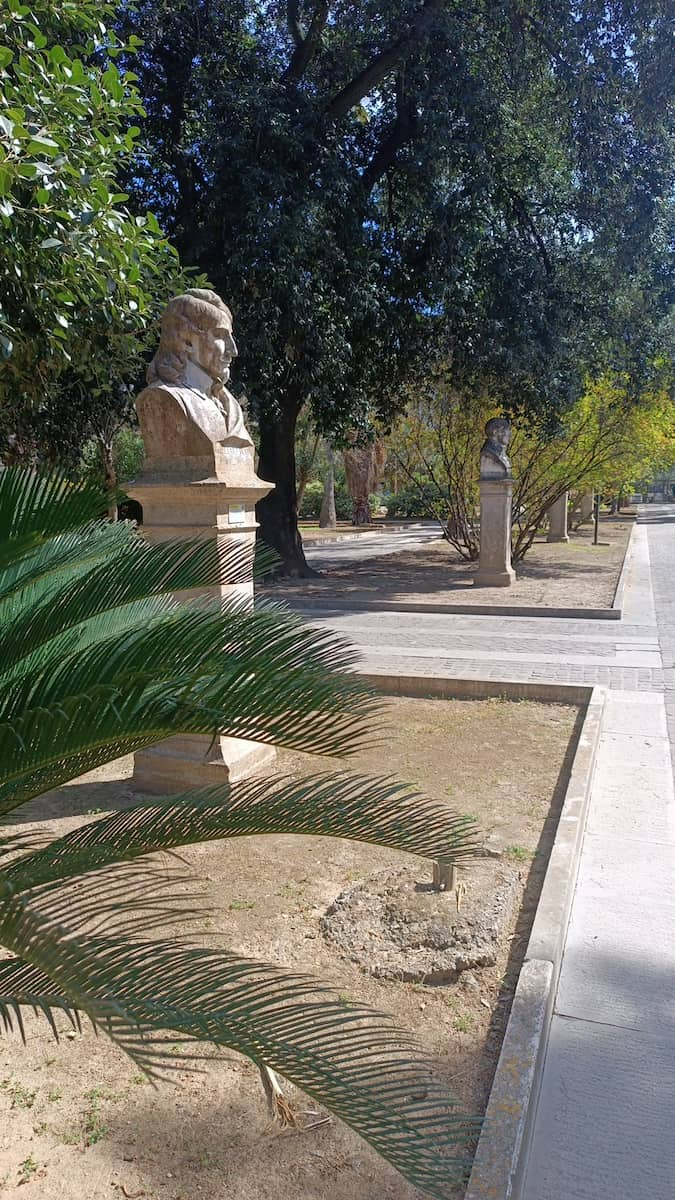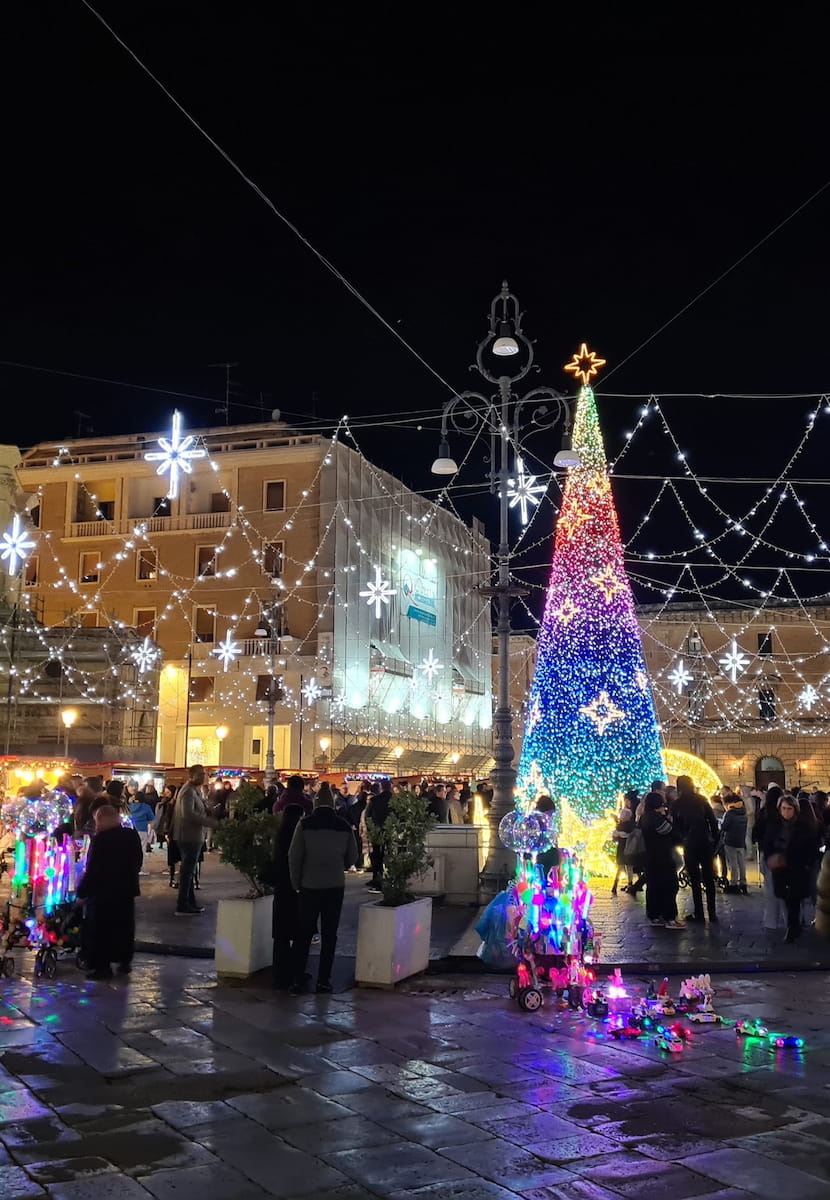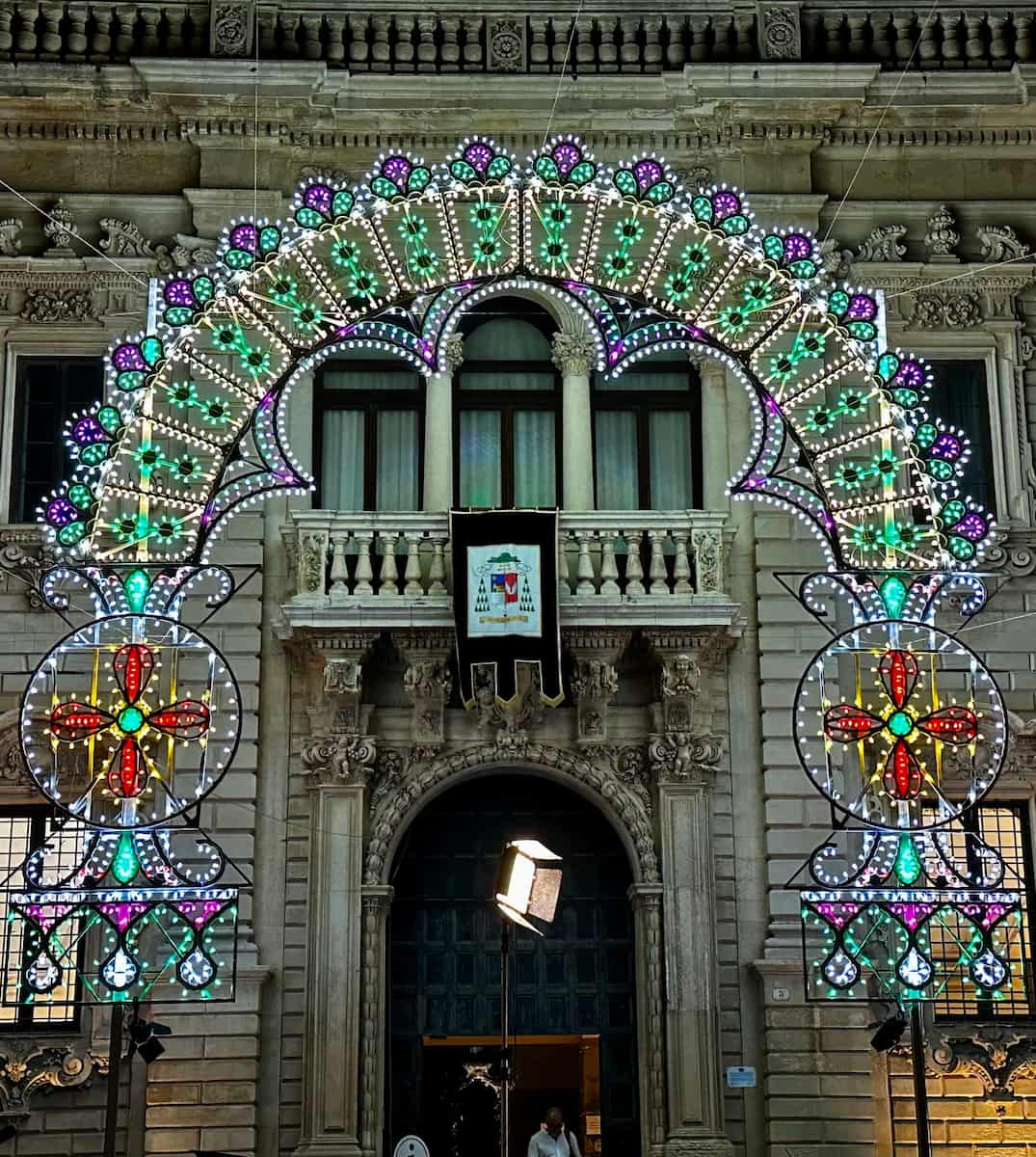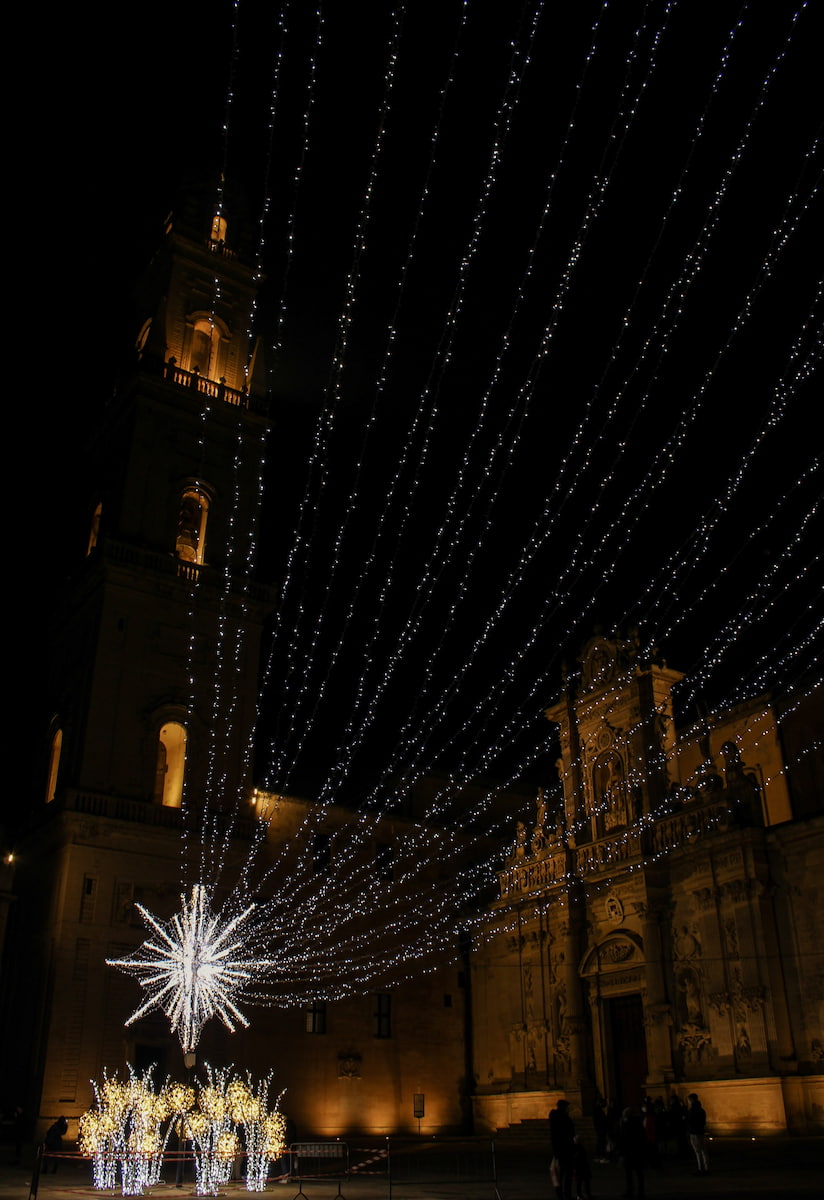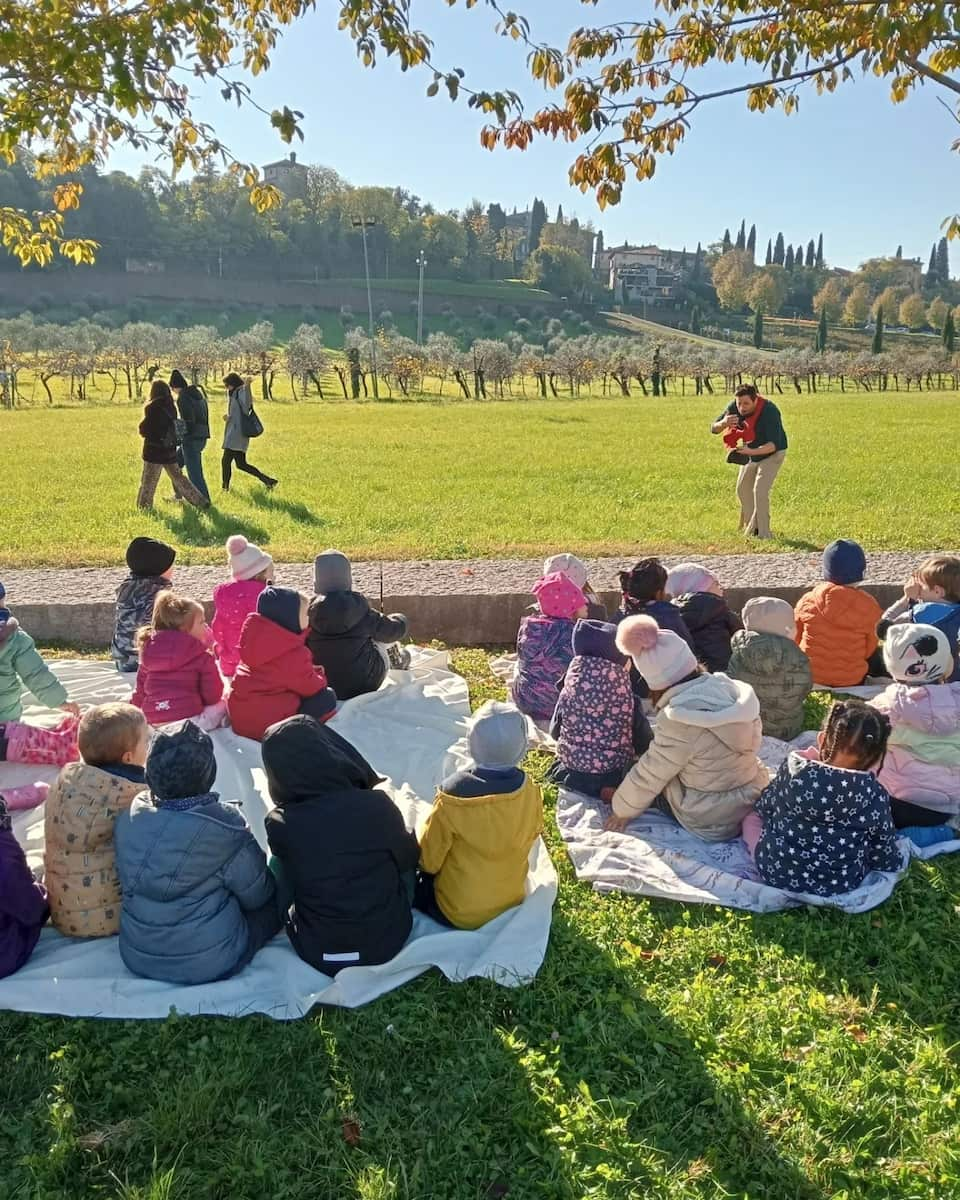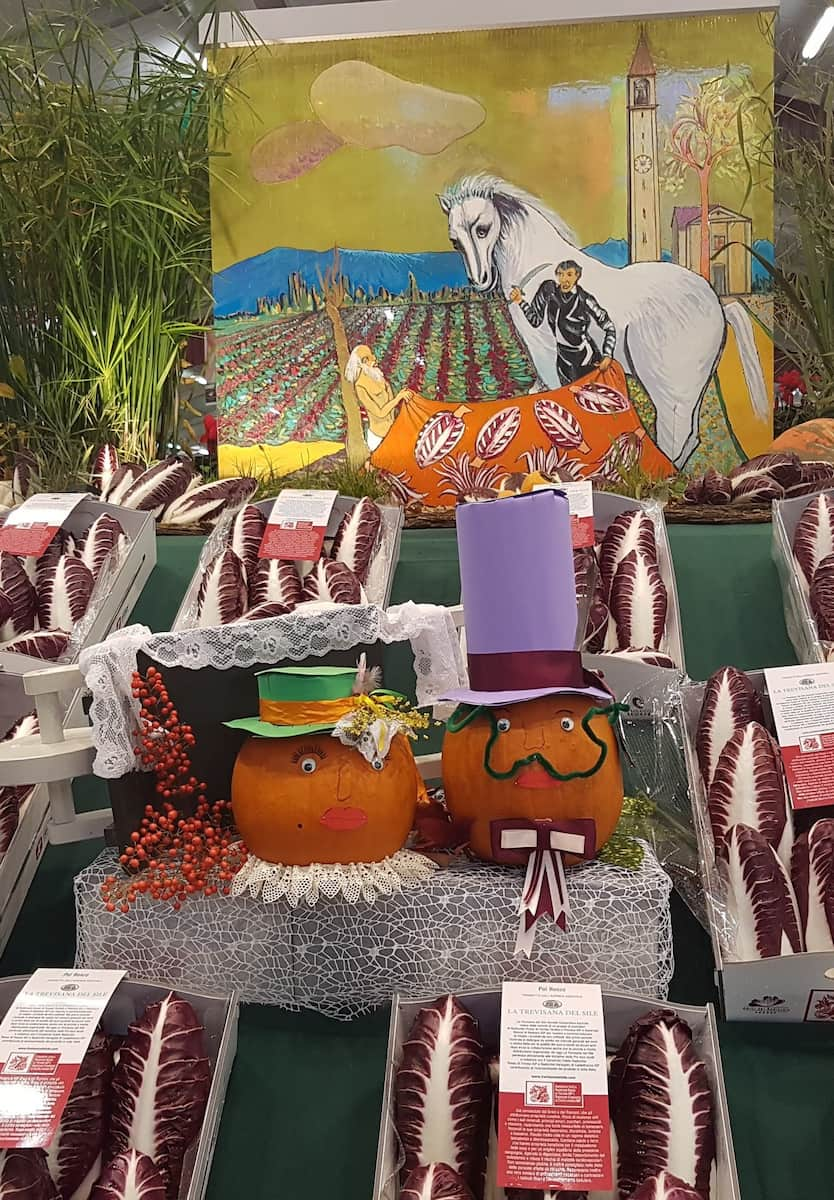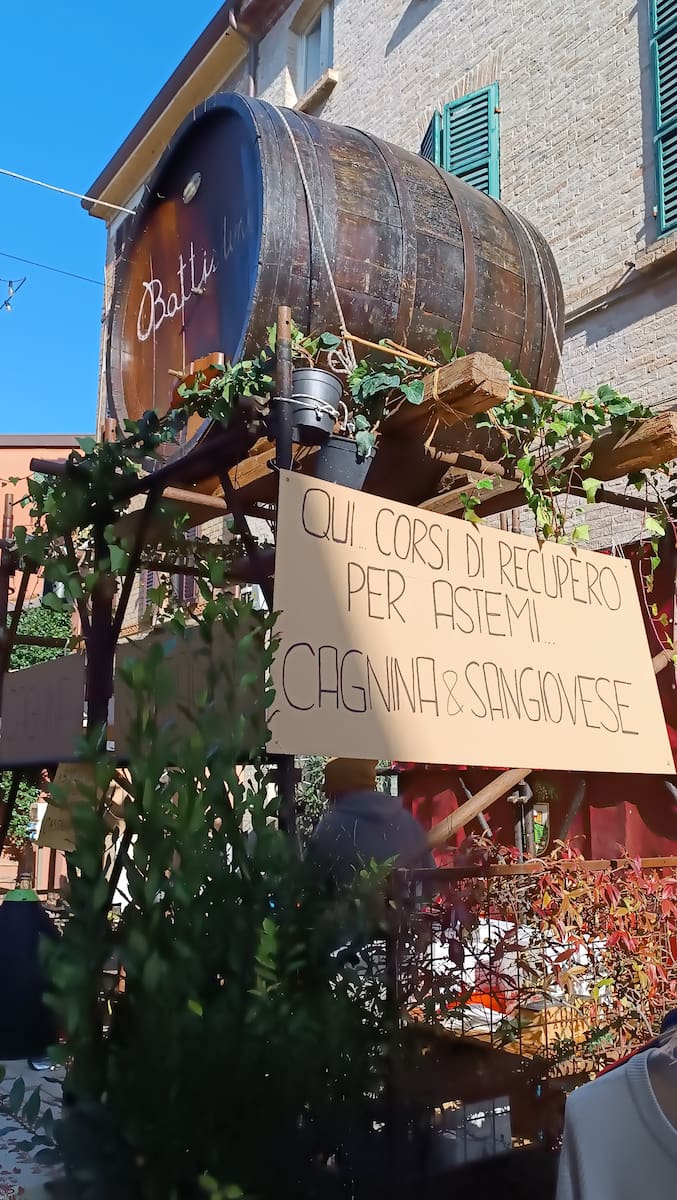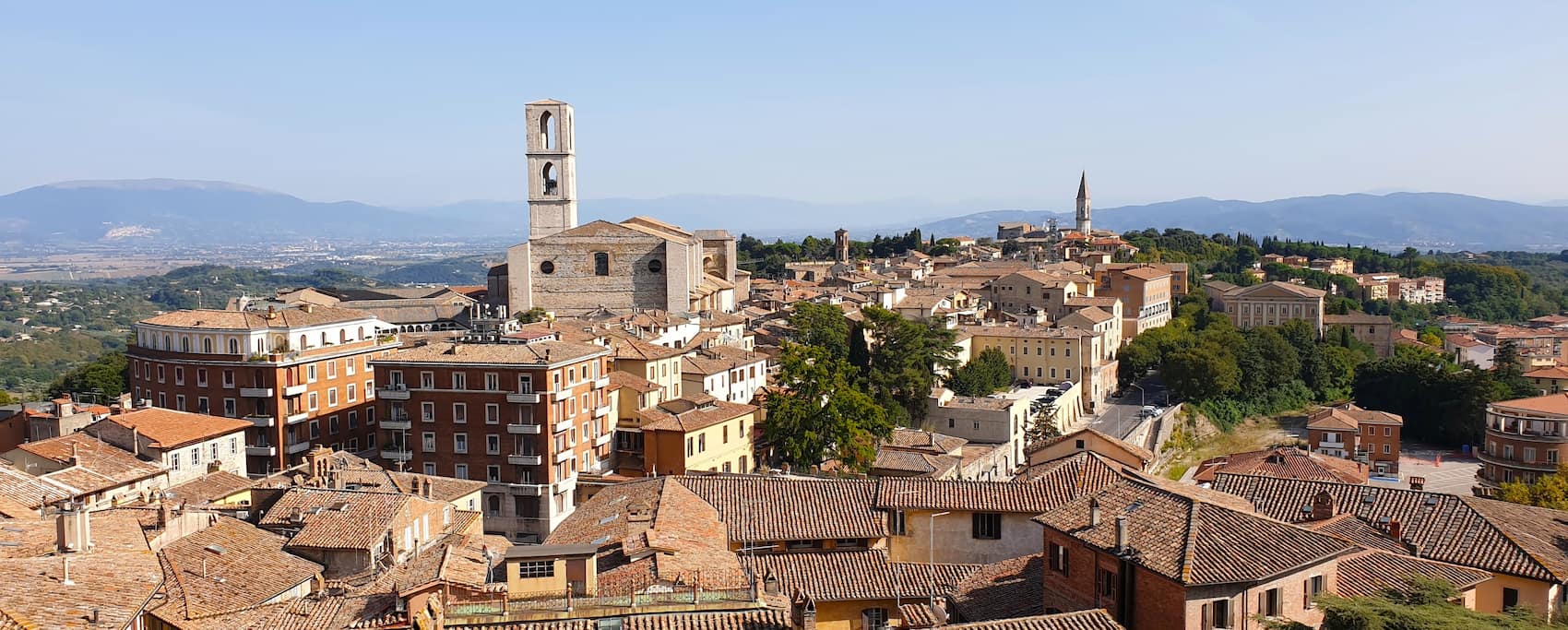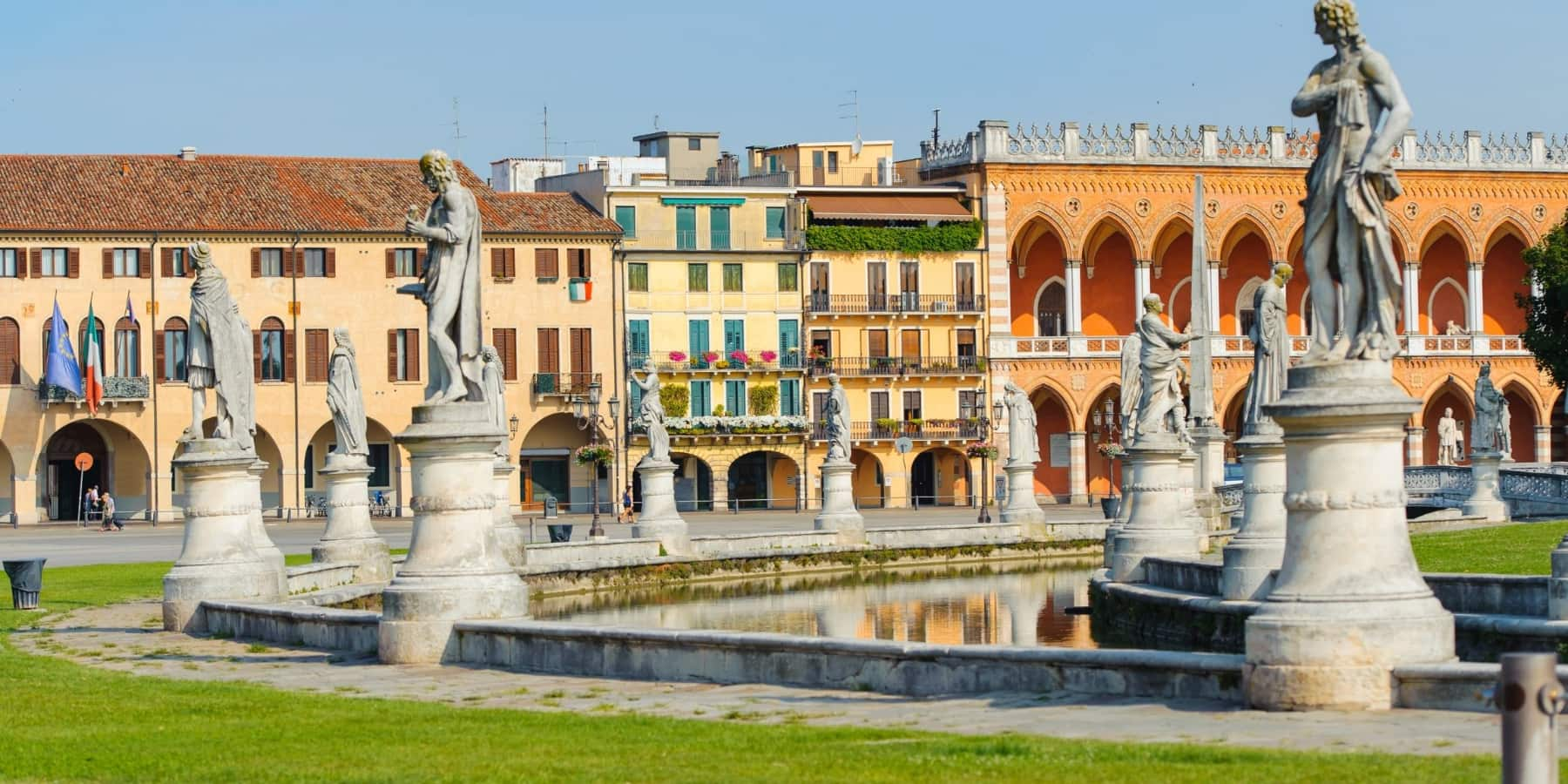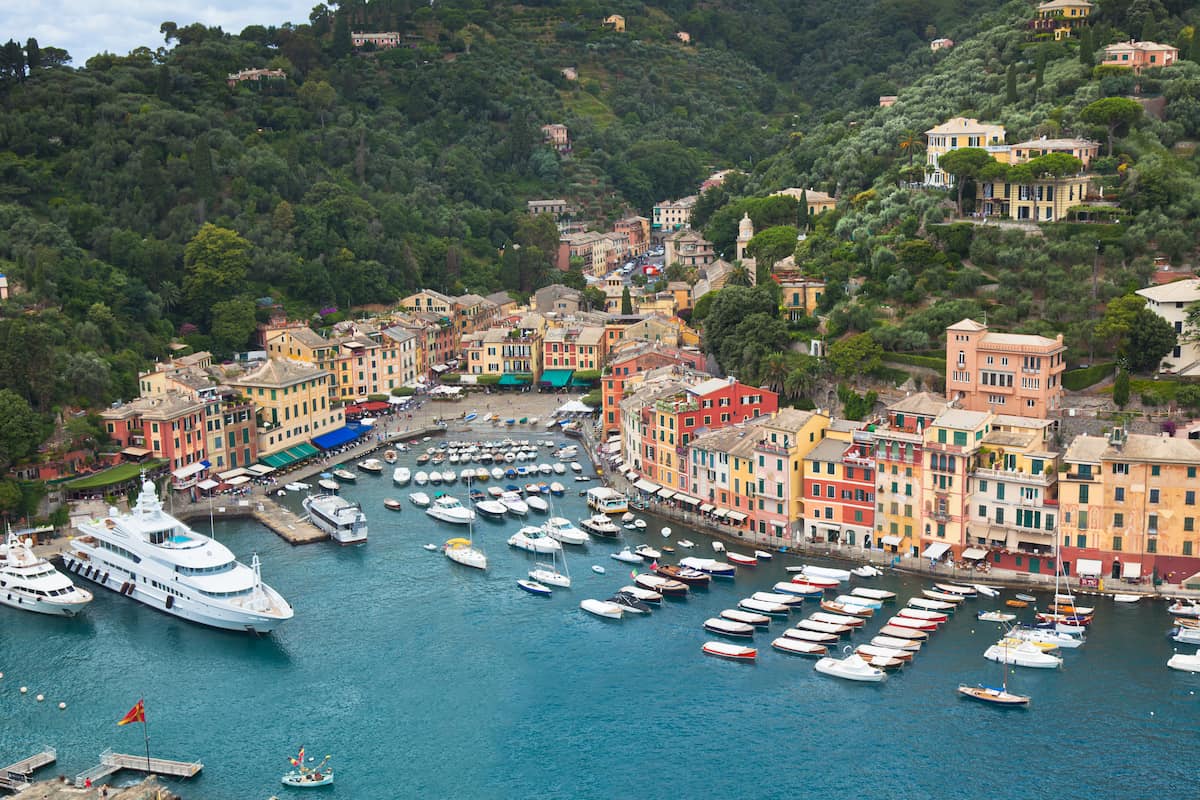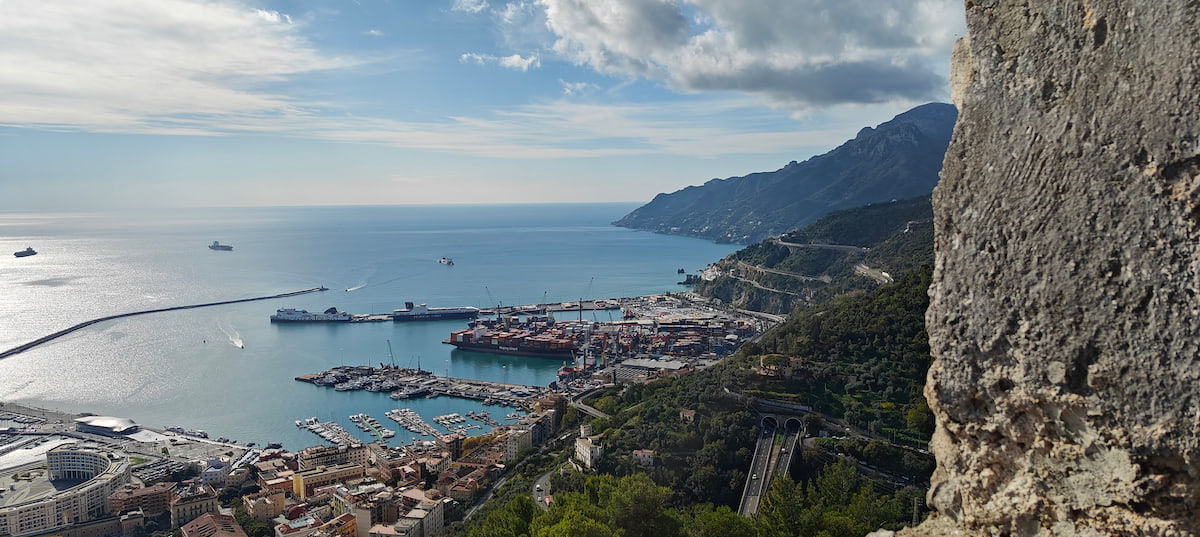Lecce is one of the best places to visit in the Puglia region, offering a perfect blend of history, culture, and charm. Known as the “Florence of the South,” Lecce is famous for its stunning Baroque architecture, especially the intricate designs carved from Lecce stone. Spend a few days in Lecce exploring its historic center, where attractions like Piazza Sant’Oronzo and Duomo di Lecce are must-sees.
🏠 Where to Stay in Lecce
- 💎 Luxury Hotel: La Fiermontina
- ✨ 5-Star: Patria Palace
- 🏨 4-Star: Ada Suites
- 🛏️ 3-Star: Palazzo Cavour Lecce
- 💸 Cheap: Euphorbia Residence
- 🏢 Apartament: Tito Schipa B&B
- 👨👩👧👦 For Families: Mamma Elvira
- 🏩 For Couples: Signuria Dimora Esclusiva
Located in the heart of the Salento region of Puglia, Lecce is also a great base for exploring nearby towns and beaches. Just 35 minutes from Lecce, some of the best beaches in Puglia await along the coast. Whether it’s discovering the history of Lecce or enjoying the vibrant street food scene, there are plenty of fun things to see and do in this beautiful part of southern Italy.
💁 Best Guided Tours
- Small-group tour of the caves of Santa Maria di Leuca from € 20 (⭐4.8/5)
- Mini-cruise to Porto Cesareo with snorkeling and typical aperitif from € 45 (⭐4.8/5)
- 3-Hours Boat Tour to the Caves of Santa Maria di Leuca from € 45 (⭐4.9/5)
- Lecce History and Food Tasting Tour with Antonella from € 60 (⭐4.9/5)
Best Things To Do in Lecce
1. 💒 Basilica di Santa Croce
Baroque masterpiece: The Basilica di Santa Croce is one of Lecce’s most iconic landmarks and an outstanding example of Apulian Baroque architecture. Built between the 16th and 17th centuries, this church is famous for its richly decorated façade, featuring intricate carvings of mythical creatures, angels, and a magnificent central rose window. The basilica’s interior houses several ornate altars, including the notable Altar of San Francesco da Paola, crafted by Francesco Antonio Zimbalo.
Historical significance: The basilica was constructed on the site of a former church built by the Celestine monks in the 14th century. It was part of a larger complex that included the adjacent Celestine Convent. The façade’s elaborate decorations symbolize the triumph of Christianity over evil, with references to significant events like the Battle of Lepanto in 1571.
Insider Tip: Visit early in the morning to admire the façade in soft sunlight and avoid crowds. Don’t forget to look closely at the details on the upper order—each figure tells a story!
⭐ Best tour
- Tour of Lecce – You will explore the nearby Piazza Sant’Oronzo, the former market square with the Old Town Hall, the Roman Column and the remains of a Roman amphitheatre and visit Basilica di Santa Croce – Jewel of Lecce Baroque!
2. 🏰 Castello Carlo V
Step into history: Built in the 16th century, Castello Carlo V stands as a symbol of Lecce’s strategic importance during medieval times. The castle, located near Piazza Sant’Oronzo, was originally built for defense purposes but now houses temporary art exhibitions and cultural events. Its massive walls and towers are perfect for history buffs looking to explore Lecce’s military past.
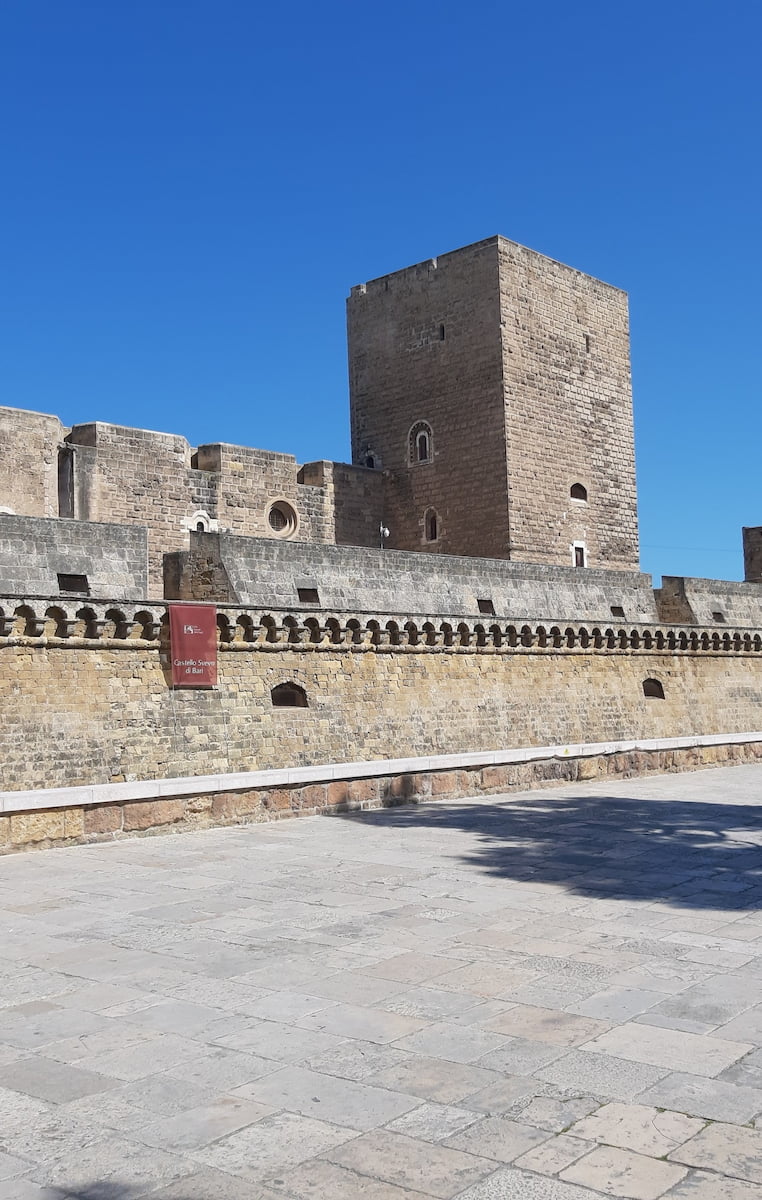
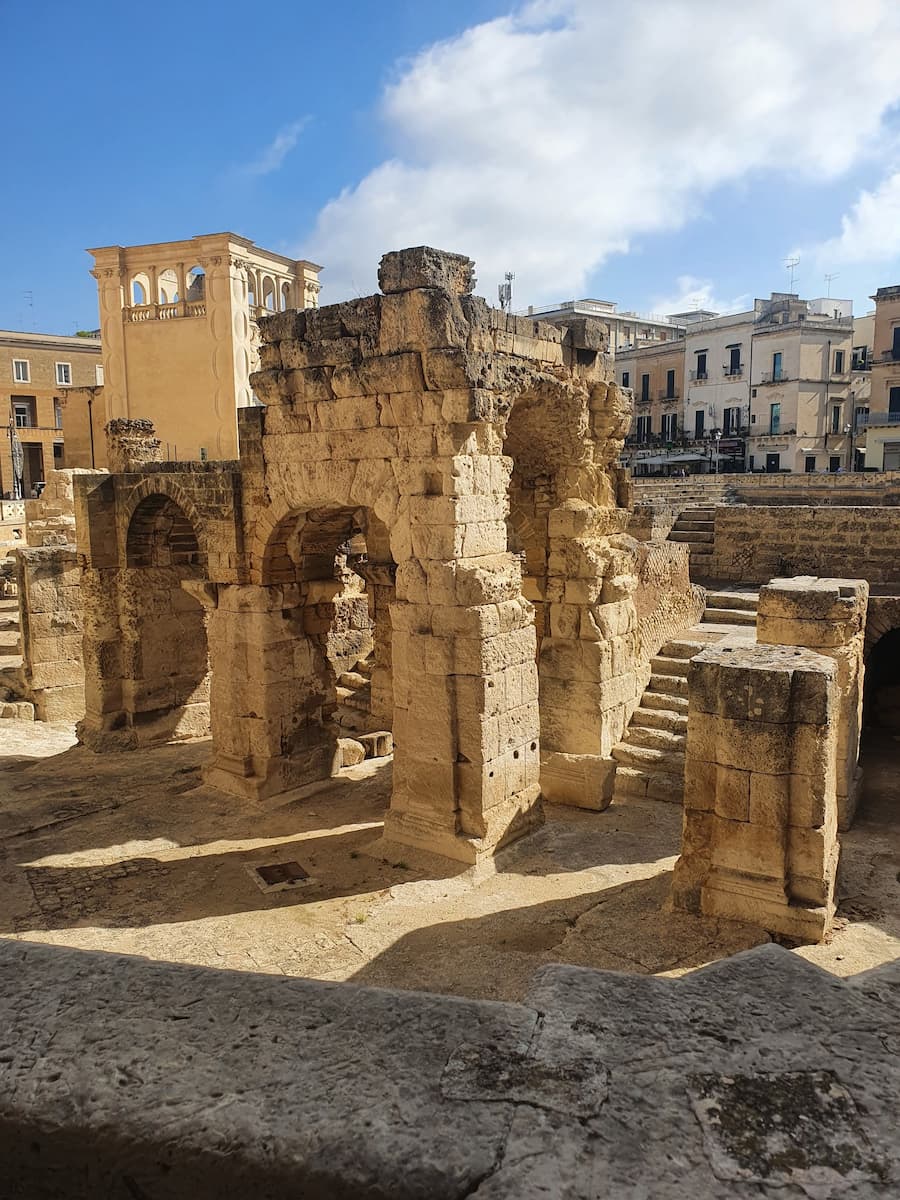
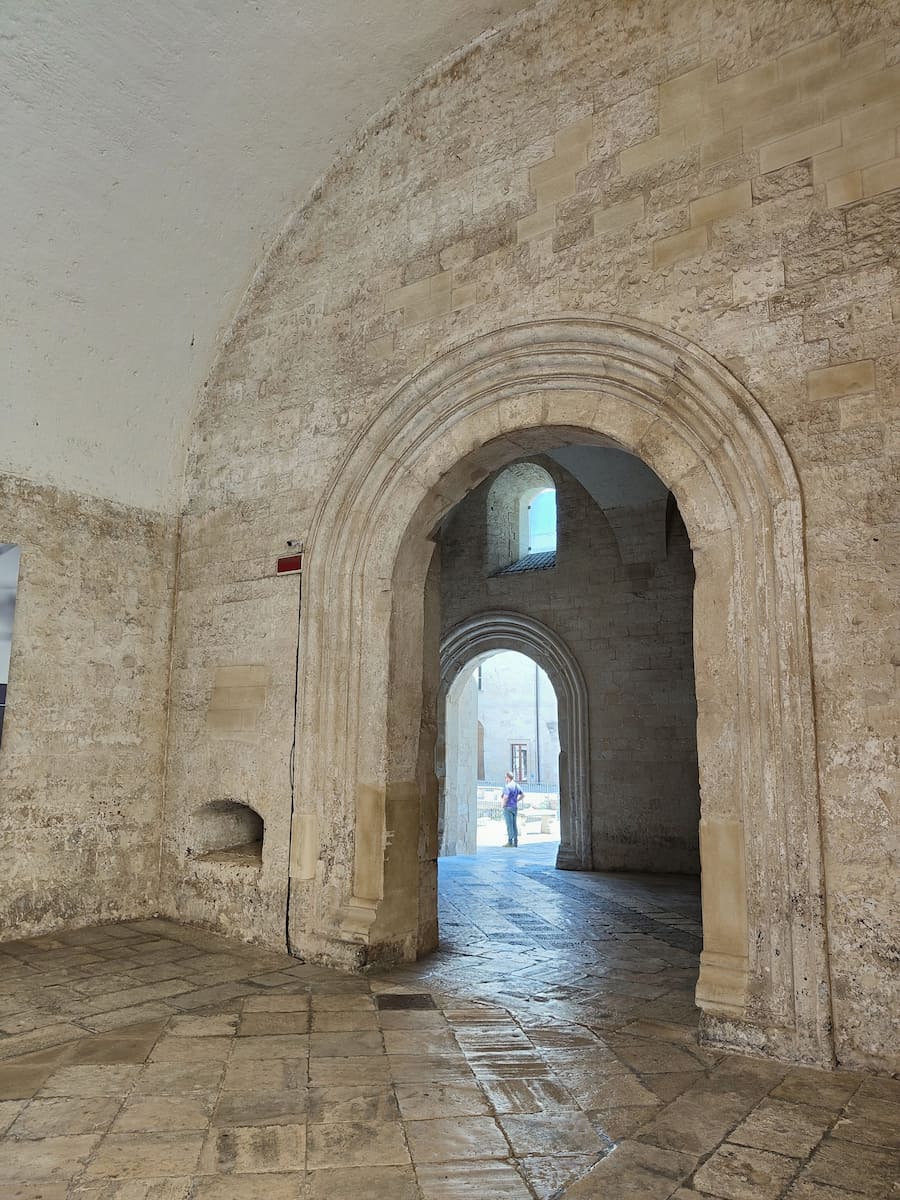
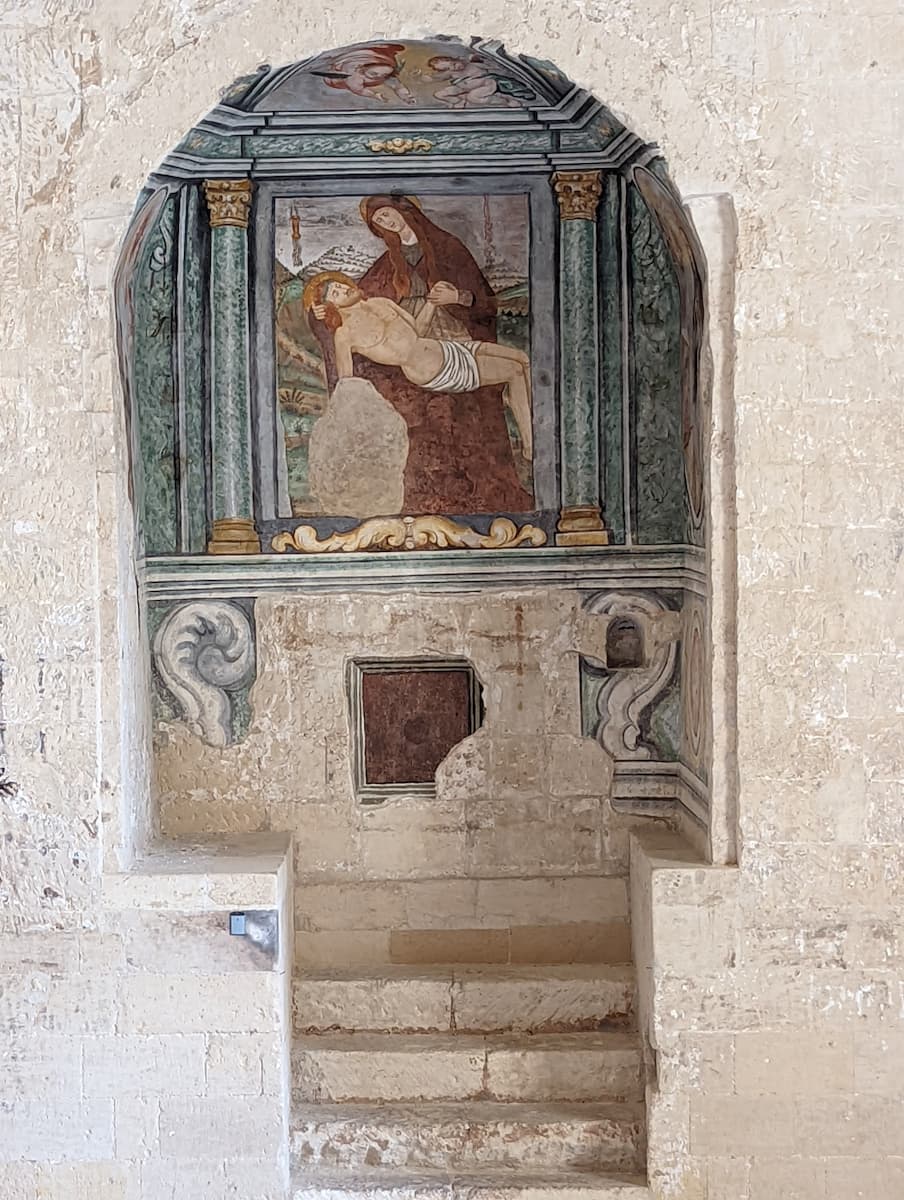
Panoramic views: Inside the castle, you’ll find exhibits detailing Lecce’s history as well as modern art installations. Climb to the top for panoramic views of Lecce’s rooftops and beyond. The castle also hosts various festivals throughout the year, making it an exciting stop during your trip.
Top Tip: Check ahead for special exhibitions or events happening during your visit. Booking tickets online can save time and ensure you don’t miss out on any limited-time displays.
⭐ Best tour
- Cooking class in Lecce – Together with Enza you will discover the pleasure of making homemade orecchiette and macaroni with simple ingredients.
3. ⛪ Piazza del Duomo
Baroque splendor: Piazza del Duomo, often considered one of Italy’s most beautiful squares, is an enclosed space surrounded by some of Lecce’s most important buildings: the Lecce Cathedral (Duomo di Maria Santissima Assunta), the Bishop’s Palace, and the Seminary. The cathedral itself is a stunning example of Baroque architecture with its intricate façade designed by Giuseppe Zimbalo in 1659.
Cultural hub: This square isn’t just about architecture—it’s also a cultural gathering place where events such as outdoor concerts take place throughout the year. The cathedral’s bell tower offers panoramic views over Lecce and beyond, making it worth climbing for those looking for breathtaking photo opportunities.
Top Tip: Visit Piazza del Duomo at sunset when its golden hues are illuminated by soft light—a perfect time for photography without large crowds.
⭐ Best tour
- A Stroll Through Lecce – Discover Lecce’s rich Baroque architecture and vibrant history with this leisurely walking tour. As you stroll through the city’s cobbled streets, you’ll encounter stunning landmarks like the Basilica of Santa Croce and Piazza Sant’Oronzo, along with hidden gems that reveal Lecce’s artistic and cultural heritage.
4. 🕍 Jewish History at Museo Ebraico (Jewish Museum)
Medieval Jewish heritage: Located in what was once Lecce’s medieval Jewish quarter (Giudecca), the Jewish Museum of Lecce (Museo Ebraico) offers a deep dive into the history of Jewish life in Salento from the 9th century until their expulsion in 1541. Housed within Palazzo Taurino, this museum features artifacts such as mikvaot (ritual baths), mezuzah doorposts, and inscriptions that tell stories from medieval Jewish life.
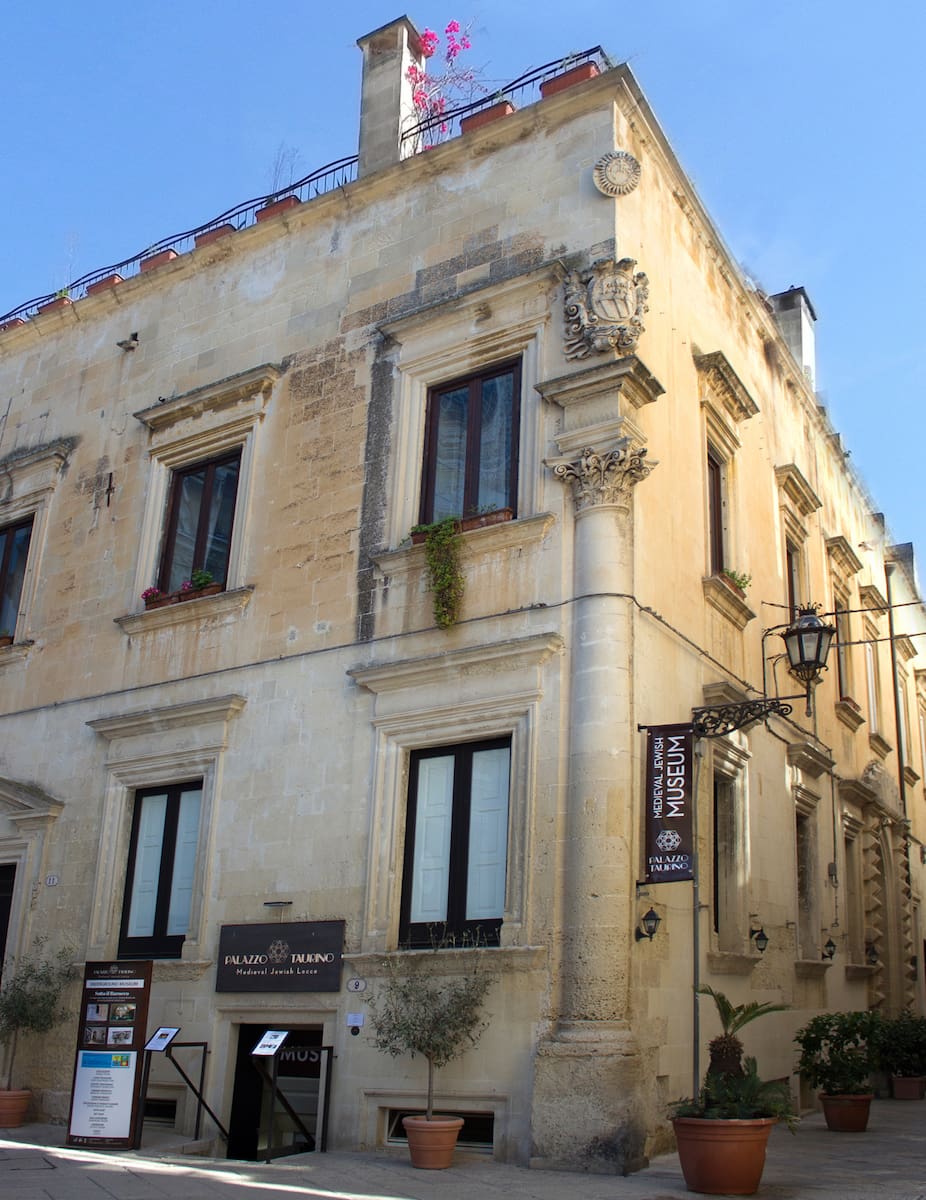
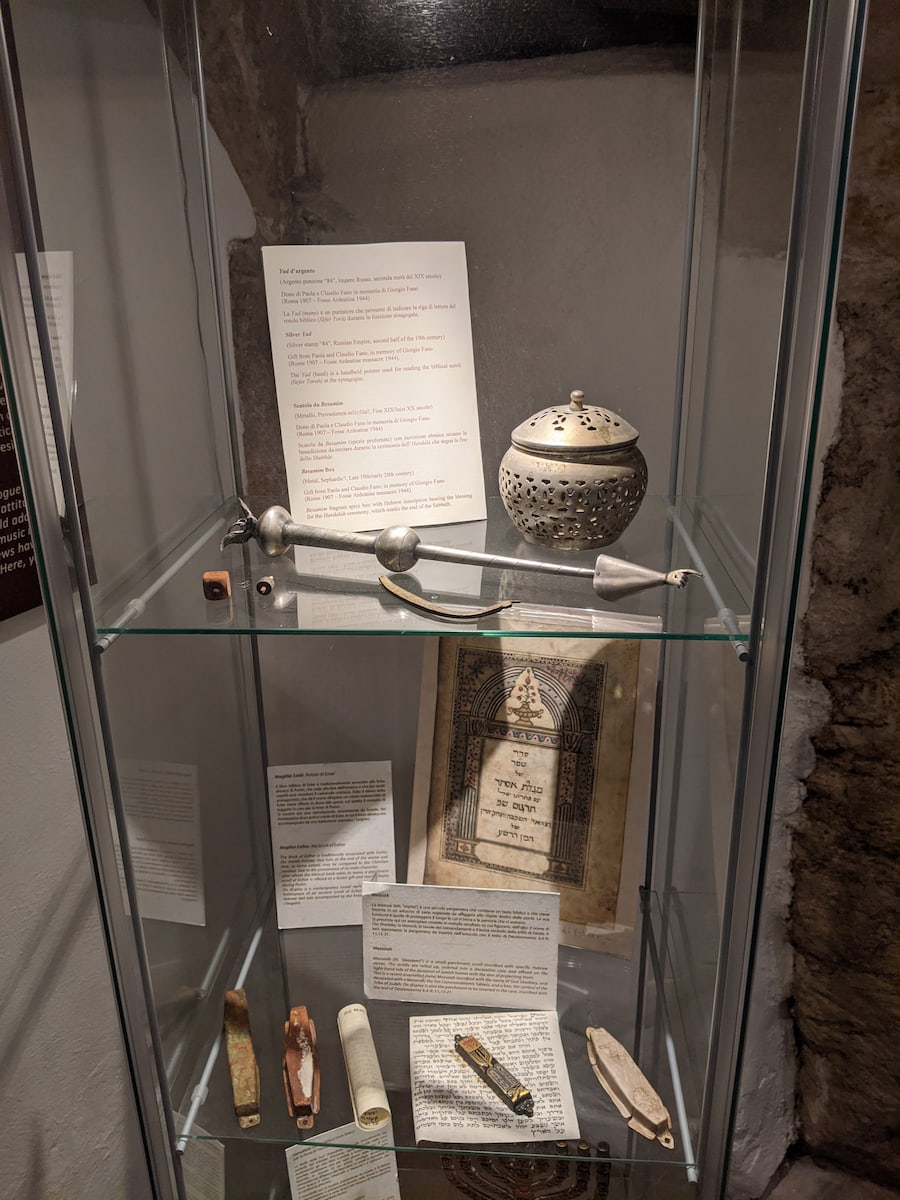

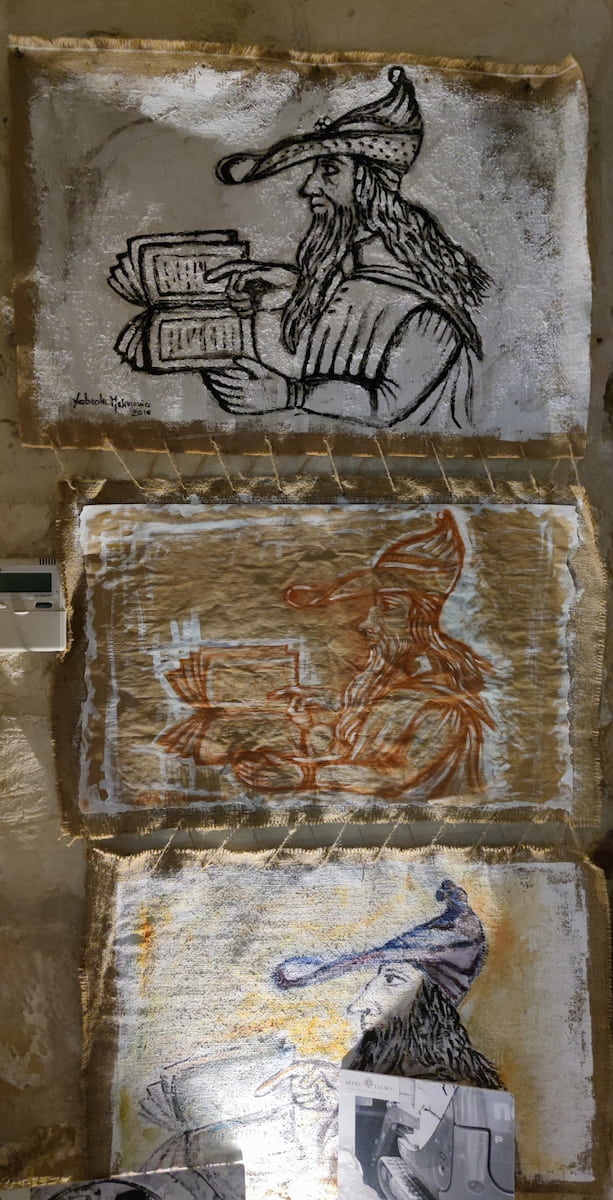
Cultural significance: Opened in 2016 after extensive research led by Professor Fabrizio Lelli from the University of Salento, this museum serves as both a historical archive and cultural center. It also hosts contemporary art exhibitions through its MAiDE gallery—showcasing works by Jewish artists from around the world—and organizes educational workshops for schools.
Insider Tip: Don’t miss taking a guided tour through what remains of Lecce’s Jewish quarter after visiting the museum—it provides fascinating insights into how this community lived centuries ago.
⭐ Best tour
- Jewish Museum Lecce – Enjoy a private guided tour of Lecce’s museum, where you’ll explore fascinating exhibits and learn about the city’s rich history. This experience includes an entrance ticket and personalized guidance, offering an in-depth look at Lecce’s cultural heritage.
5. 🏛️ Museo Faggiano
Archaeological treasure: The Museo Faggiano is a privately-owned archaeological museum located in the heart of Lecce. It was discovered by accident in 2001 when the Faggiano family was renovating their home and unearthed layers of history dating back over 2,000 years. The museum showcases artifacts from the Messapian, Roman, Medieval, and Renaissance periods. Visitors can explore underground cisterns, tombs, and ancient passageways that tell the story of Lecce’s rich past.
Unique discovery: The museum is particularly famous for its accidental discovery during plumbing repairs. What started as a simple home renovation turned into one of the most significant archaeological finds in Lecce. Today, visitors can walk through the different levels of history that were uncovered beneath the house.
Insider Tip: Book a guided tour to fully appreciate the historical significance of each layer and artifact. The museum is small but packed with details that are easy to miss without a guide.
⭐ Best tour
- Lecce guided tour – Discover the baroque and the history of Lecce with an expert tour guide. Visit highlights: Piazza Duomo, Museo Faggiano and Corso Vittorio Emanuele.
6. ⛪ Cattedrale di Maria Santissima Assunta e Sant’Oronzo (Lecce Cathedral)
Religious landmark: Known simply as Lecce Cathedral, this grand church located in Piazza del Duomo is dedicated to both Saint Orontius (Orontius of Lecce) and Mary Most Holy Assumed into Heaven (Maria Santissima Assunta). Built originally in 1144 but extensively renovated during the Baroque period by Giuseppe Zimbalo in 1659-1670, it remains one of Lecce’s most important religious sites.
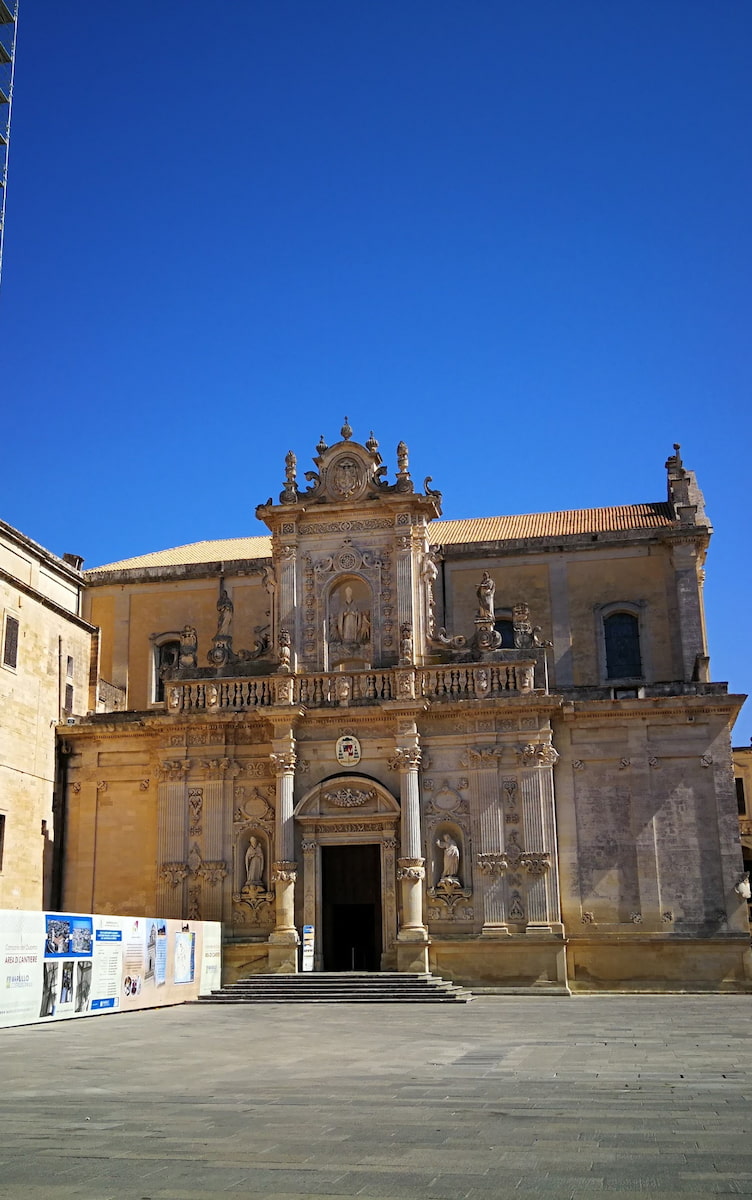
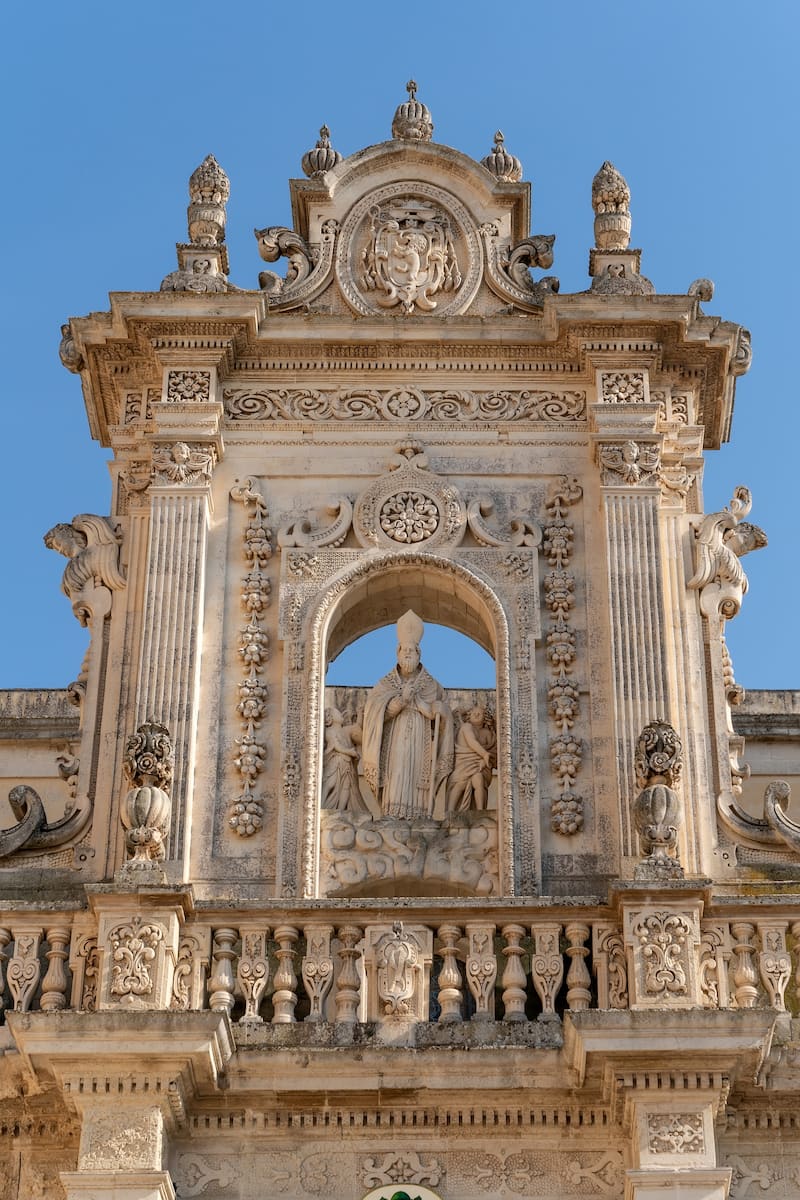
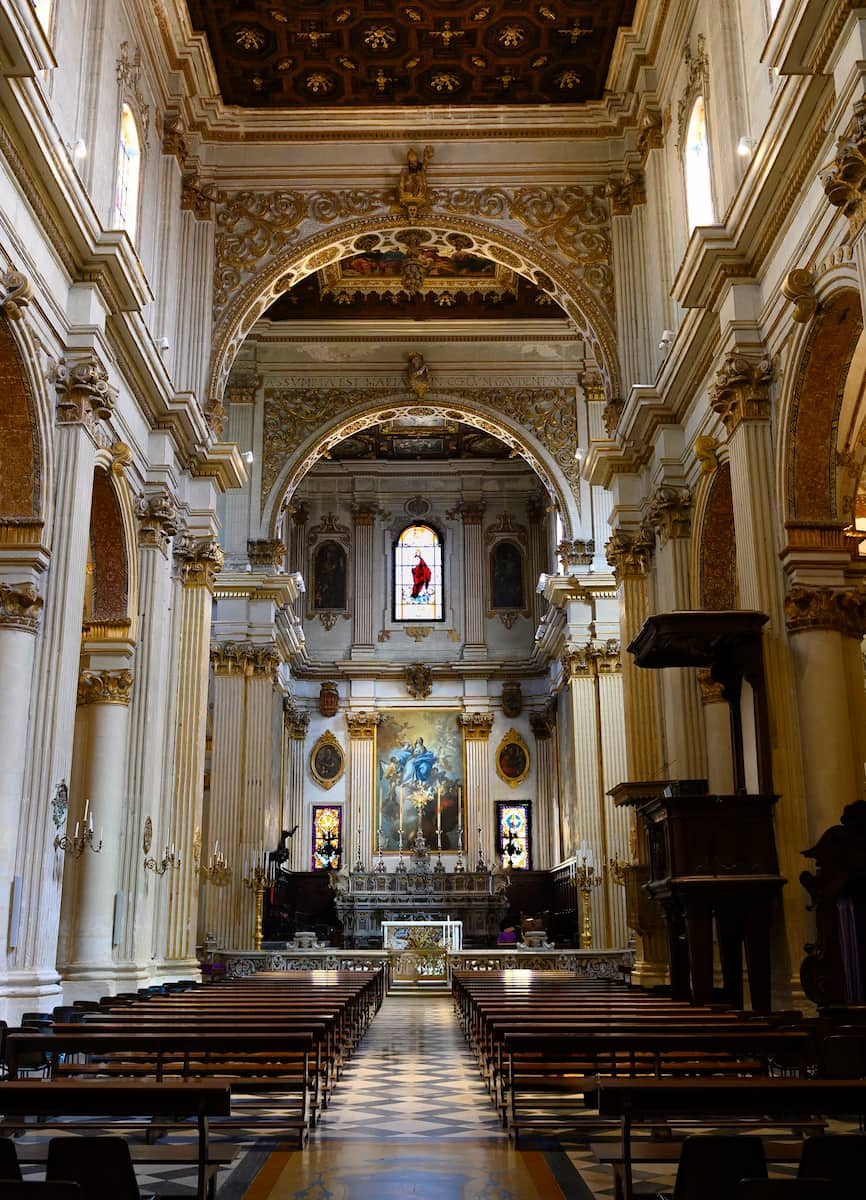
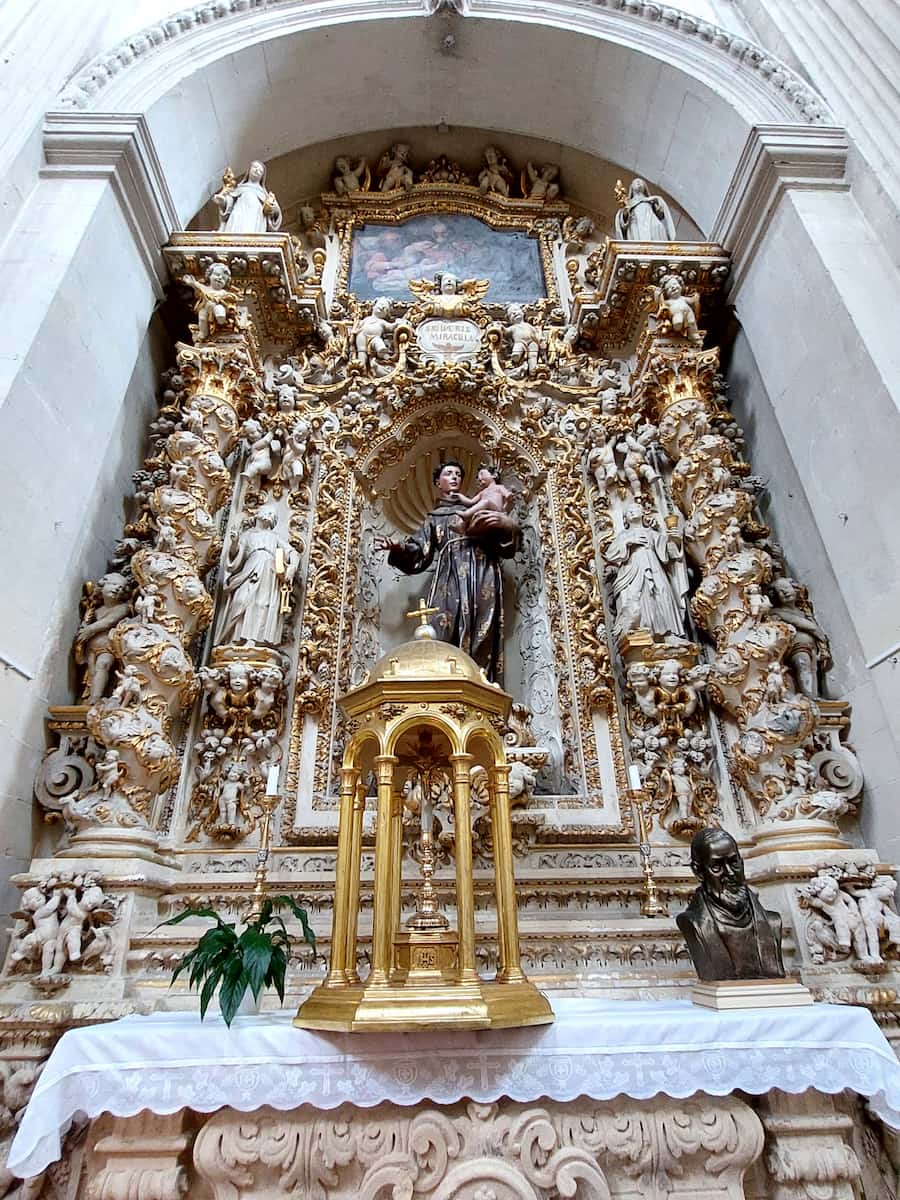
Architectural splendor: The cathedral boasts two facades—one simple Romanesque-style entrance facing Piazza del Duomo—and another more elaborate Baroque façade facing eastward towards Via Vittorio Emanuele II.
Top Tip: Climb up its bell tower for panoramic views over Lecce—it’s one of the best spots for photography!
⭐ Best tour
- Lecce: Sightseeing Tour – Explore the historic city of Lecce on a half-day sightseeing tour from Naples gate, and visit the Cathedral, Roman Amphitheatre, and more. Drive to the heel of Italy along the Sorrentine peninsula for panoramic views.
7. 🏛️ Admire Porta Napoli
Triumphal arch: Porta Napoli, also known as the Arco di Trionfo, is one of Lecce’s most important historical landmarks. Built in 1548 to honor Emperor Charles V, it was constructed as part of the city’s fortifications to protect against Ottoman invasions. The arch was designed by military architect Gian Giacomo dell’Acaya and replaced an older gate, Porta San Giusto, which once stood on the same site. Its neoclassical design, featuring Corinthian columns and a triangular pediment, is a departure from Lecce’s typical Baroque style.
Symbol of power: The pediment of Porta Napoli is adorned with the Habsburg family emblem and decorative elements like cannons and armor, symbolizing Charles V’s military might. The inscription below praises the emperor as a “conqueror of Christians and terror of the Turks,” commemorating his victories in Europe and his efforts to defend southern Italy from Ottoman incursions.
Top Tip: Visit Porta Napoli in the early morning or late afternoon to avoid the midday heat, especially during summer. The arch is beautifully lit at night, making it an excellent spot for evening photography.
⭐ Best tour
- Lecce: City Highlights Guided Tour by Bike – Discover the baroque exuberance of Lecce on a private or shared guided tour by bike. Travel into the different eras of Lecce while passing sights like Piazza del Duomo and the Basilica di Santa Croce.
8. 🕍 Church of Saint Irene
Historical significance: The Church of Sant’Irene (Chiesa di Sant’Irene) is one of Lecce’s most important religious sites, dedicated to the city’s former patron saint, Saint Irene of Thessaloniki. Built between 1591 and 1639 by the Theatine architect Francesco Grimaldi, this church was the spiritual center of Lecce until 1656 when Saint Orontius was declared the new patron saint.
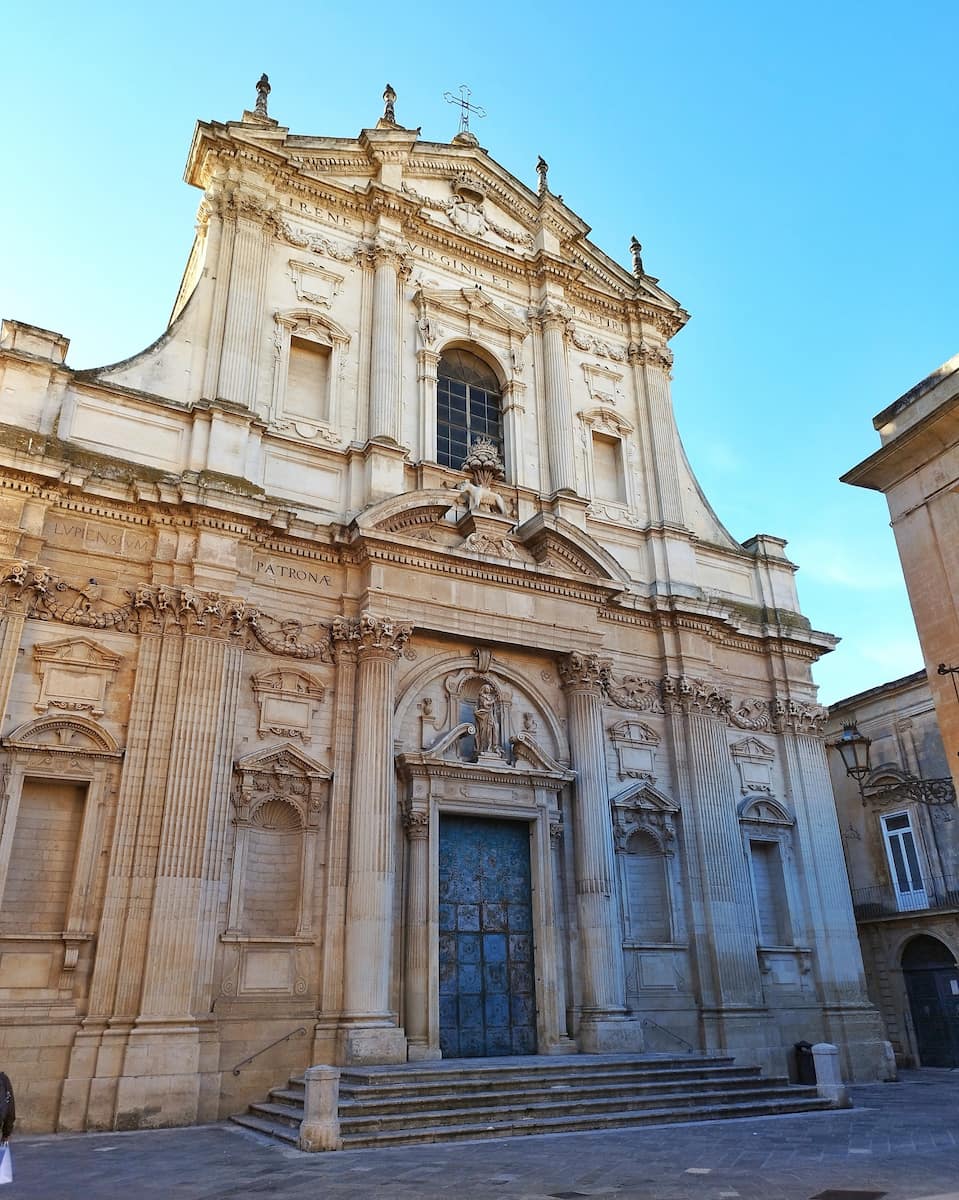
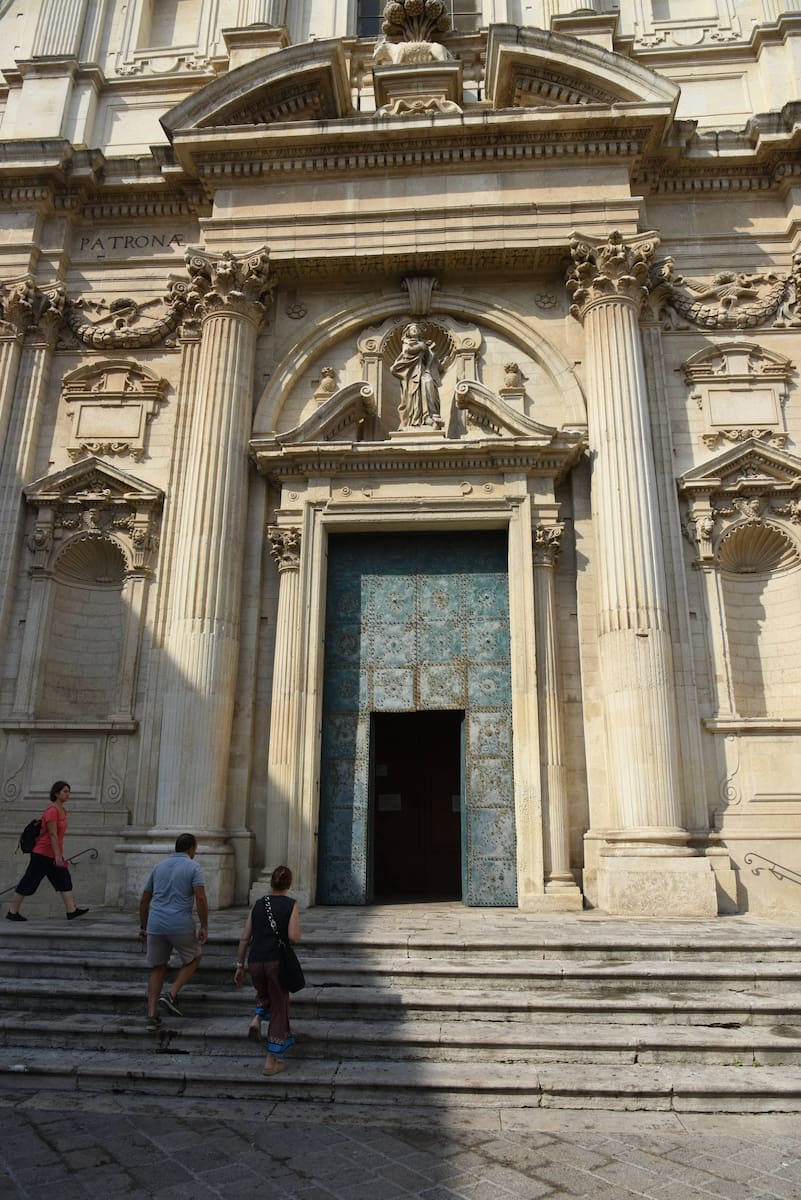
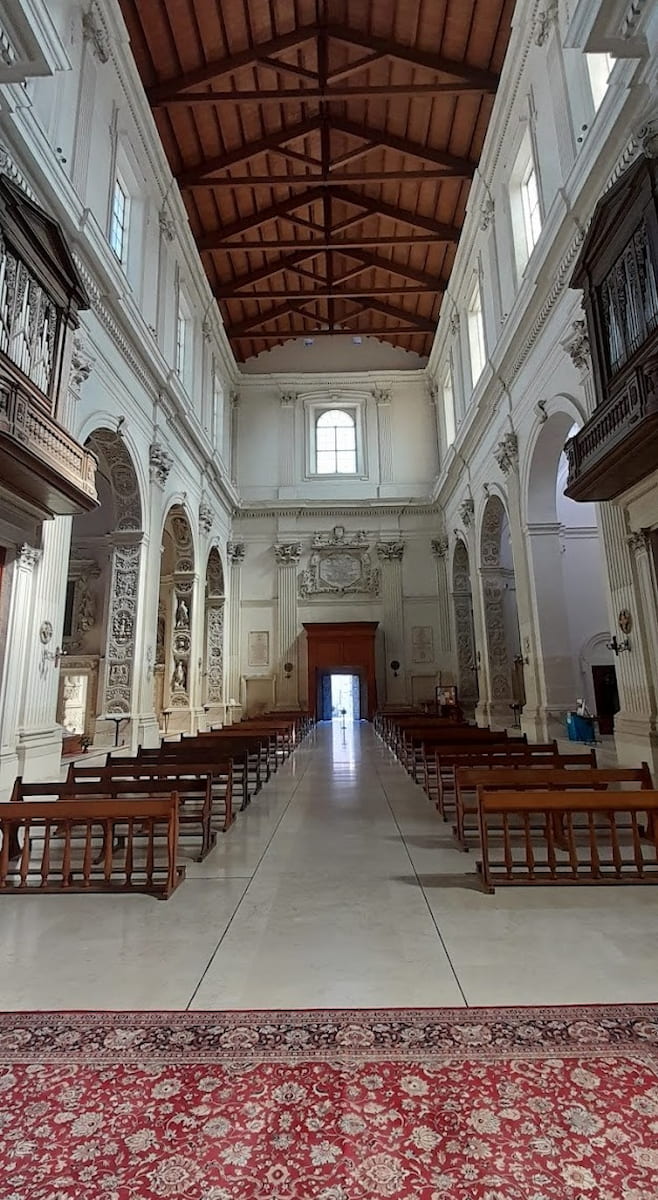
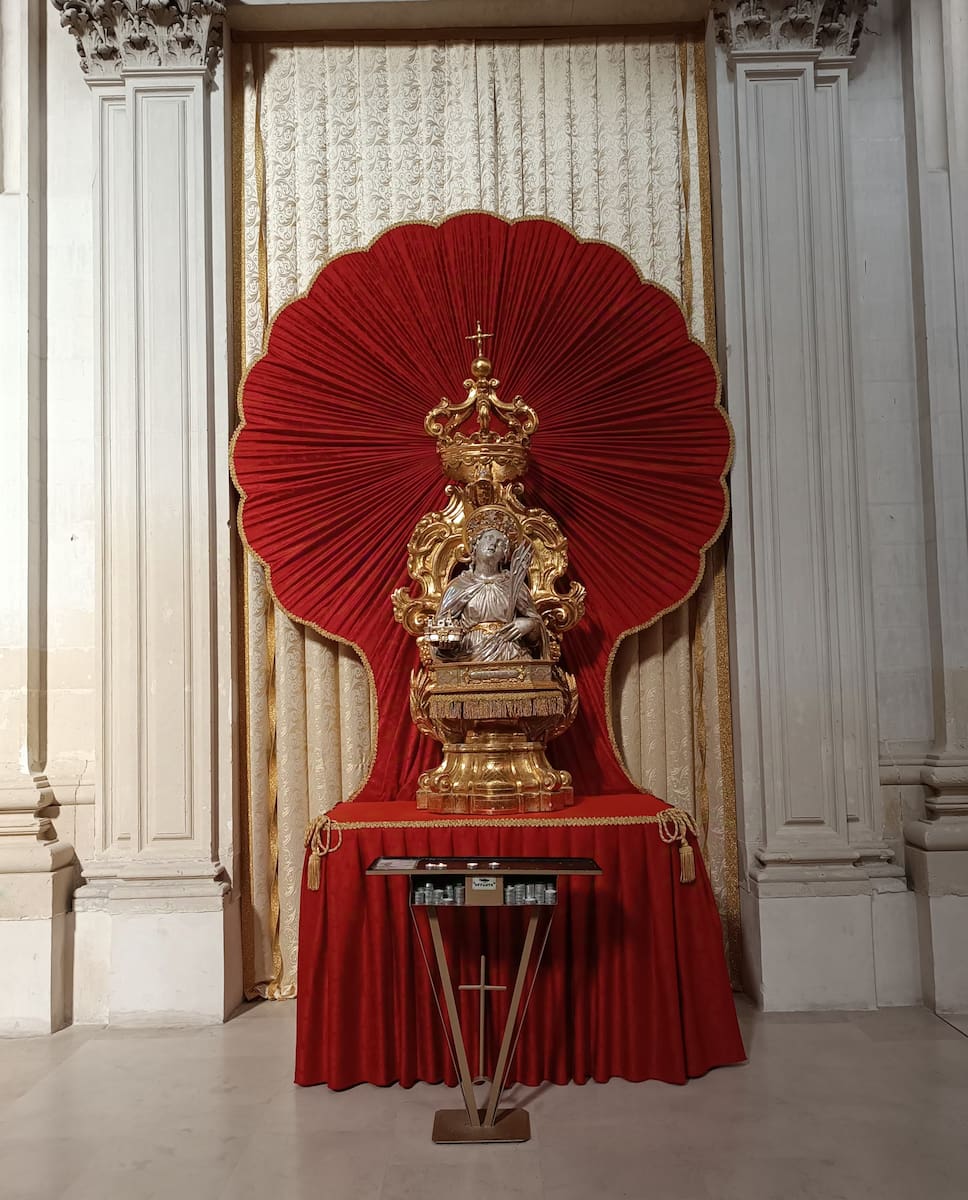
Architectural beauty: The church’s façade is a masterpiece of Baroque design, featuring two orders with superimposed pilasters and festoons. The central portal is crowned by a statue of Saint Irene, sculpted by Mauro Manieri in 1717. Inside, the church has a Latin cross layout with a single nave and several side chapels.
Insider Tip: Visit early in the morning to enjoy the church’s serene atmosphere and avoid crowds. Be sure to explore its deep chapels, which contain beautiful altars dedicated to various saints.
⭐ Best tour
- Lecce: Journey to Discover a Charming Baroque – Uncover the enchanting Baroque beauty of Lecce on this immersive guided tour. Explore iconic landmarks like Porta Napoli, Piazza del Duomo, and the Basilica di Santa Croce, while learning about the city’s rich history and architecture.
Things to Do in Lecce with Kids
1. 🎨 Papier-Mâché Workshops
Creative fun: Lecce is famous for its papier-mâché art, and many local workshops offer hands-on experiences where kids can create their own sculptures. These workshops are typically run by local artisans who have mastered this craft over generations. It’s a fun way for kids to learn about traditional Italian art while getting creative.
Artisan culture: The studios are often located within small alleys in Lecce’s old town, giving families a chance to explore lesser-known parts of the city while engaging in a unique activity. Many workshops allow children to take home their creations as souvenirs.
Top Tip: Ask locals or check online reviews for recommendations on which studios offer family-friendly sessions—you’ll find some hidden gems that aren’t listed in typical tourist guides!
⭐ Best tour
- PAPIER- MACHÉ WORKSHOP – Explore Lecce’s ancient art through an exclusive experience. Uncover secrets and craft handmade papier-mâché in this unique adventure.
2. 🎭 Teatro Romano di Lecce
Ancient Roman theatre: The Teatro Romano di Lecce offers a fascinating glimpse into ancient Roman life. Discovered by accident in 1929 during excavations near Palazzo D’Arpe, this theatre dates back to the Augustan period (27 BC – AD 14). Though smaller than Lecce’s Roman Amphitheatre, it could seat around 5,000 spectators and primarily hosted comedies and tragedies rather than gladiatorial games.
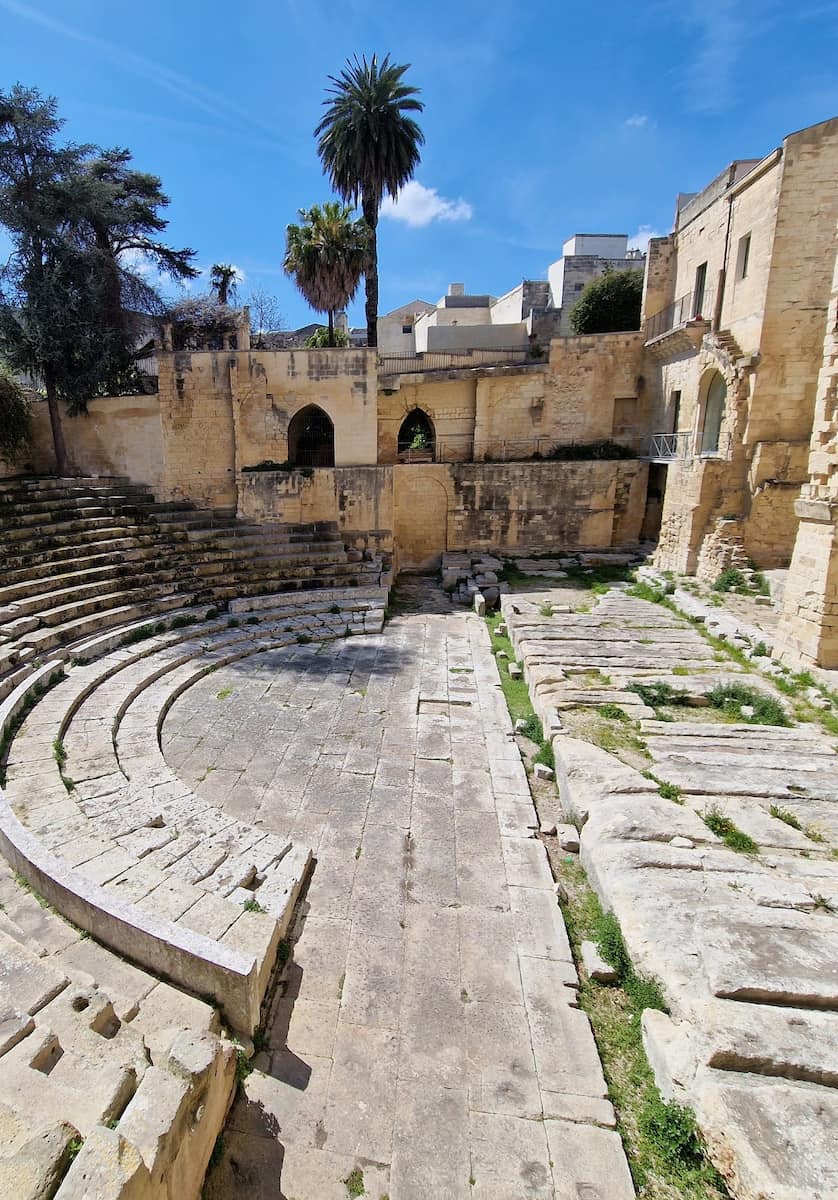
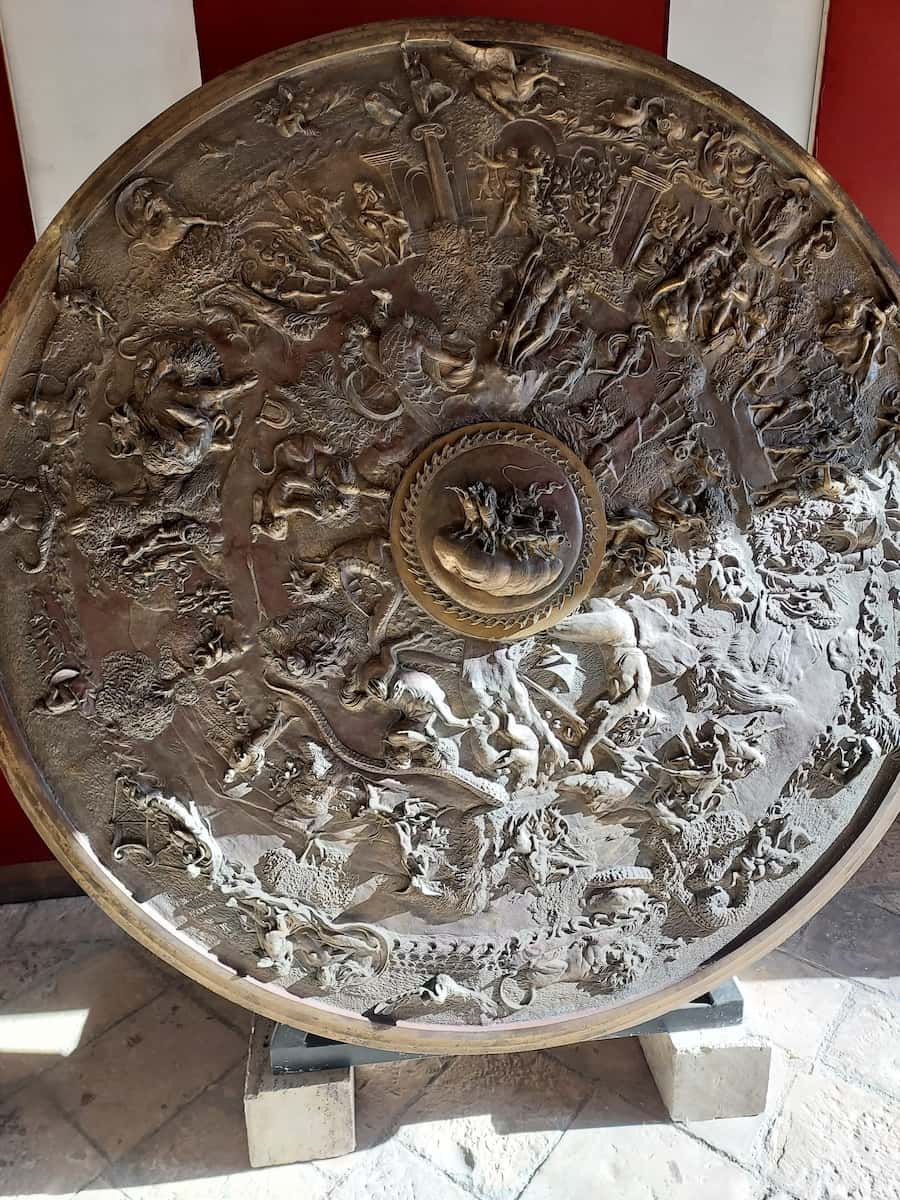
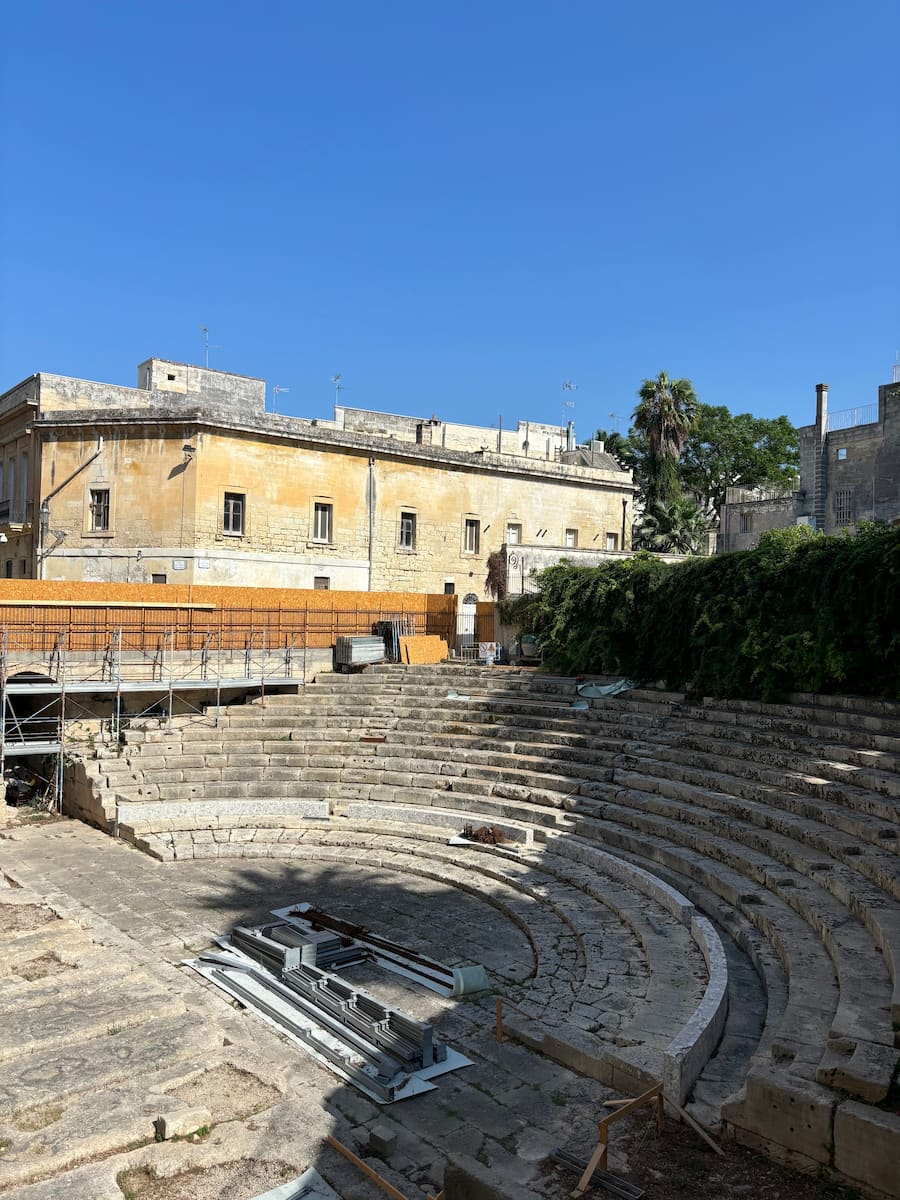
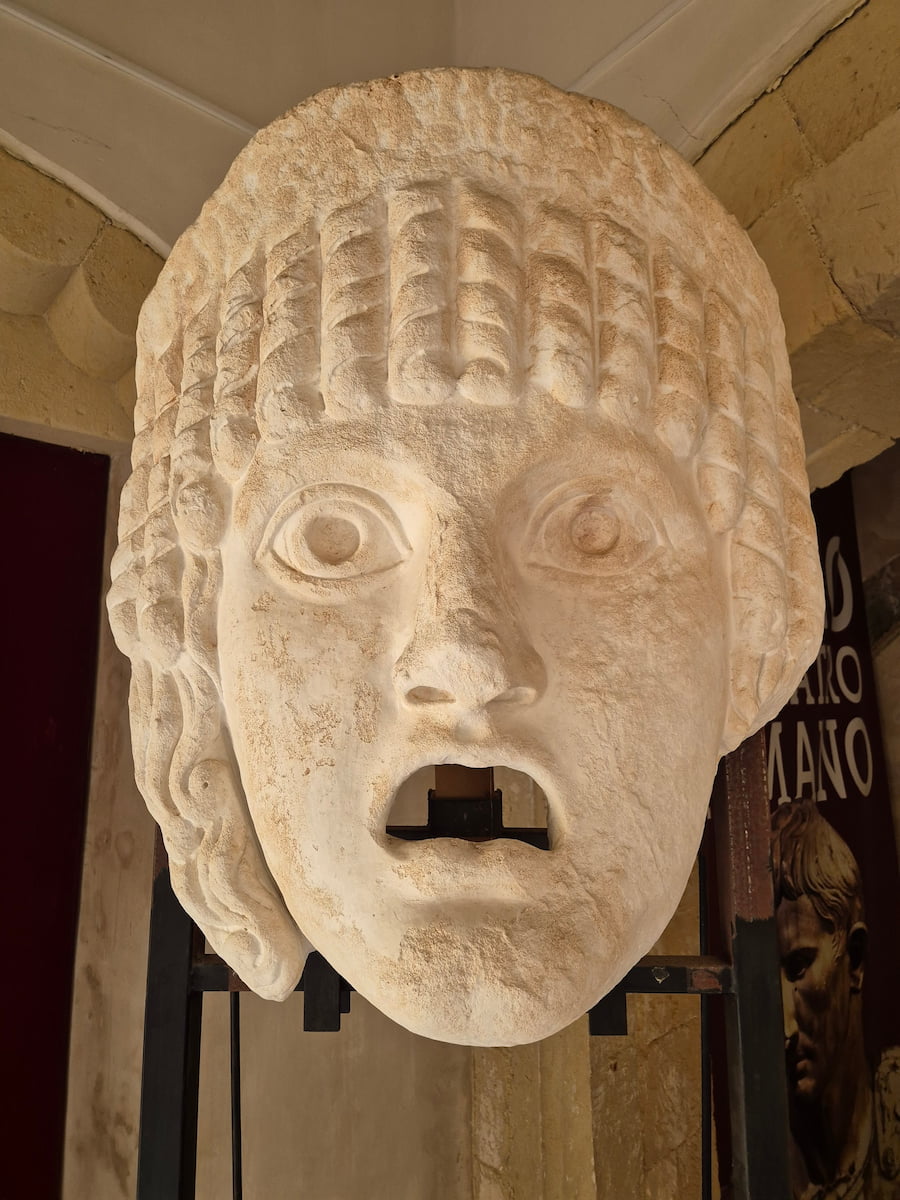
Architectural marvel: The theatre’s design includes six wedges of seating (cavea) divided by staircases, with an orchestra area designated for choirs. Decorative fragments found at the site suggest that parts of it date back to Emperor Augustus’ reign, while marble statues from later periods are now housed in the nearby Museo del Teatro Romano.
Time Saver: Combine your visit to Teatro Romano with nearby attractions like Piazza Sant’Oronzo and Museo Faggiano, all within walking distance from each other.
⭐ Best tour
- Baroque Lecce Revealed – Did you know that Thomas Ashe named Lecce the “most beautiful city in Italy”? Together with a professional local guide, explore this wonderful city. It is a must for lovers of art and culture!
3. 🎨 Visit MUST (Museo Storico Città di Lecce)
Artistic journey: The MUST (Museo Storico Città di Lecce) is housed in a former 15th-century monastery and showcases both contemporary art and historical artifacts from Lecce’s past. The museum features rotating exhibitions as well as permanent collections that cover three key periods: Messapian times, Roman imperial rule, and the Middle Ages.
Interactive experience: MUST also offers multimedia experiences such as virtual tours that allow visitors to explore Lecce’s Baroque churches in 3D. This makes it an engaging stop for both art lovers and history buffs alike.
Top Tip: Admission is free for children under 10 years old—making it an affordable option for families visiting Lecce.
Free Things To Do in Lecce
1. 🏙️ Stroll Through Piazza Sant’Oronzo
City square charm: One of the best free things to do in Lecce is simply wandering around Piazza Sant’Oronzo, where you can admire landmarks like the column dedicated to Saint Orontius (Orontius of Lecce) and part of the excavated Roman Amphitheatre. This lively square is at the heart of city life and offers plenty of photo opportunities.+
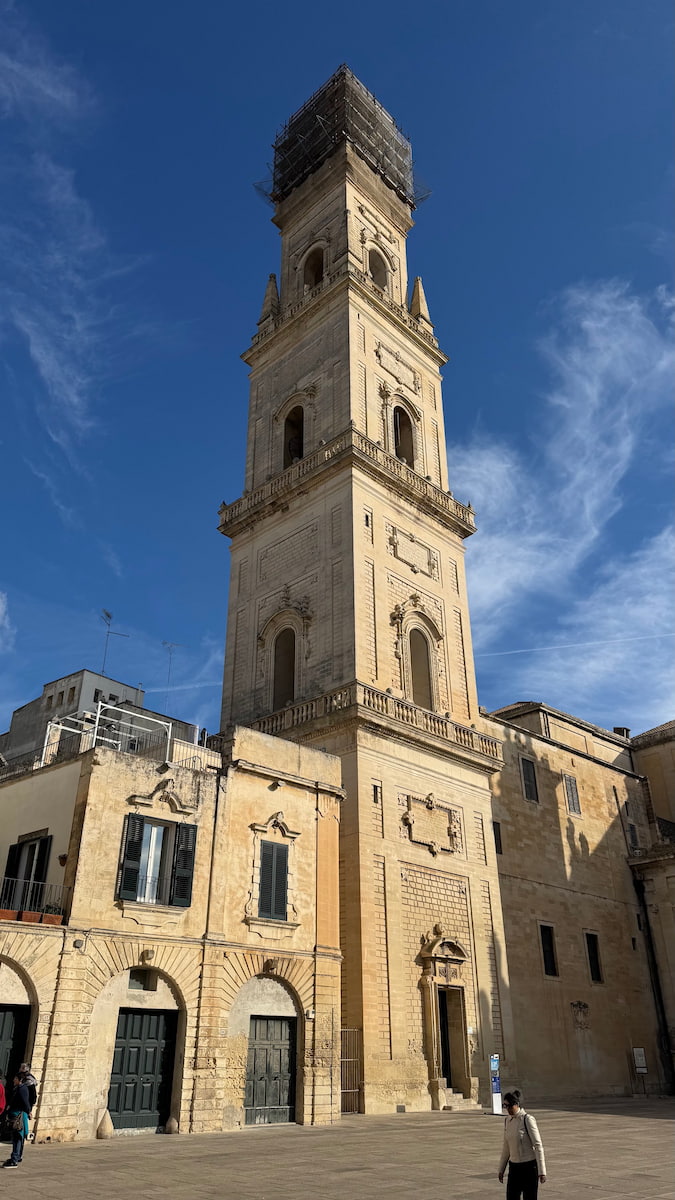
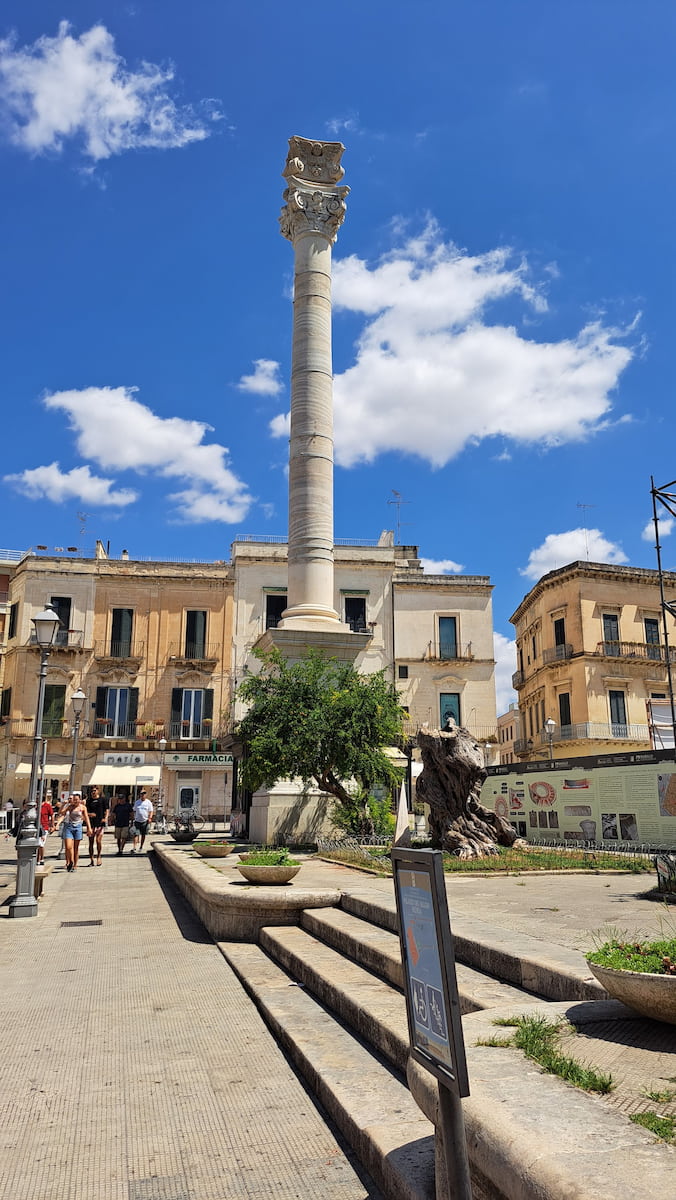
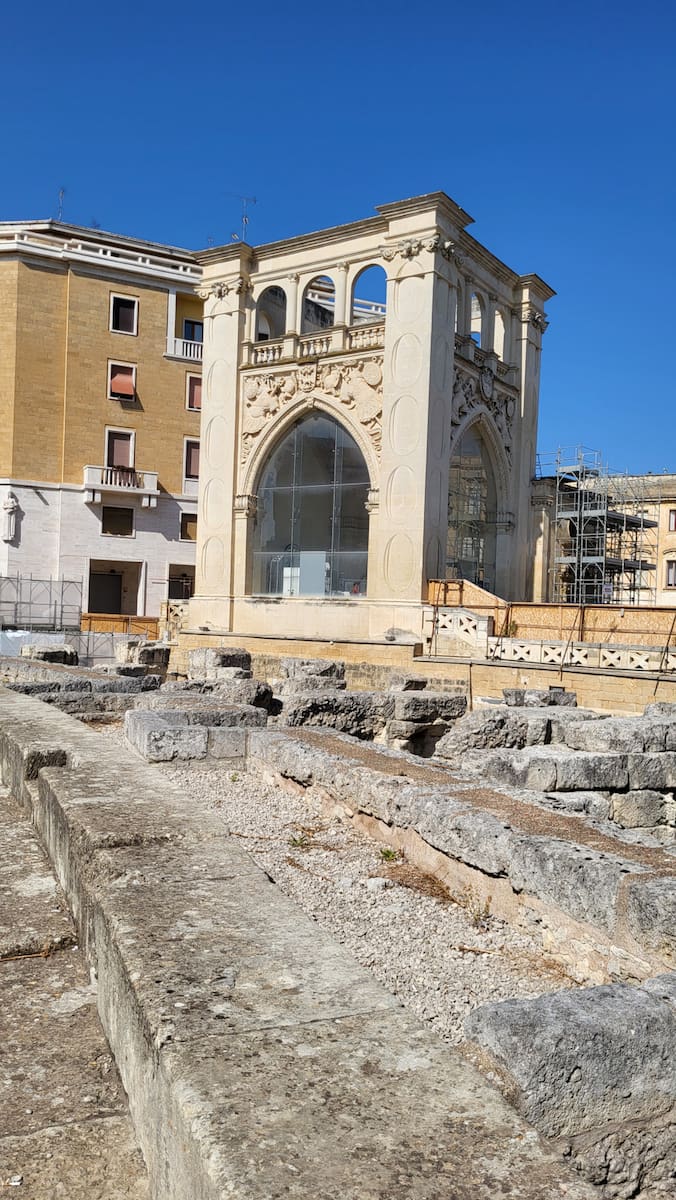
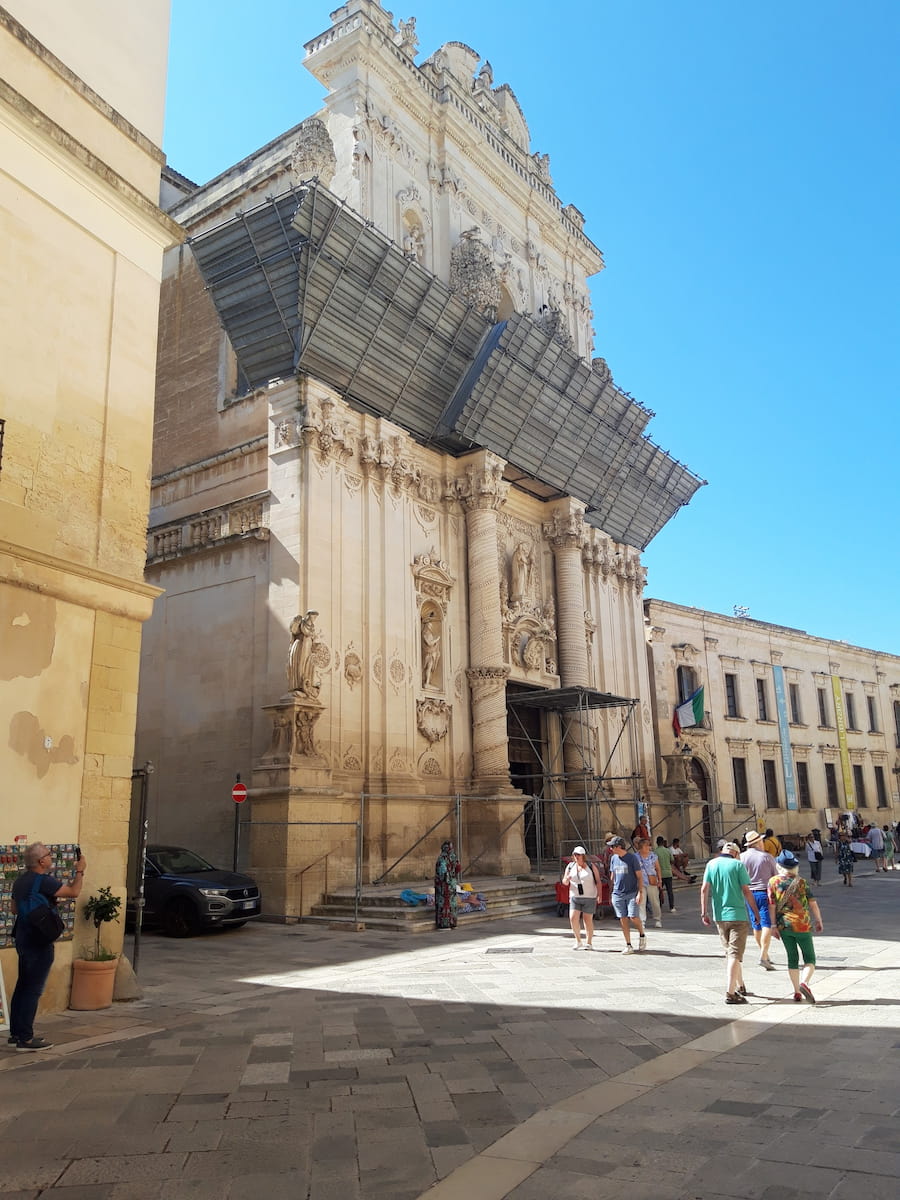
Local life: Grab a coffee from one of the nearby cafes and enjoy people-watching from one of the benches around the square—it’s one of the best ways to soak up local life without spending much!
Top Tip: Visit during sunset when golden light bathes the square—it’s quieter at this time too, making it ideal for photos without crowds.
2. 🚪 Visit Porta Rudiae
Historic gateway: Start your exploration at Porta Rudiae, one of the remaining city gates that once protected Lecce from invaders. This gate is adorned with statues representing important figures from Lecce’s past and offers an impressive entrance into the old town.
Vibrant atmosphere: Besides its historical importance, Piazza Sant’Oronzo is a lively gathering spot filled with cafes, shops, and restaurants. It’s also where locals come together during festivals like La Festa di Sant’Oronzo, held annually in August, with parades, concerts, and fireworks celebrating their beloved saint.
Insider Tip: Don’t miss Porta Napoli, another historic gate just minutes from Porta Rudiae—both gates are great spots for photos, especially at sunset when they’re beautifully lit by golden light.
3. 🏰 Torre di Belloluogo
Medieval architecture: The Torre di Belloluogo is an impressive medieval tower located just outside Lecce’s historic center. Built between the 13th and 14th centuries during the Angevin period, this cylindrical tower was originally a military outpost. It later became the residence of Maria d’Enghien, Countess of Lecce and Queen of Naples. The tower is surrounded by a moat filled with water and features beautiful frescoes inside its chapel.
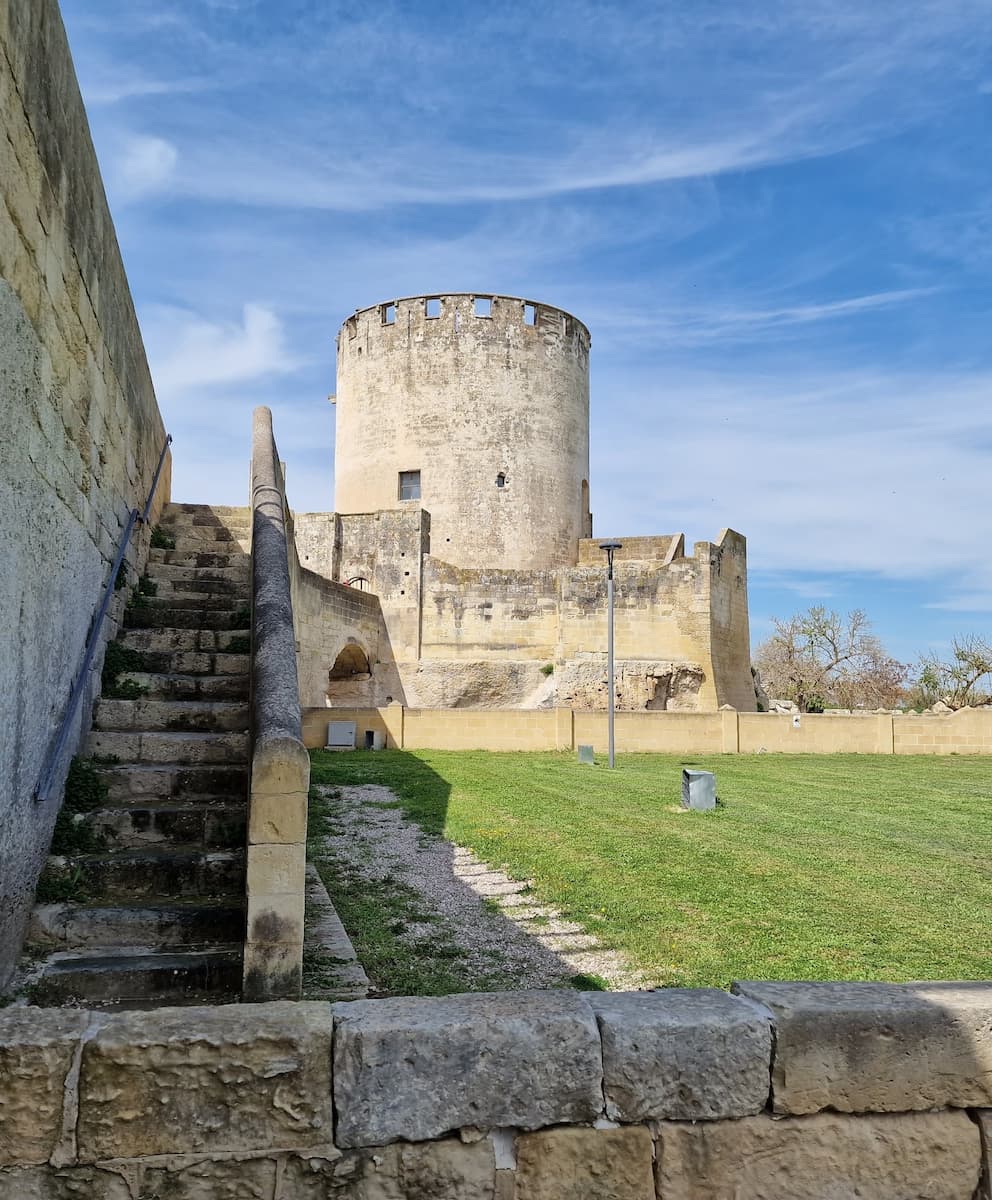
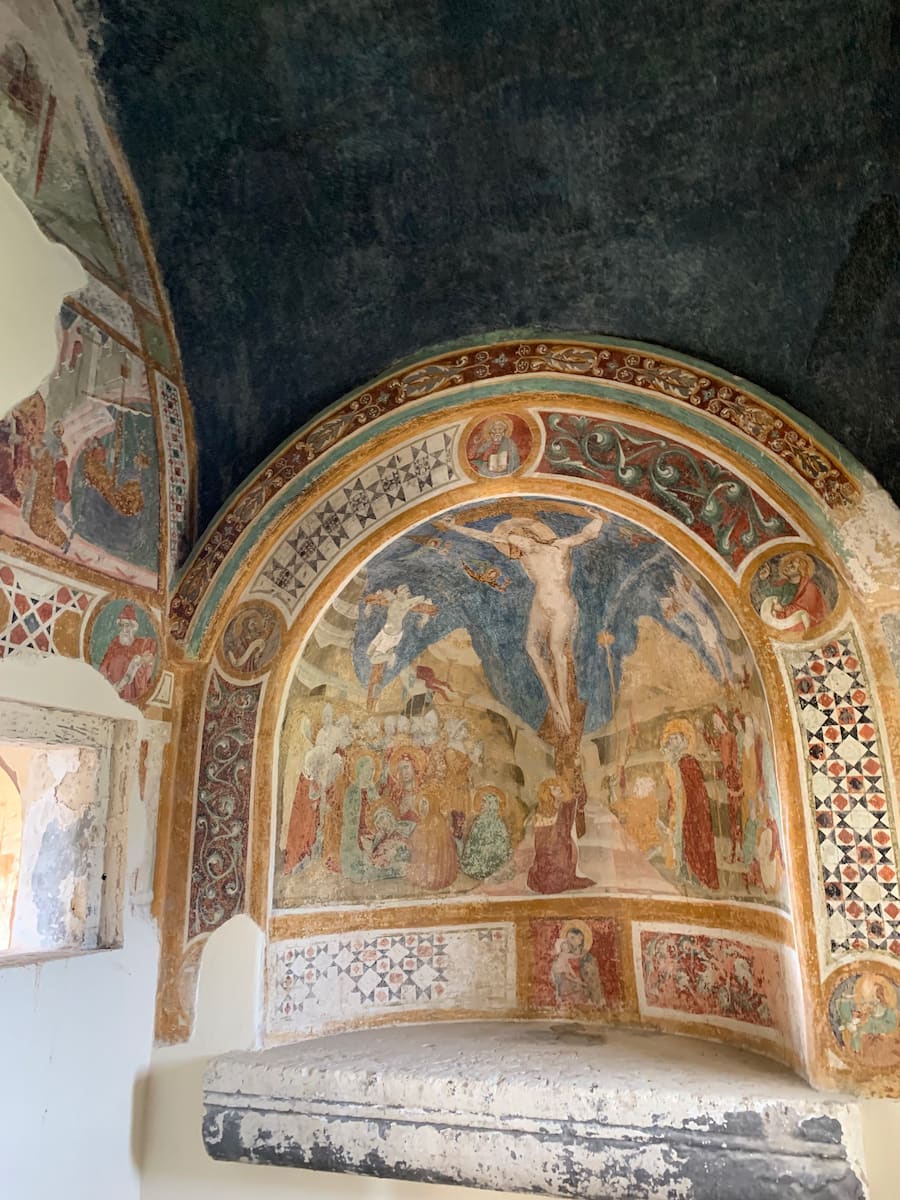
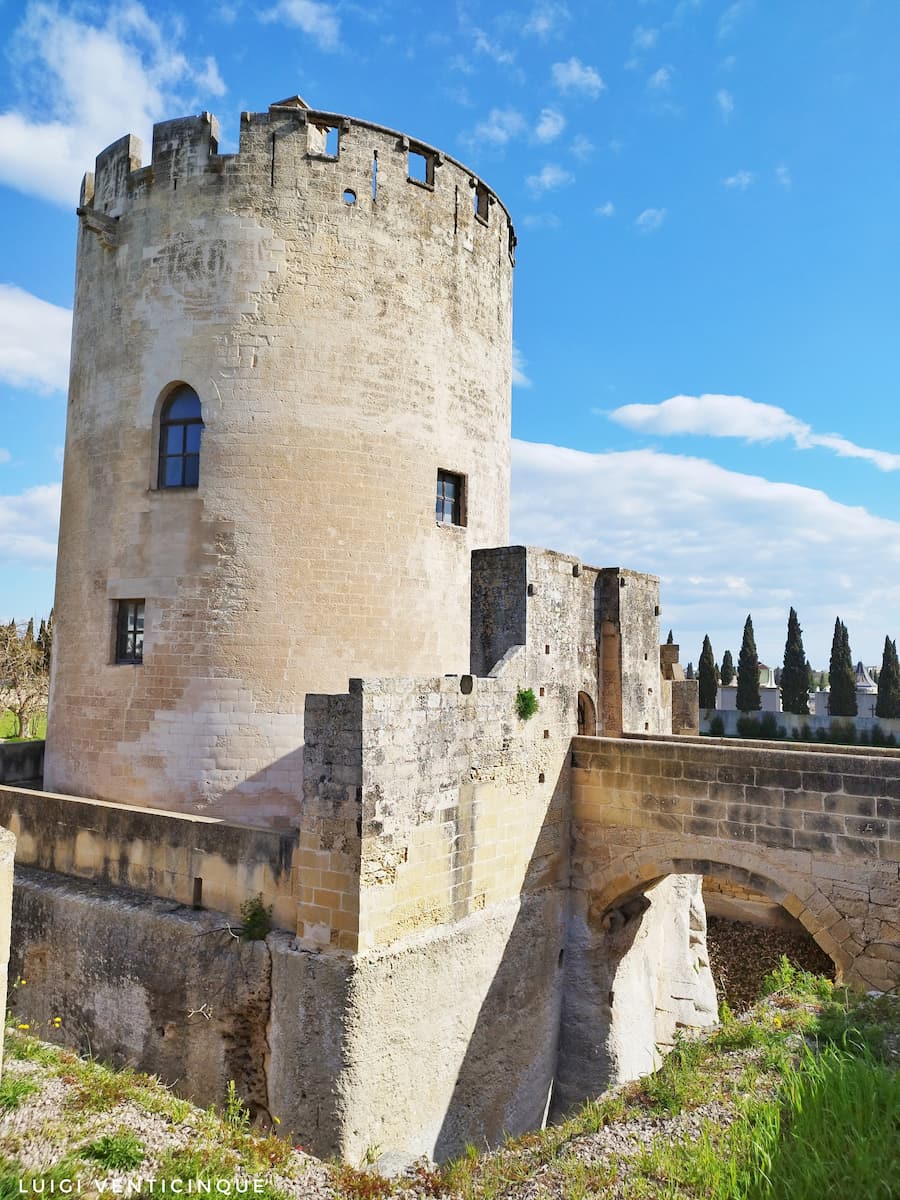
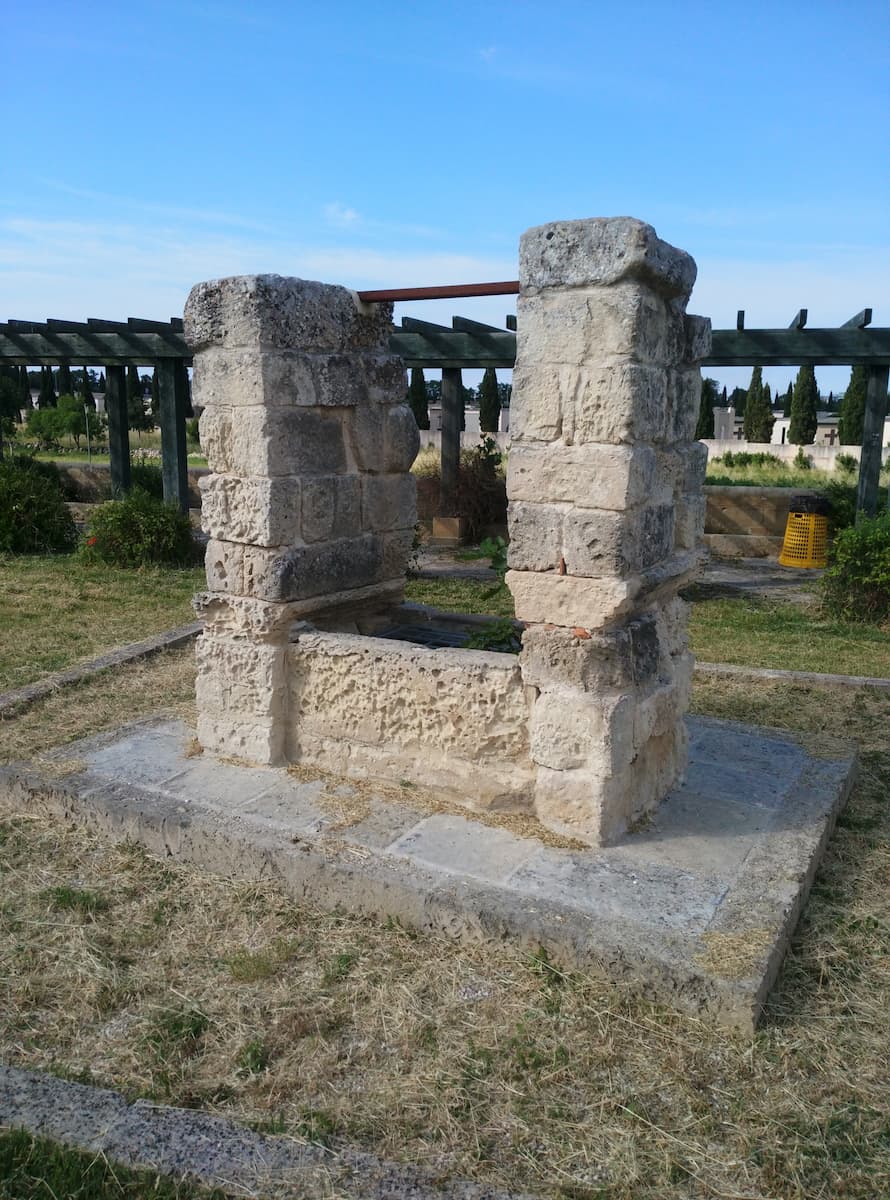
Historical significance: The frescoes inside depict scenes from the life of Saint Mary Magdalene and date back to the early 15th century. The tower’s architecture is similar to that of other military structures in Lecce but stands out due to its well-preserved moat and interior decorations.
Top Tip: Visit early in the day to avoid crowds and enjoy a peaceful walk around the surrounding park—Parco di Belloluogo—which offers beautiful views of the tower.
4. 🌳 Relax at Parco di Belloluogo
Urban oasis: Adjacent to Torre di Belloluogo, Parco di Belloluogo is one of Lecce’s largest green spaces. This park offers a peaceful retreat from the bustling city center with walking paths, picnic areas, and playgrounds for children. It’s a perfect spot for families or anyone looking to relax in nature while still being close to historical landmarks.
Natural beauty: The park features lush greenery, ancient olive trees, and scenic views of the medieval tower. It’s also home to several species of birds and small wildlife, making it a great place for nature lovers.
Money Saver: Entrance to Parco di Belloluogo is free. Pack a picnic and enjoy a budget-friendly afternoon surrounded by nature and history.
5. ⛪ Discover Ex Convento degli Agostiniani
Baroque beauty: The Ex Convento degli Agostiniani Scalzi, located on Viale Michele De Pietro, is a stunning example of Baroque architecture in Lecce. Built in 1649 by the Augustinian monks, this convent has been beautifully restored and now serves as a cultural center hosting exhibitions, concerts, and events. The attached church, Santa Maria di Ognibene, features intricate Baroque details both inside and out.
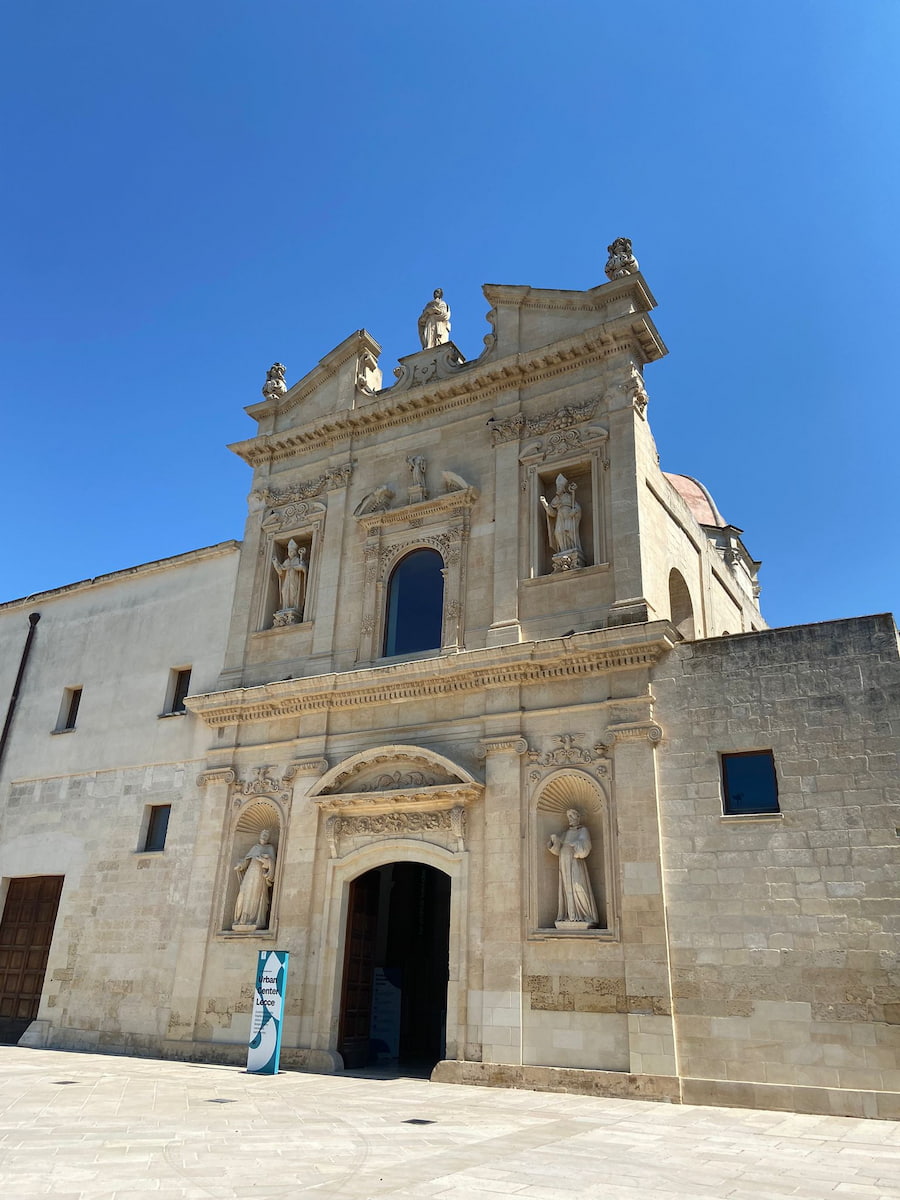
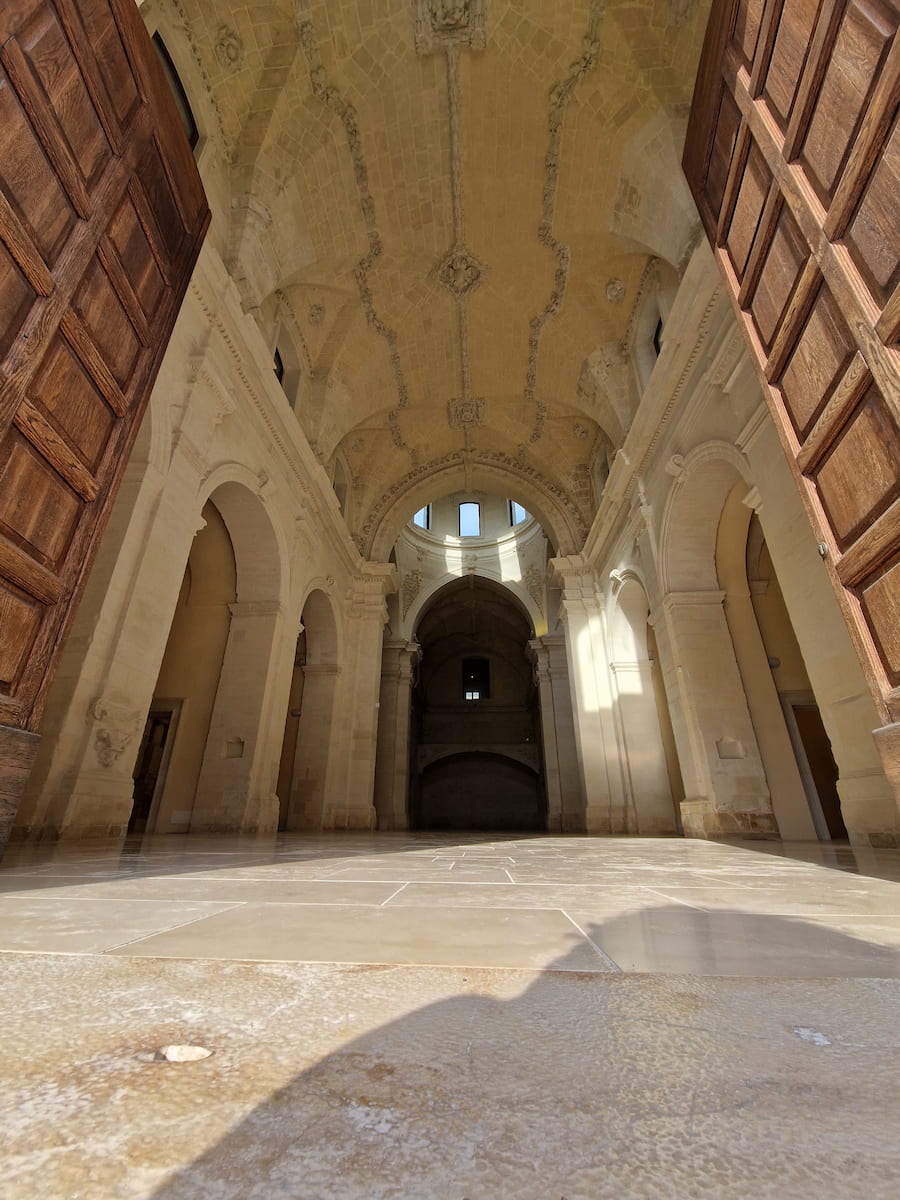
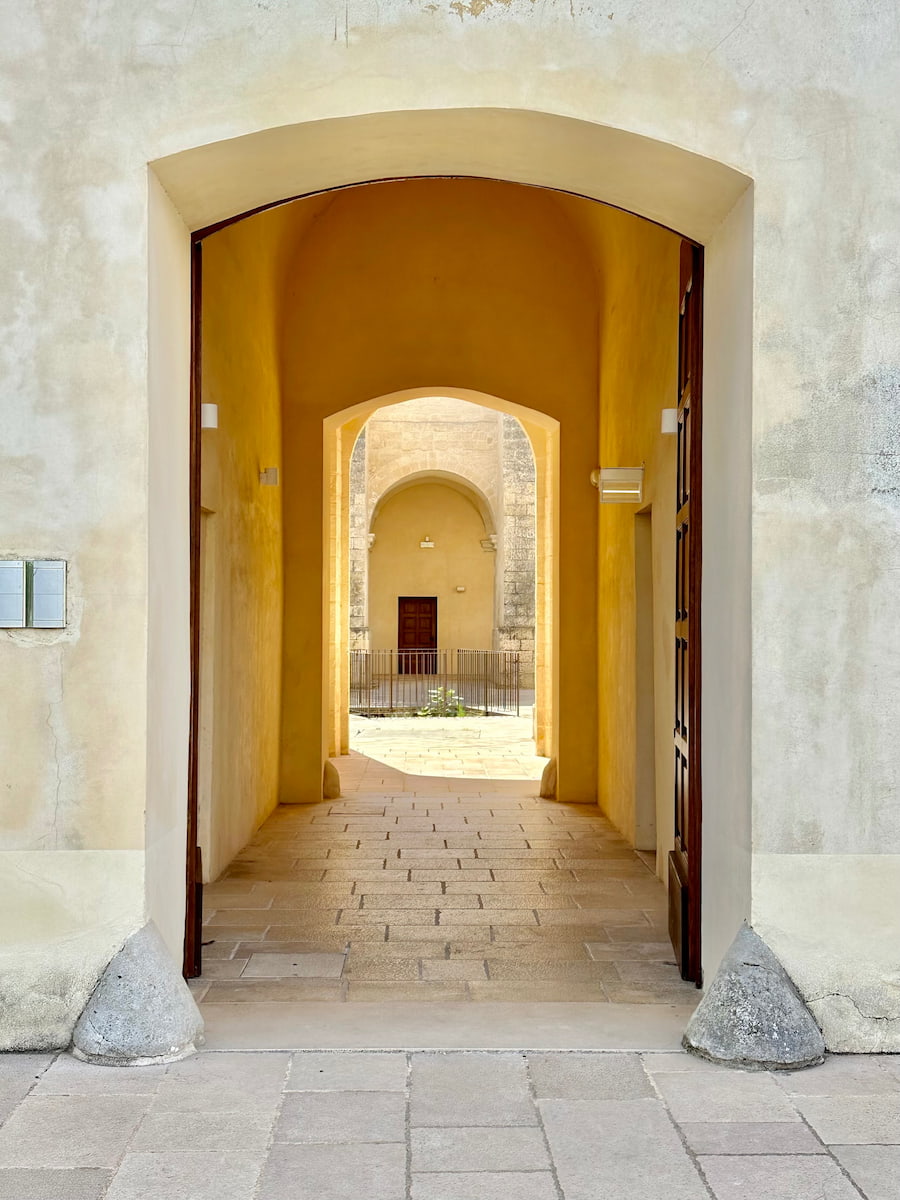
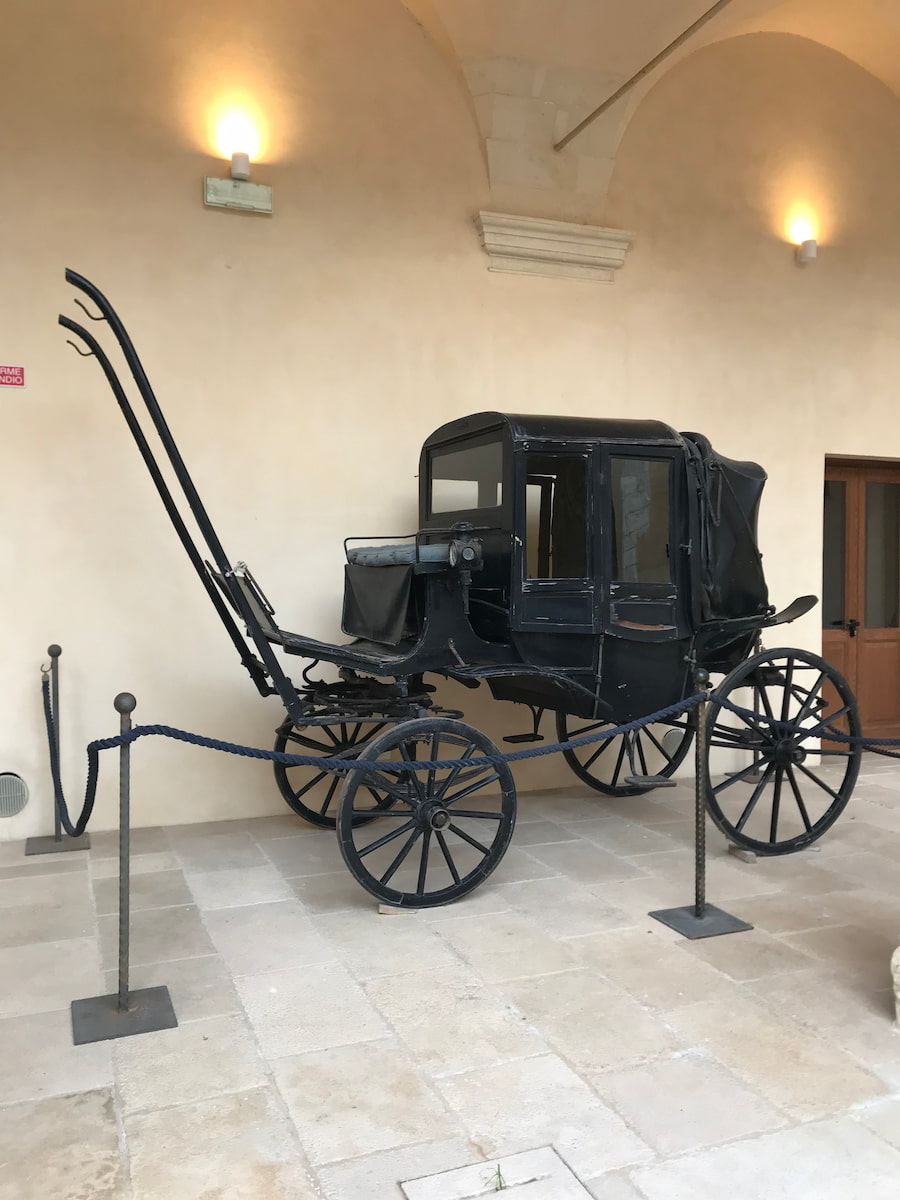
Cultural hub: After being abandoned for many years following the suppression of religious orders in 1810, the convent has been repurposed as a venue for cultural activities. Today it stands as a testament to Lecce’s ability to preserve its historical buildings while giving them new life.
Insider Tip: Check ahead for any special exhibitions or events happening during your visit—many are free or low-cost and offer unique insights into local culture.
6. 🌿 Stroll through Giardini Pubblici Giuseppe Garibaldi
Green retreat: Located near Piazza Sant’Oronzo, Giardini Pubblici Giuseppe Garibaldi (also known as Villa Comunale) is one of Lecce’s most popular public parks. Established in 1818 as part of an urban beautification project, this park offers shaded walking paths lined with trees and flowers—a perfect spot for an afternoon stroll or relaxing break from sightseeing.
Historical charm: The park has retained much of its original layout with wide promenades designed for leisurely walks. Statues dedicated to Italian heroes like Giuseppe Garibaldi add historical significance to this tranquil space.
Time Saver: Visit early in the morning or late afternoon when it’s less crowded—perfect for taking photos or enjoying some quiet time.
Seasonal Activities
🌞 Summer (June – August)
Summer Festivals and Events: Lecce comes alive during the summer months with a vibrant mix of music, food, and cultural festivals. One of the biggest events is the Notte della Taranta (August), a folk music festival dedicated to the traditional dance of pizzica. Held across various towns in the Salento region, this festival culminates in a massive concert in Melpignano, just a short drive from Lecce. It’s an electrifying event that draws thousands of visitors every year.
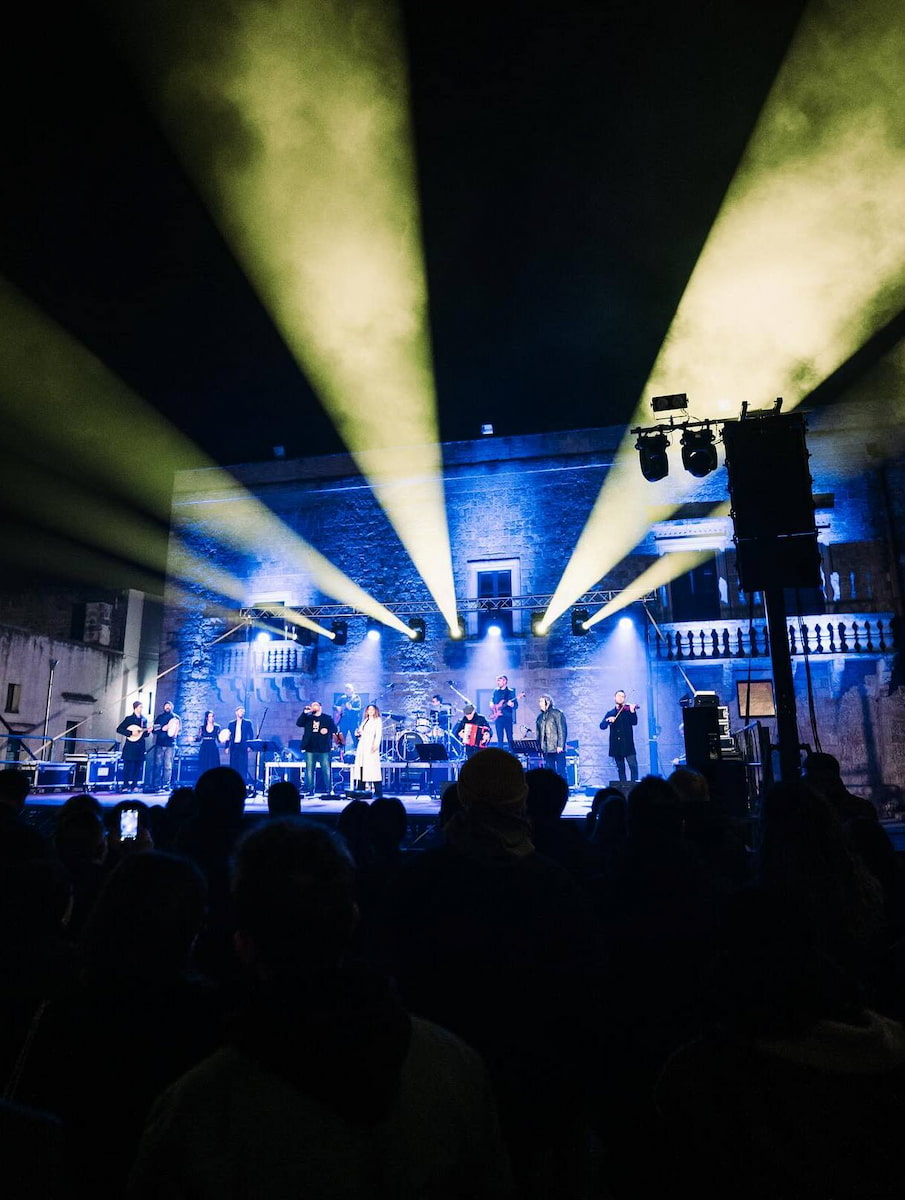
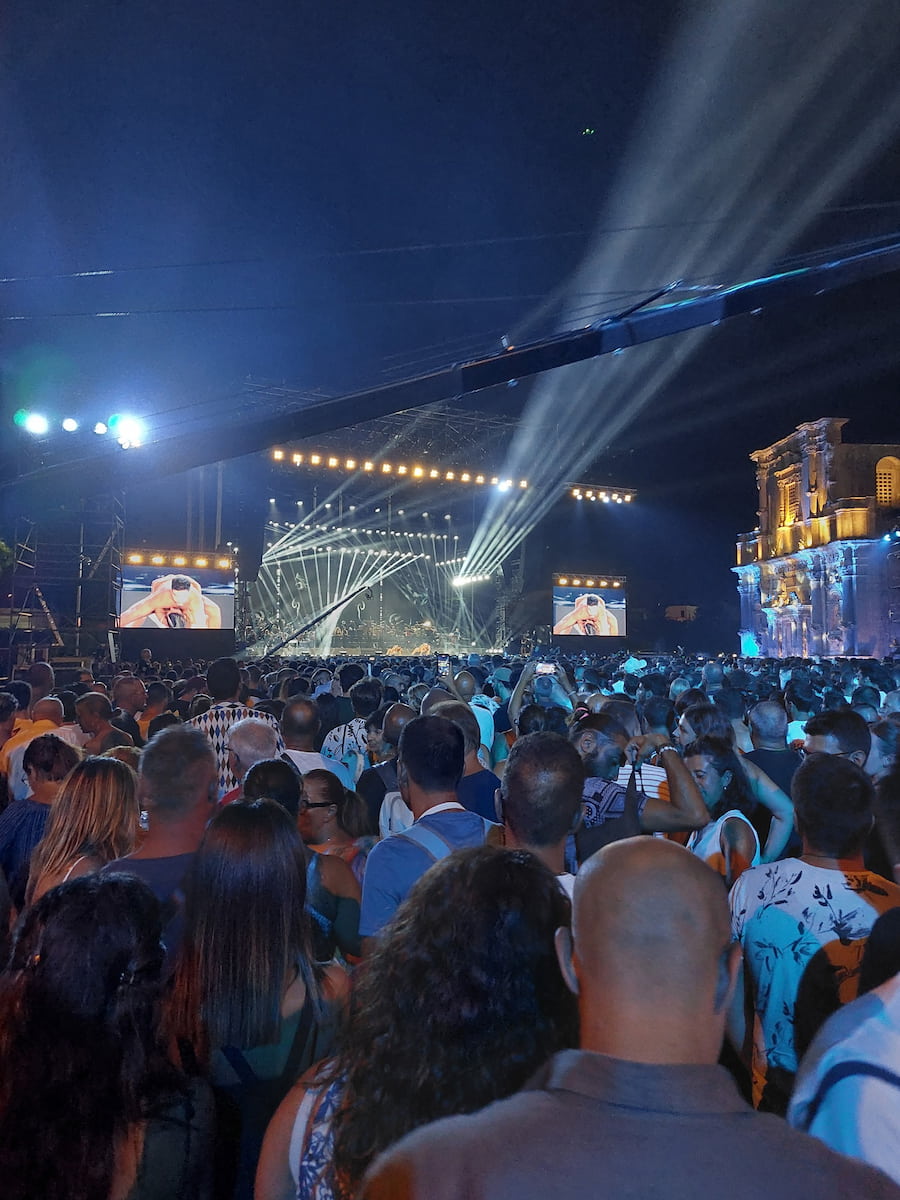
Open-Air Concerts: Throughout the summer, Lecce’s historic squares like Piazza Sant’Oronzo and Piazza del Duomo host open-air concerts featuring both local and international artists. These concerts are often free and provide an unforgettable backdrop with Lecce’s Baroque architecture illuminated at night.
Top Tip: Arrive early to grab a good spot at the concerts, especially for popular events like Notte della Taranta. Booking accommodations in advance during August is also recommended as this is peak tourist season.
❄️ Winter (December – February)
Christmas Markets and Nativity Scenes: Lecce transforms into a festive wonderland during the holiday season. The streets are adorned with twinkling lights, and Piazza del Duomo becomes the heart of Christmas celebrations. The Fiera dei Pupi (December 8 – January 6) is an annual market where artisans sell handcrafted nativity figures made from Lecce stone and papier-mâché. It’s a great place to pick up unique souvenirs while soaking in the holiday spirit.
Nativity Scene Exhibitions: Throughout December, many churches in Lecce display elaborate nativity scenes, some made entirely from local materials like Lecce stone. The Presepe Vivente di Tricase, located about 40 minutes from Lecce, is one of the largest living nativity scenes in Italy and runs from December 25 to January 6.
Insider Tip: Visit Lecce’s Christmas markets during weekdays to avoid weekend crowds. Also, bundle up—while winters are mild compared to northern Italy, evenings can get chilly.
🌸 Spring (March – May)
Cultural Awakening: Spring is a beautiful time to visit Lecce as the city begins to bloom with flowers and outdoor events. One of the highlights is the Settimana Santa (Holy Week), which takes place during Easter (dates vary annually). During this week, Lecce hosts solemn processions through its historic streets, with participants dressed in traditional robes carrying religious icons.
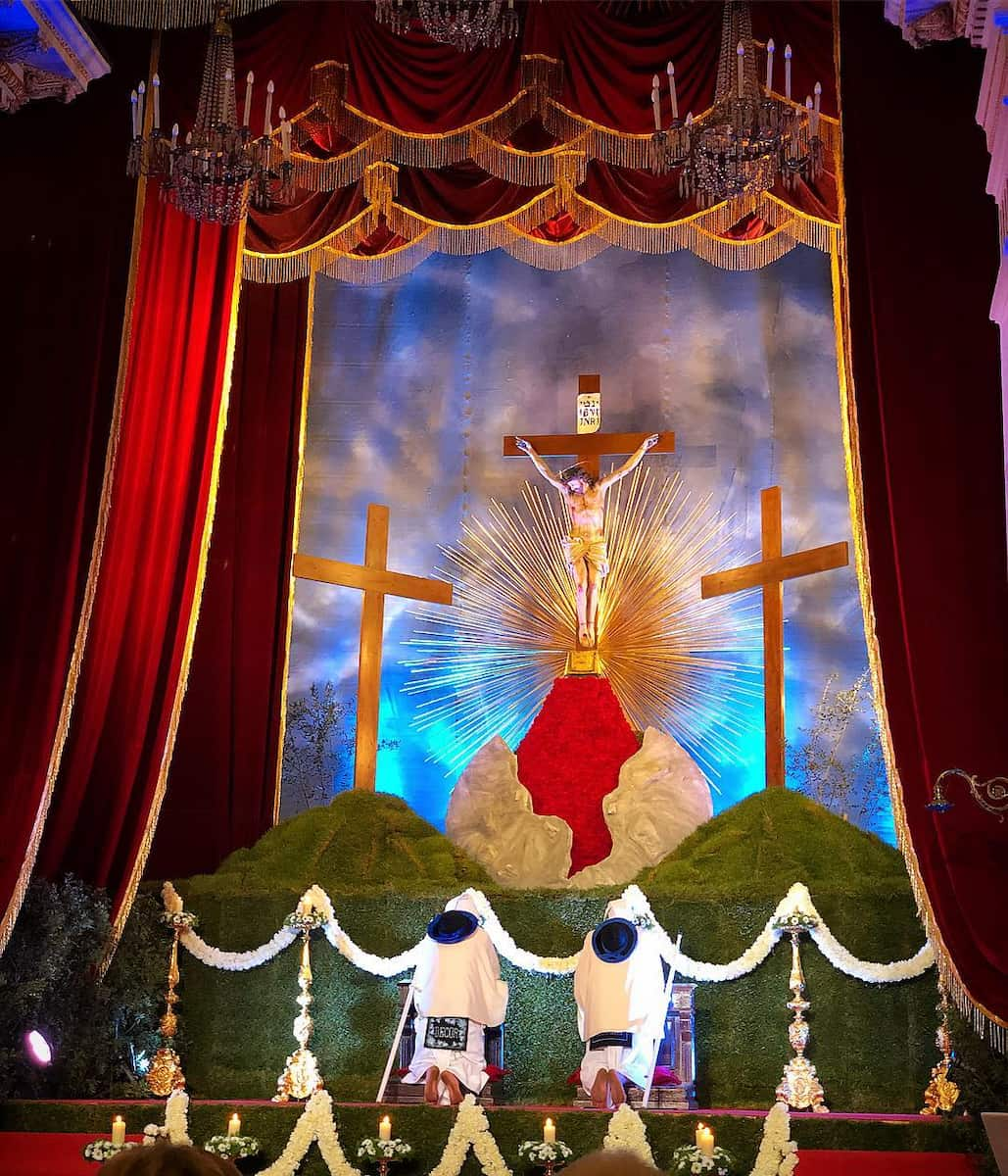

Festival del Cinema Europeo: Held annually in April, this film festival showcases European cinema and attracts filmmakers and movie enthusiasts from across Europe. The festival takes place at various venues around Lecce, offering screenings, workshops, and discussions.
Top Tip: Spring is one of the best times to visit Lecce due to mild weather and fewer tourists. If you’re visiting during Settimana Santa, plan your accommodations early as it’s a popular time for both locals and visitors alike.
🍂 Autumn (September – November)
Harvest Season Celebrations: Autumn in Lecce brings cooler temperatures and a focus on food and wine. The Festa di San Martino (November 11) celebrates the new wine harvest with feasts featuring roasted chestnuts, local wines, and traditional dishes. This festival is celebrated across Puglia but is particularly lively in Lecce’s surrounding countryside.
Baroque Festival: Every September, Lecce hosts the Festival del Barocco, which celebrates Baroque music and culture. Concerts are held in some of Lecce’s most beautiful Baroque churches like Basilica di Santa Croce, creating a magical atmosphere for lovers of classical music.
Money Saver: Autumn is considered off-peak season for tourism in Lecce. You’ll find lower prices on accommodations and fewer crowds at major attractions like Castello Carlo V or Duomo di Lecce, making it an ideal time for budget-conscious travelers.
Day Trips from Lecce
1. 🏘️ Alberobello
UNESCO World Heritage Site: Famous for its iconic trulli houses with conical roofs, Alberobello is a must-visit destination for architecture lovers. Stroll through Rione Monti, where you’ll find hundreds of these unique structures lining narrow streets. Many trulli have been converted into shops selling local crafts and souvenirs.
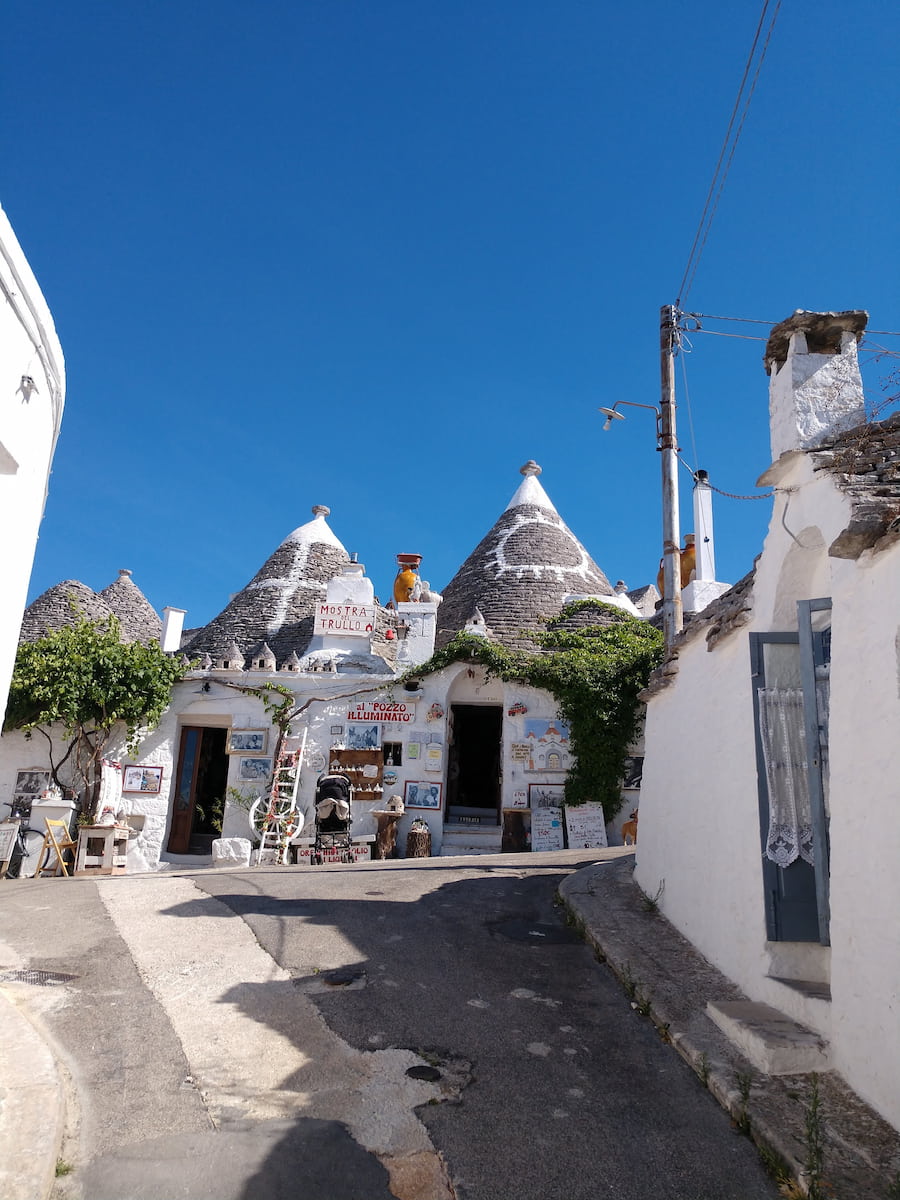
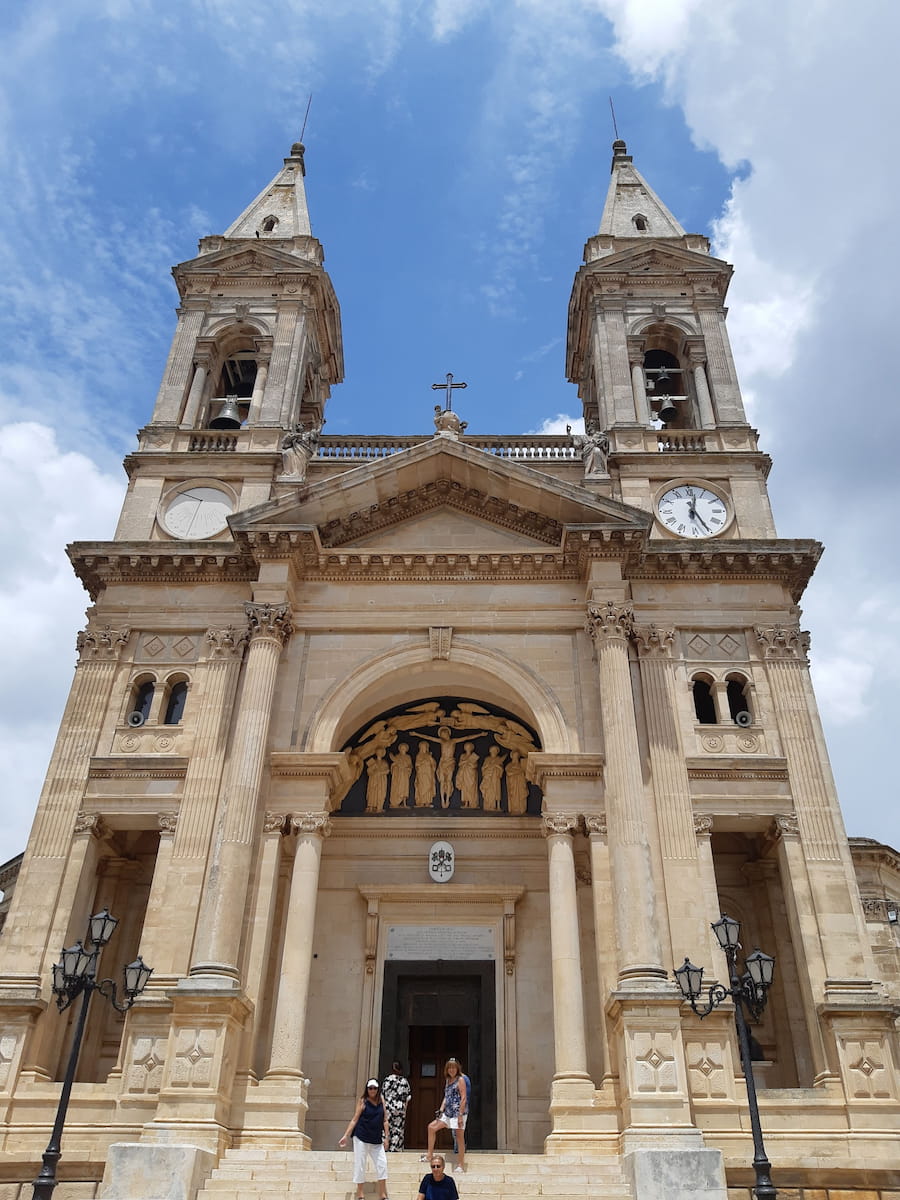
Panoramic views: For a breathtaking view over Alberobello’s rooftops, head to one of the town’s panoramic terraces. These spots provide excellent photo opportunities and a chance to take in the beauty of this unique town from above.
Insider Tip: Alberobello can get crowded by midday, especially during peak tourist season. Arrive early in the morning to explore at your own pace before the crowds arrive.
⭐ Best tour
- Tour of Ostuni, Alberobello, and Polignano – Embark on a full-day tour from Lecce to explore three of Puglia’s most picturesque towns: Ostuni, Alberobello, and Polignano a Mare. Discover the whitewashed streets of Ostuni, the unique trulli houses in Alberobello, and the stunning coastal views of Polignano a Mare.
2. 🌊 Polignano a Mare
Cliffside beauty: Polignano a Mare is known for its dramatic cliffs and crystal-clear waters, making it one of Puglia’s most picturesque coastal towns. Spend your day wandering through its charming old town or relax on Lama Monachile Beach, nestled between towering cliffs.

Adventurous activities: For those seeking adventure, Polignano offers activities like cliff diving (for experienced divers) or boat tours along its rugged coastline. The town is also famous for its seafood restaurants with terraces overlooking the Adriatic Sea.
Top Tip: Visit Polignano in late afternoon or early evening when temperatures cool down and you can enjoy dinner with stunning sunset views over the sea.
⭐ Best tour
- Boat tour of the Polignano a Mare – With this boat tour, admire dramatic grottoes and caverns that are only accessible by sea. Cruise by more than a dozen caves, pausing to snap photos and admire the unique coastal formations. Enjoy a brief stop to swim and a prosecco toast on board.
❓ FAQ
What are the best things to do in Lecce?
Lecce offers plenty of fun things to do, from exploring its historic center to visiting beautiful Baroque churches. One of the best things to do is wander around Piazza Sant’Oronzo, where you can admire the Roman Amphitheatre and the column of Sant’Oronzo. Don’t miss out on visiting Duomo di Lecce and the extravagant Basilica di Santa Croce, both iconic landmarks in the heart of Lecce.
How many days should be spent in Lecce?
Spending at least two or three days in Lecce is ideal to fully explore the historic center of Lecce and its surrounding attractions. This allows time to see highlights like Piazza del Duomo, take a cooking class, and even enjoy day trips to nearby beaches in Puglia or towns like Otranto or Ostuni. Lecce is also a great base for exploring the Salento region of Puglia.
What are some must-see historical attractions in Lecce?
Lecce is synonymous with stunning Baroque architecture and ancient Roman ruins. Key historical attractions include the Roman Amphitheatre, Piazza del Duomo, and Castello Carlo V. For those interested in Jewish history, a visit to the Museo Ebraico di Lecce is highly recommended. These sites offer a glimpse into the rich history of Lecce, from Roman times to the Baroque period.
What are some fun things to do around Lecce?
Around Lecce, there are several fun activities, such as visiting nearby beaches like those in Porto Cesareo or Gallipoli, both considered some of the best beaches in Puglia. You can also take a day trip to explore other charming towns like Ostuni or Alberobello. The region’s mild climate makes it perfect for year-round exploration.
What is the best time to visit Lecce?
The best time to visit Lecce is during spring (April-June) or fall (September-October), when the weather is pleasant, and there are fewer tourists. Summer is also popular due to its proximity to some of the best beaches in Puglia, but it can get quite hot. Winter offers mild temperatures, making it a good time for those who prefer fewer crowds.
How can I reach Lecce?
Lecce is easily accessible by train from major Italian cities like Bari or Brindisi. The nearest airport to Lecce is Brindisi Airport, located about 35 minutes from Lecce by car. There are also frequent buses and trains that depart from Lecce, making it convenient for travelers exploring other parts of southern Italy.
